It seems we can’t find what you’re looking for. Perhaps searching can help.




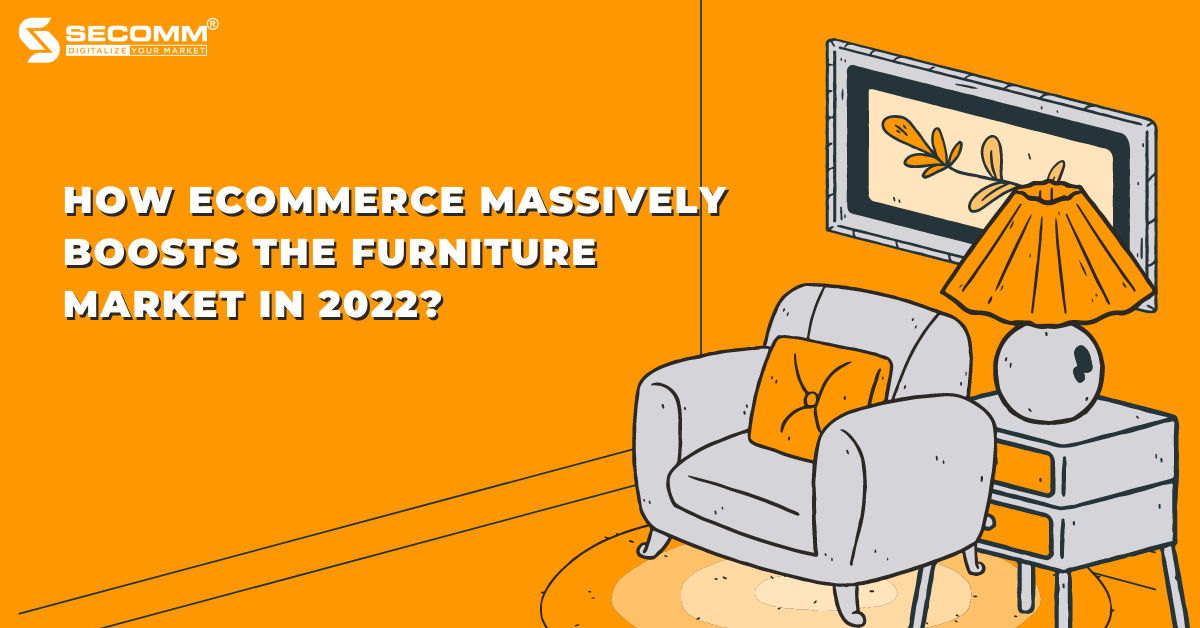
HOW ECOMMERCE MASSIVELY BOOSTS THE FURNITURE MARKET IN 2022?
The desire for home furnishings and design among consumers has significantly increased as life gets better and better. The majority of consumers still prefer to choose and purchase products in physical stores and showrooms, but online furniture shopping is an increasing tendency. Additionally, the impact of the Covid-19 pandemic on consumer purchasing habits has changed how people purchase, which has greatly aided the development of the furniture eCommerce market.
The enormous potential of eCommerce for furniture
BusinessWire estimates that the size of the furniture eCommerce market in 2021 was valued at USD 27.74 billion and that it would increase at a compound annual growth rate (CAGR) of 4.4% from 2022 to 2030 to reach USD 40.74 billion.
Recent findings made by Maddyness include the following intriguing details:
- The value of the worldwide furniture eCommerce market exceeds $200 billion.
- Online sales account for more than 90% of the growth of the furniture industry.
- According to estimates, 8 out of every 10 consumers who purchase furniture have made an internet purchase at least once.
- One in three consumers prefers to buy furniture online.
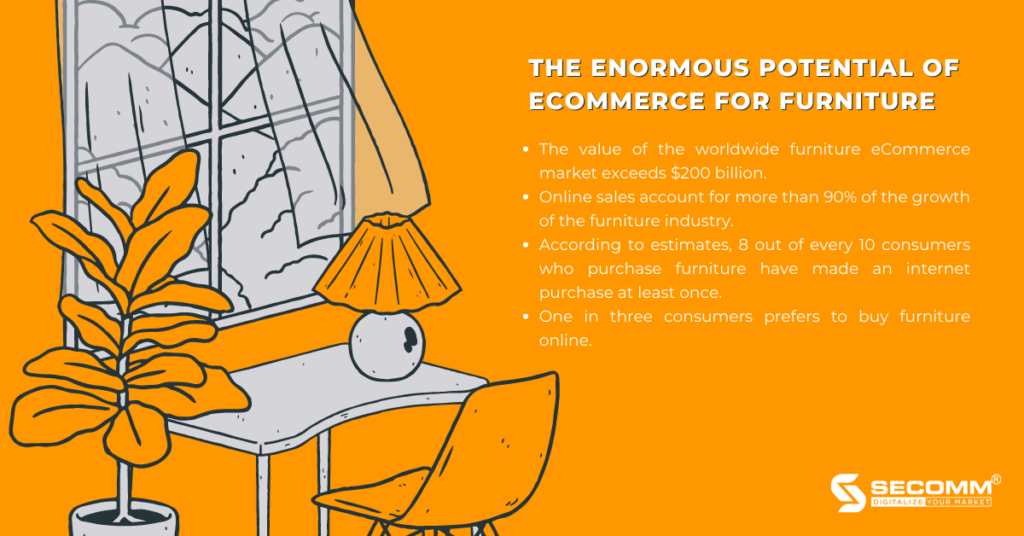
The advantages of eCommerce implementation for the furniture business
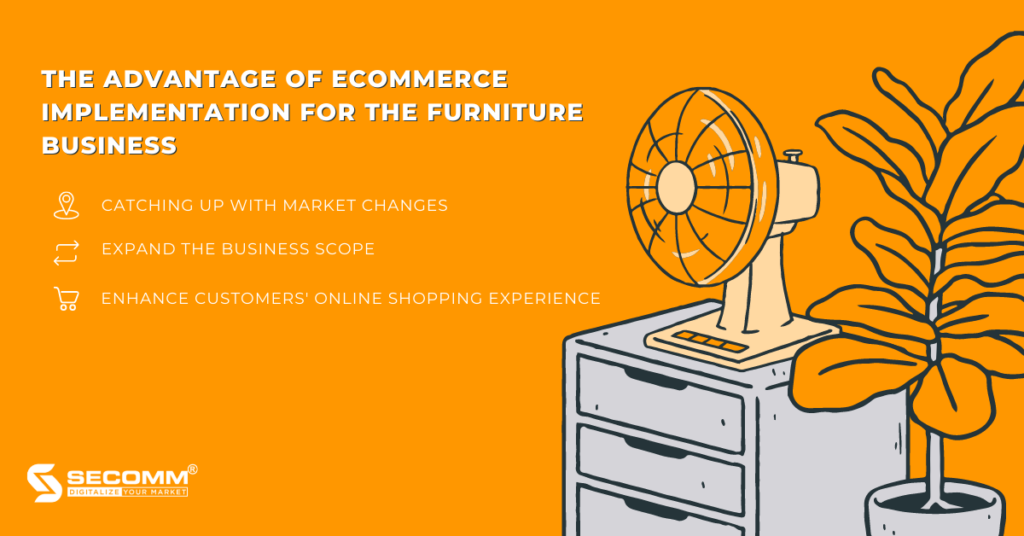
Catching up with market changes
The furniture sector has experienced a significant decrease in sales over the past few pandemic years, along with many other industries.
People are compelled to reduce their social interactions during the social withdrawal period. They now spend more time working, living, entertaining, and teaching at home. In light of the unpredictable changes of the pandemic, the necessity to clean and renovate the dwelling has therefore substantially increased.
Due to limits on leaving the house, online shopping at the time had become not only a need but also an urgent method of purchasing in place of in-person purchases. That serves as the springboard that gives eCommerce its spectacular development and propels it into other industries like fashion, grocery, wine, and even furniture.
These two elements highlight the “cake’s” enormous potential and aid many furniture companies in realizing and swiftly implementing eCommerce for market revolution and sustainable development.
Expand the business scope
Due to the Internet’s rapid expansion and the burgeoning online shopping trend, which is gradually replacing traditional offline shopping, the adoption of eCommerce will benefit furniture manufacturers by providing a new sales channel and attracting a big number of potential clients (at stores, and showrooms).
eCommerce implementation will also help to broaden the market for businesses by improving the circumstances for marketing campaigns to be more successful.
Enhance customers’ online shopping experience
When firms use technology to improve customer experience in eCommerce, furniture shopping will happen more quickly.
In the digital age, for instance, visual experiences from VR/AR technology, 3D product visualization, and 360-degree photography are very popular, gradually replacing in-store shopping while still being fully informed and realistic visualization of products, thereby increasing customer satisfaction during online shopping.
eCommerce enables businesses to quickly and effortlessly tailor the experience for customers by gathering, evaluating, and synthesizing the consumption behavior of each target group. Typically, this is done with the capabilities listed below: Products have seen, similar product recommendations, etc.
eCommerce provides clients with a seamless experience in addition to an intuitive one across a variety of channels, including social networks (Facebook, Instagram, Tiktok, Zalo, etc.), eCommerce platforms (Shopee, Lazada, Tiki, Sendo, etc.), eCommerce websites, mobile apps, etc.
The interesting story of big guys
IKEA – The iconic furniture retailer, enters eCommerce to boost online sales
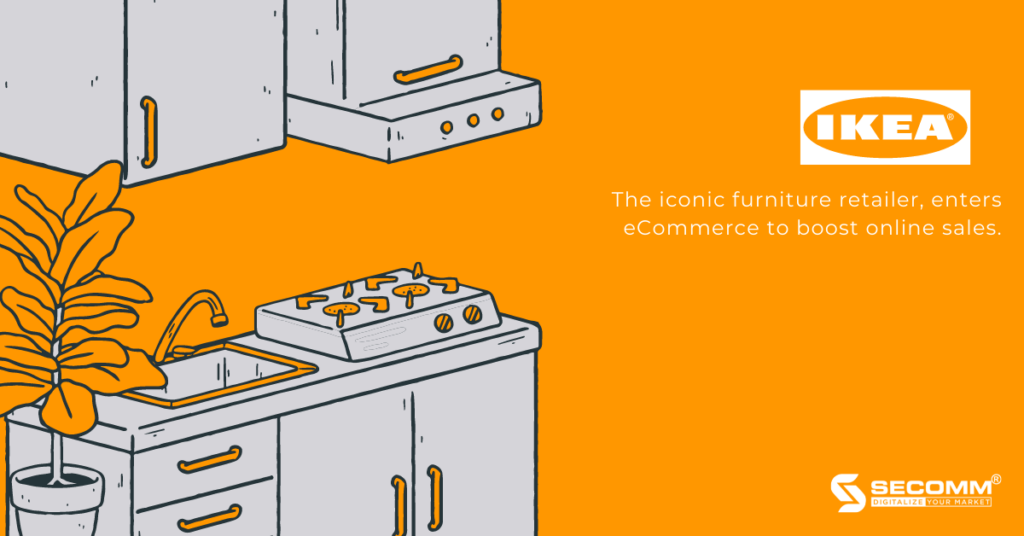
IKEA, or Ingvar Kamprad Elmtaryd Agunnaryd, is the world’s largest furniture retail enterprise and specializes in delivering minimalist-styled assembled furniture, household appliances, and accessories.
IKEA was established in 1943 in Sweden by Ingvar Kamprad, who started his business at the age of 17. IKEA swiftly gained global dominance with 392 locations across 48 nations.
With the goal of offering furniture with a lovely style and wide application while keeping the price low so that as many people as possible can purchase the goods. The majority of the departments, from marketing and sales to supply chain and warehouse, share this goal.
Everybody works together to keep IKEA’s “vital” competitive edge intact so that the company can publish catalogs with thousands of products offered at long-term stable prices.
Despite being the largest furniture retailer in the world, IKEA has lagged behind eCommerce trends, according to the Financial Times. This well-known retailer started “renovating” its sales technique only when it encountered numerous internet rivals.
The biggest barrier that makes it difficult for IKEA to adjust its previously successful business model is the maze-like arrangement of store layouts to create an engaging experience of sightseeing, interior shopping, or requiring customers to drive to the store and assemble the components to make their own furniture.
But IKEA has unimaginably succeeded in launching an e-commerce website by fusing cutting-edge technology with a well-organized marketing plan. In particular, IKEA specifically uses VR/AR technology, which is seen as a new eCommerce trend and is favored by many firms, to improve users’ online purchasing experiences.
IKEA thereby covers the sales void left by the prior on-site furniture business model, but the gap won’t truly be felt until the Covid-19 pandemic and social separation restrictions are in place.
From this point, IKEA expands its consumer base both online and offline, and sales are progressively encouraged to increase significantly.
Additionally, IKEA’s eCommerce website incorporates Instagram posts of photographs of IKEA furniture goods that consumers customize, share, and tag with the hashtag #IKEA.
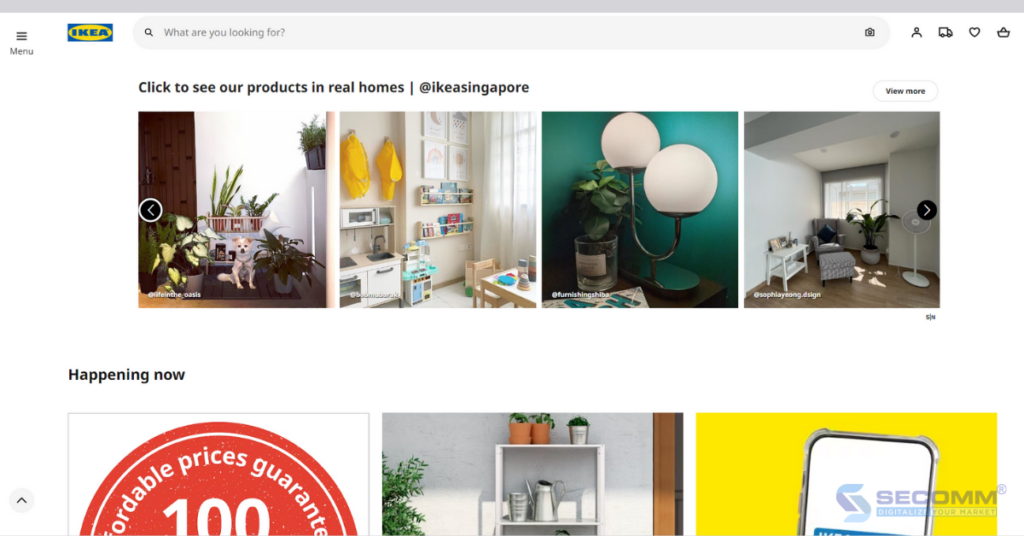
This not only helps this brand connect closely with Instagram users, increase its reputation and strengthen the loyalty of existing customers but above all, quick access to a large diverse customer base from the Internet in general and Instagram in particular thanks to the popularity and influence of this social network on young consumers.
Nha Xinh – The veteran warrior in furniture eCommerce

Established in 1999, Nha Xinh is a well-known furniture brand in Vietnam. It has two sizable showrooms, one each in Hanoi and Ho Chi Minh City.
As a manufacturer and supplier of living room, bedroom, dining room, and kitchen furniture with an Asian design aesthetic that favors coziness, friendliness, and simplicity above sophistication and luxury, Nha Xinh is a specialist in this field.
Nha Xinh’s website belonged to the “long-lived” row in the Vietnamese eCommerce village when it was created and launched in 2007, a period in which Vietnam was still getting used to utilizing the Internet to progressively integrate with the rest of the world.

Nha Xinh’s eCommerce website has survived many years of market ups and downs while maintaining its inherent simplicity, intimacy, and sophistication.
Product categories are arranged clearly and harmoniously in each room to make it easy for customers to search, choose products that suit their needs, and get a sense of the room’s overall layout.
Customers can choose from a variety of options because the room’s layout is available with furniture and includes a detailed price. If they prefer, they can even select a combination of the interior and decor of the room without having to spend a lot of time figuring out how to combine each item because Nha Xinh already did it.
Additionally, Nha Xinh’s website has a unique section called “360-degree store” that uses 360-degree technology to let customers view the company’s interior products from a distance in an accurate manner from every nook and cranny of the room and every angle of the product, along with comprehensive information and price lists for each item.
Additionally, Nha Xinh’s “Inspiration Corner” catalog offers a wealth of thoughts and ideas to assist clients in designing their dream living space. Nha Xinh gives home design recommendations in a variety of styles, from elegant, and gentle to strong and personable depending on the individual’s preferences.
Therefore, Nha Xinh is more than just an eCommerce site that sells furniture; it is also a handbook that provides customers with never-ending design ideas.
Noi That Hoa Phat – The giant is committed to winning the eCommerce race

Hoa Phat Furniture was founded in 1995 and over the course of over three decades has made a positive impact on Vietnamese consumers’ perceptions of quality products and exquisite design while fulfilling a variety of needs for office furniture, home, household furniture, and medical furniture.
With a consistent growth rate of 20–25% each year, the brand is getting stronger and reaffirming its position as Vietnam’s top supplier and manufacturer of furniture.
When Hoa Phat Furniture changed its name to The One Furniture in the year 2022, it left a lasting impression on the industry. The brand name change is linked to adaptable changes in strategy. The company focuses on enhancing the stature, appearance, and image connected with the growth of the nation, helping to instill a variety of ideals into society.
Hoa Phat Furniture (now The One Furniture) invests extensively in technology infrastructure to streamline the production and supply process at the same time as it aspires to expand throughout the area and the world. One might say that The One Furniture has carried on the brand’s good core principles and improved upon them in order to better suit the current market trend.
One of Hoa Phat Furniture’s greatest successes to date is the effective use of 3D printing technology in production, which has helped the company create a number of new products like the Smart Safe; sofa and chair folding in the Italian style while also reducing production costs and speeding up prototyping and increasing product accuracy.
Hoa Phat Furniture concentrates on creating an eCommerce website to reach many potential clients that have a habit or preference for online buying, in addition to being adaptable and prompt with changes in strategy.
The firm creates websites using the WooCommerce framework, a well-known and dependable open-source platform used by many companies to implement eCommerce.
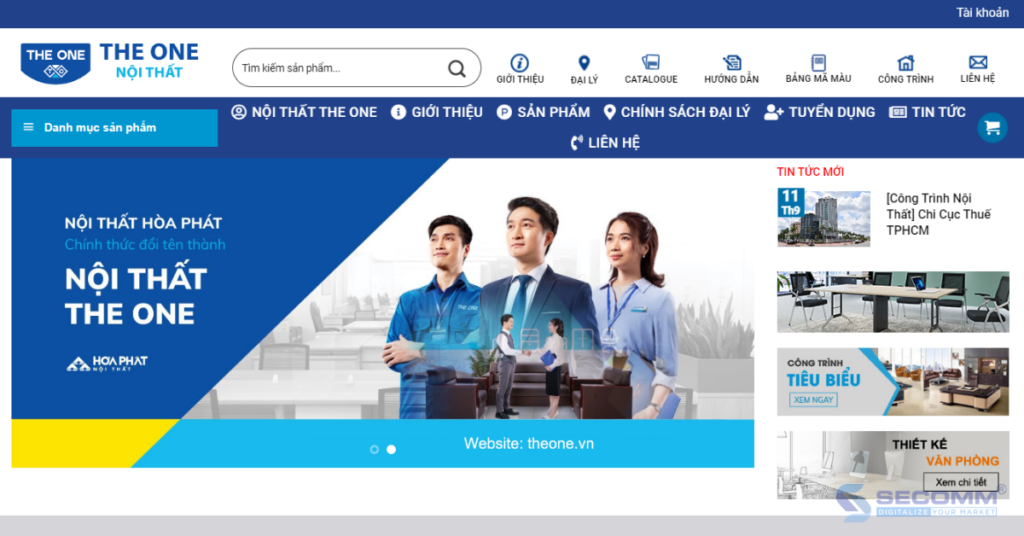
Compared to the previous version of Hoa Phat Furniture, The One Furniture’s new website (noithattheone.com.vn) features a more simplified, gorgeous, and contemporary interface (noithathoaphat.com.vn).
Additionally, the business supports the growth of well-known social media platforms like Facebook, Instagram, Youtube, and TikTok to broaden brand awareness, attract more customers, and enhance coverage.
Plus, the business offers a wide range of shipping and payment choices to accommodate the various needs of clients, making online buying at The One Furniture or Hoa Phat Furniture as convenient as it can be.
It is clear that the growth of the furniture market has been hastened by the speed at which eCommerce is developing.
Today, numerous local and international furniture companies participate in and offer the greatest shopping experiences to customers through the effective implementation of an eCommerce website, including IKEA (Sweden), Nha Xinh, and Hoa Phat Furniture (Vietnam).
From there, companies may quickly connect with a wider pool of Internet users and generate conversions through efficient marketing strategies.
However, business leaders need to carefully and comprehensively take into account the growing customer expectations and rapidly shifting market trends, not to mention specifically describe a systematic and precise business strategy for taking the most advantageous actions in the short and long term.
Completing that difficult task will take a lot of time and resources. As a result, many furniture companies opt for a more straightforward approach to the issue, enlisting the assistance of a highly qualified and dependable unit.
SECOMM has many years of expertise in effectively executing eCommerce for numerous customers in various countries. We specialize in offering free consultation services with qualified eCommerce implementation solutions.
Contact us right away for free counsel and assistance.
 2
2

 2,484
2,484

 0
0

 1
1
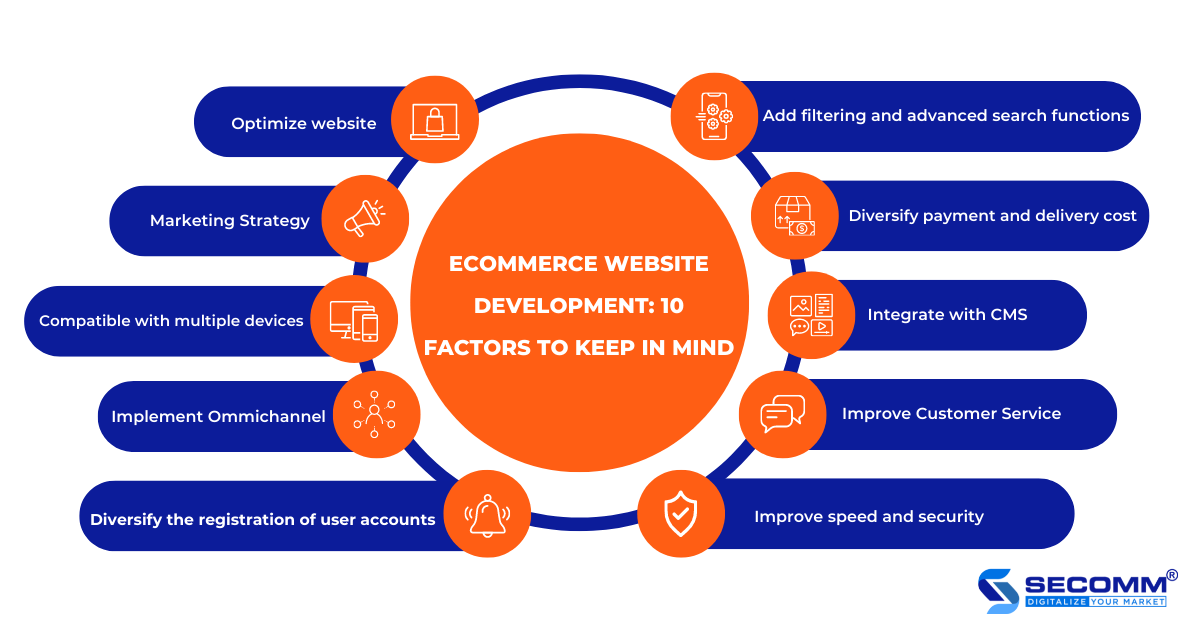
ECOMMERCE WEBSITE DEVELOPMENT: 10 FACTORS TO KEEP IN MIND
Creating an eCommerce website is a critical step in assisting businesses in spreading their brands and increasing their ability to reach potential customers on the Internet, thereby increasing revenue and profit. However, developing a business website is a complicated process with many aspects, particularly with eCommerce websites.
Businesses must consider everything from user experience to operational performance and many other aspects of the site. Here is a summary of the key factors of an eCommerce website that businesses and website developers should consider before getting started.
SEO and website performance optimization
According to Think with Google research, if a web page takes up to 5 seconds to load, the likelihood of a user exiting increases by 90%. As a result, businesses must prioritize optimization and ensure that their eCommerce website is always operational.
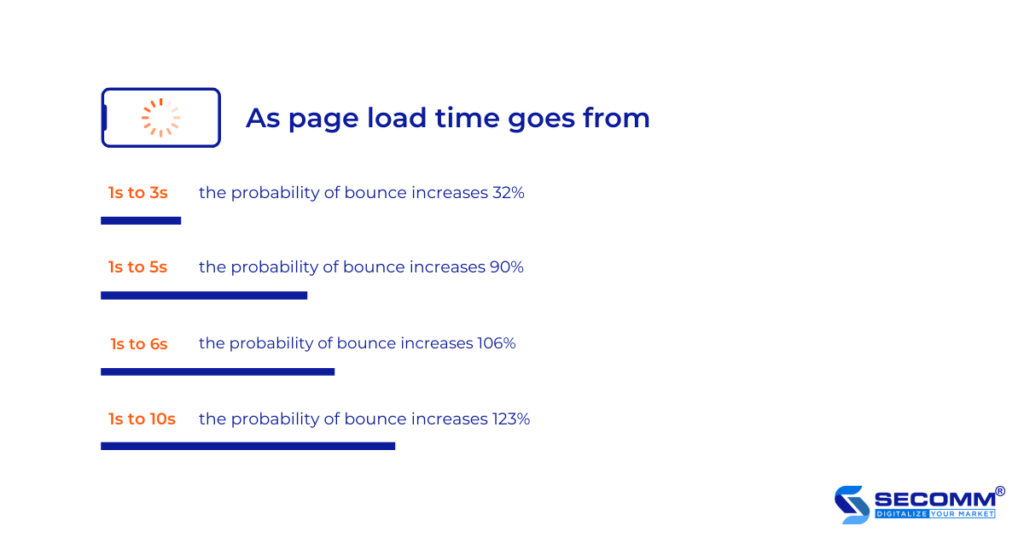
Furthermore, businesses must pay attention to optimizing SEO so that the website has the highest possible ranking on search engines using specific techniques and strategies if they want to maximize revenue on their brand websites. One of them is the strategy of incorporating keywords into the eCommerce website’s content, as well as description, title, and image information.
When adding an “alt text” description to an image, many businesses forget that customers can find their website through image search. This is also a significant flaw that results in a significant loss of potential customers.
Furthermore, in the early stages of e-commerce website deployment, businesses should consider hiring SEO experts. They can launch the website with the necessary meta tags, organize the page structure and internal links, create content strategies, design recommendations for cross-device-friendly functionality, improve page load speed, and many other critical aspects.
Marketing strategy fulfillment
A good marketing strategy may benefit the first orders offline and online, particularly in eCommerce. Creating an early marketing strategy assists businesses in identifying the features that must be included in developing eCommerce systems.
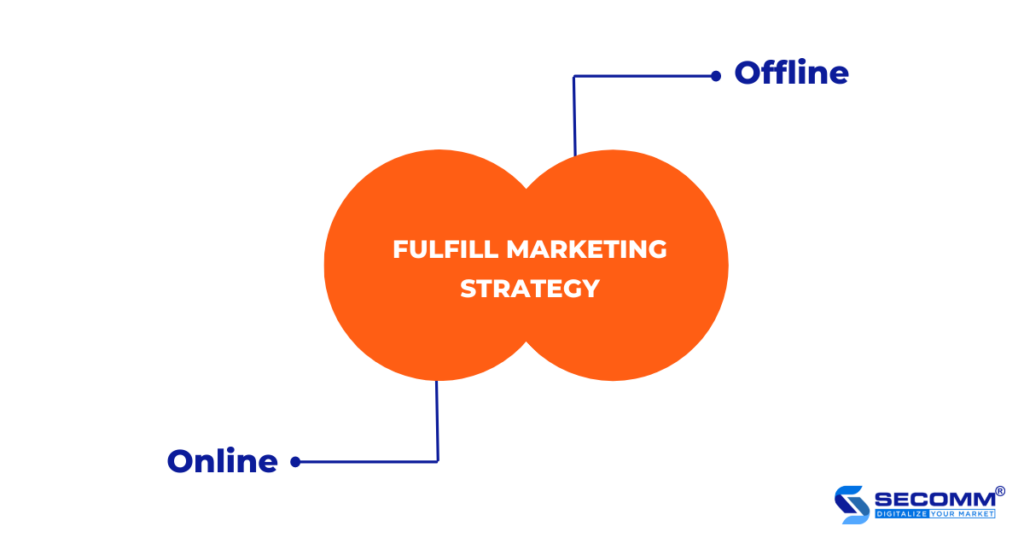
For example, when businesses want to add the option to share a promotion campaign to social networks or push notifications on mobile apps from an eCommerce website, it will be more effective if this is part of the Marketing strategy and is planned to be implemented during the development of the eCommerce website rather than proposed to be developed after the website has been launched.
Multi-devices compatible website
According to the World Bank, two-thirds of adults worldwide use digital payments, with this figure expected to rise from 35% in 2014 to 57% by 2021. Although users prefer to make purchases via mobile apps, businesses can still increase conversions if the eCommerce interface is easily adaptable to the mobile web.
For example, after releasing a more optimized responsive design, Walmart Canada successfully increased website conversions by 20% and improved mobile order growth by 98%.
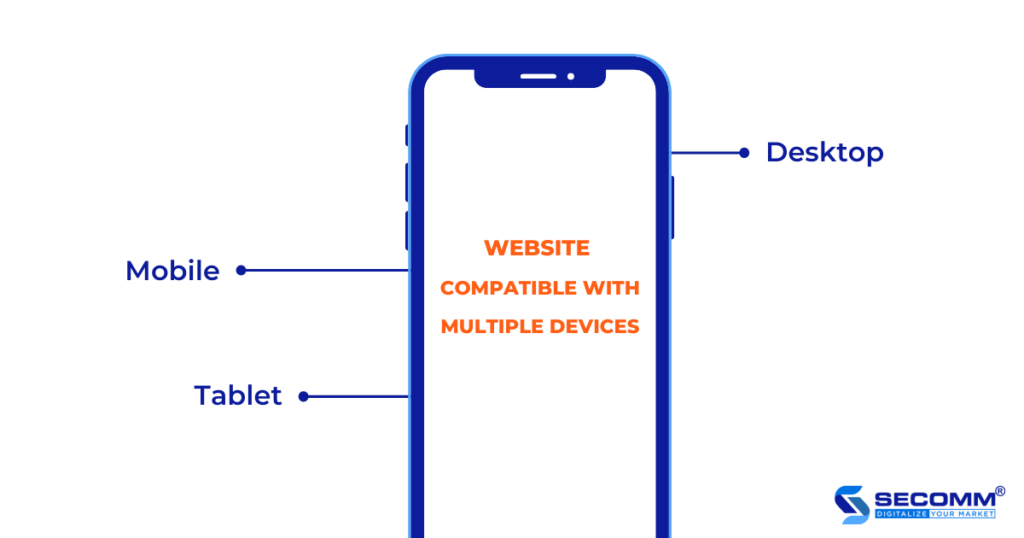
Furthermore, businesses must ensure that customers from all over the world can easily access and shop on their eCommerce website using any available browser.
As a result, businesses will conduct cross-browser testing using Google Chrome, Internet Explorer, Firefox, Opera, Safari, and other browsers to find and fix errors, ensuring customers have a great shopping experience on your website using any browser, any device, and anywhere. Businesses can hire a qualified third party to assist them, or they can conduct their own testing using a few available help tools.
Implement Omnichannel
In the digital age, “Omnichannel” is becoming increasingly popular and is an essential communication strategy between businesses and their customers. Every business should adopt an omnichannel strategy to connect with customers, increase traffic, drive sales, and survive the changes of the times.
As a result, implementing Omnichannel enables businesses to synchronize all sales channels for easier data management and increased eCommerce business efficiency. At the same time, Omnichannel provides customers with a seamless experience, allowing businesses to sell omnichannel and increase conversion rates.
When implementing Omnichannel, businesses can use Omnichannel platforms and systems (ETP Group, NEF, GoSELL) or choose one system as the data center for the entire system, such as an eCommerce system (Magento), ERP (Odoo, SAP).
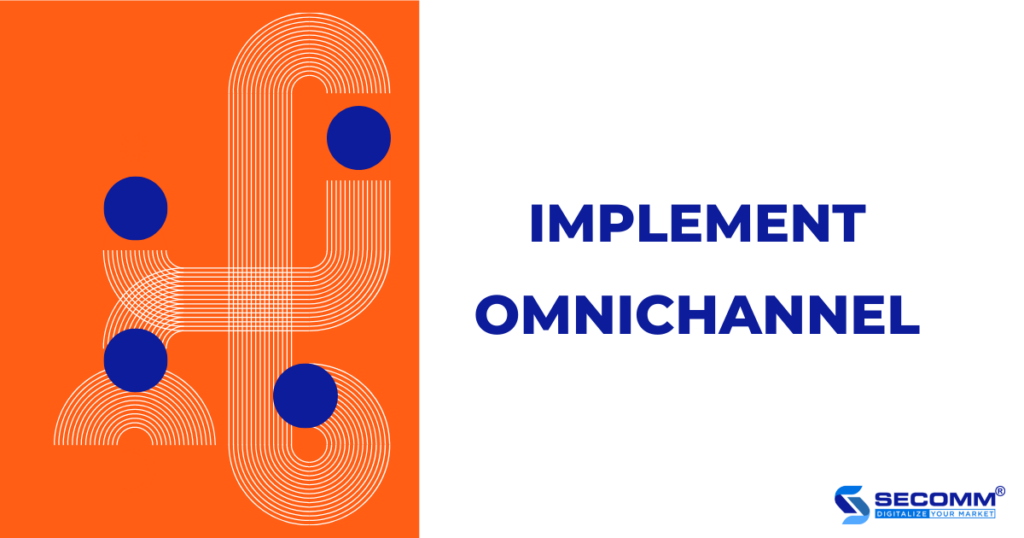
Omnichannel implementation process:
- Step 1: Data collection: Customers, Sales (Sales), Marketing,…
- Step 2: Analyze data to identify issues for improvement to implement Omnichannel effectively.
- Step 3: Create customer journeys and align campaign messages across sales channels.
- Step 4: Check, evaluate and optimize Omnichannel
Diversify the registration of user accounts
Most eCommerce websites require customers to create an account before making a purchase. This allows businesses to store the customer’s purchase history, delivery address for demographic analysis, purchase behavior assessment, sales analysis, and incentive to buy next time through Marketing campaigns.
Regular customers, in particular, will be willing to do this to reap the benefits of having an account on the website, such as quickly saving information for the next purchase or receiving notifications about upcoming big promotions. However, not all customers want to register for an account to purchase products.
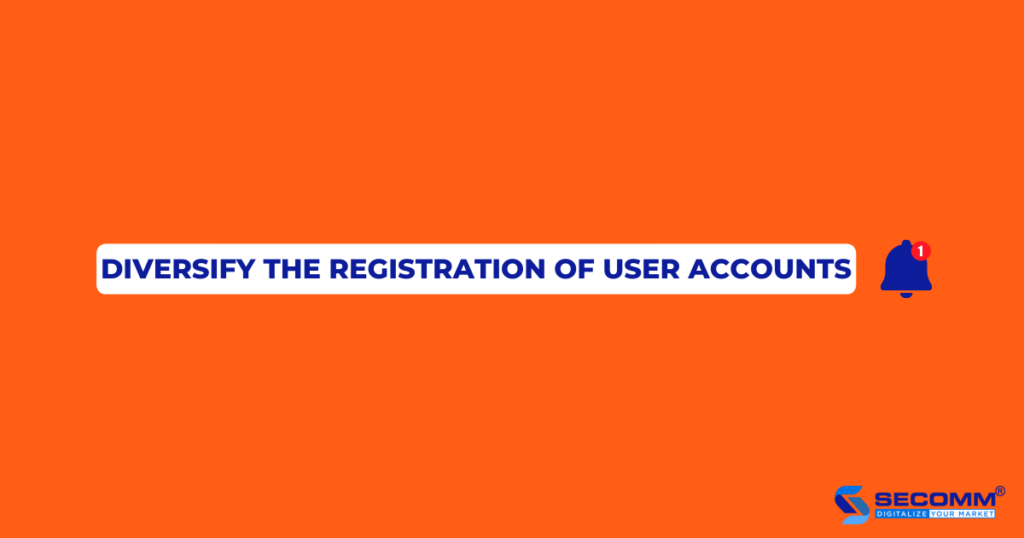
Therefore, businesses must provide options for customers who want to buy goods without registering an account, such as requiring customers to log in with a social network account or fill out a small payment form with their name, email, phone number, and address to complete the purchase process.
The eCommerce website system will automatically create an account and submit guest email login information in both cases.
Add filtering and advanced search functions to the website.
Even on websites that do not sell anything, users frequently use the search bar. For businesses with eCommerce websites, the search bar must provide advanced search functionality.
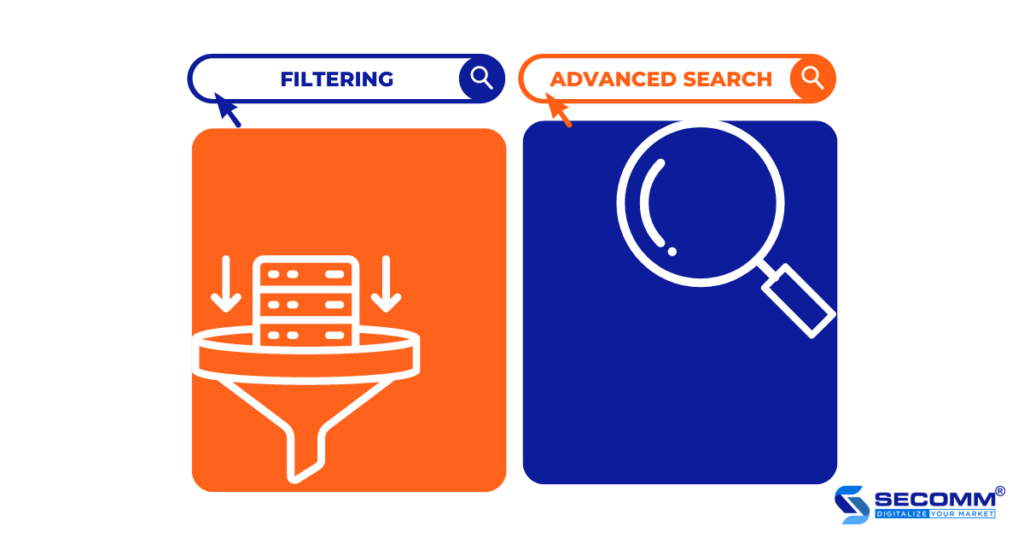
The image search feature, for example, allows users to upload a photo of a favorite item and have the eCommerce website’s search engine return products that are the same, nearly identical, or similar to the product the customers are looking for.
If users don’t know what to look for and need some suggestions, they should browse the website’s product categories. In these cases, the multi-layered product catalog function is extremely useful. In other cases, customers already have search objectives; a search bar with advanced support functions will also assist customers in finding the products they require with a few clicks.
Diversify payment methods and delivery costs
Because online shopping and payments are becoming incredibly popular, it is critical to provide the appropriate payment options when developing an eCommerce website. According to the Payment Methods Report 2019, many shoppers abandon shopping carts because of delivery costs (55%) and complicated checkout processes (26%).
As a result, depending on the product and market that the company is targeting, the company will select a payment method that is appropriate for customers, products, and regions. The most popular payment methods in North America, according to Hostgator, are PayPal, Amazon Pay, Google Pay, Apple Pay, Visa or MasterCard, and so on.
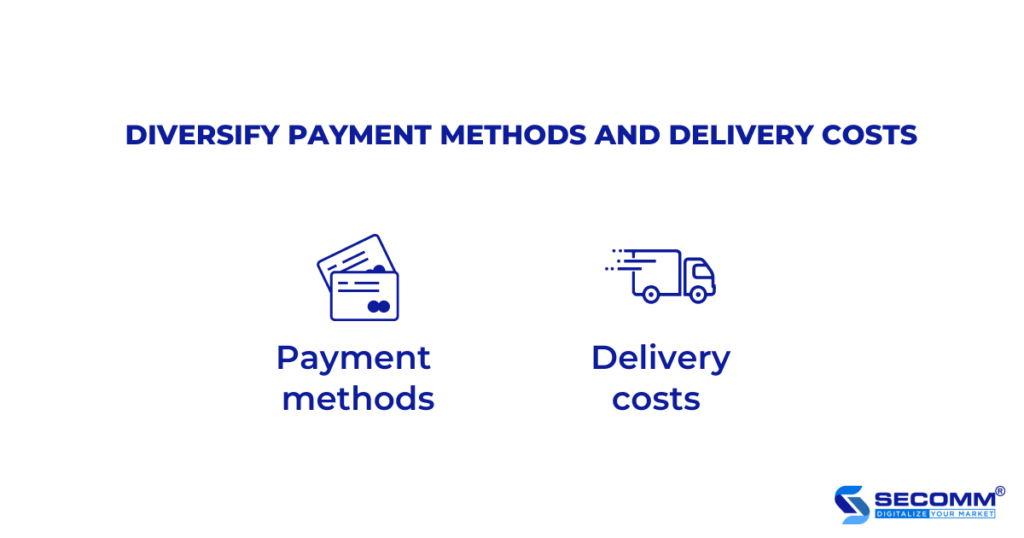
MoMo, Zalo Pay, Shopee Pay, Visa or MasterCard, and others will be particularly popular in the Vietnam market.
Furthermore, businesses should consider delivery costs because this is one of the primary reasons why customers abandon the purchasing process. Businesses can deploy flexible free shipping offers on special promotions, or if customers are required to pay shipping fees, the system should provide detailed information to avoid confusion and create a bad customer experience.
Integrate with the content management system
A content management system (CMS) allows you to centrally store and manage your written, visual, and document content. Businesses can change or add information, and the changes will be reflected on the eCommerce website. CMS can also help staff respond more quickly to customer feedback.
Improve customer service
Most Internet shoppers are Millennials, Gen Y, and Gen Z. These generations value personalization, such as personalized recommendations, recommendations, or solutions from the support team.
Many eCommerce businesses are trying to meet this, the customer care department will help buyers solve problems during the purchase, payment, delivery, returns, complaints, and so on.
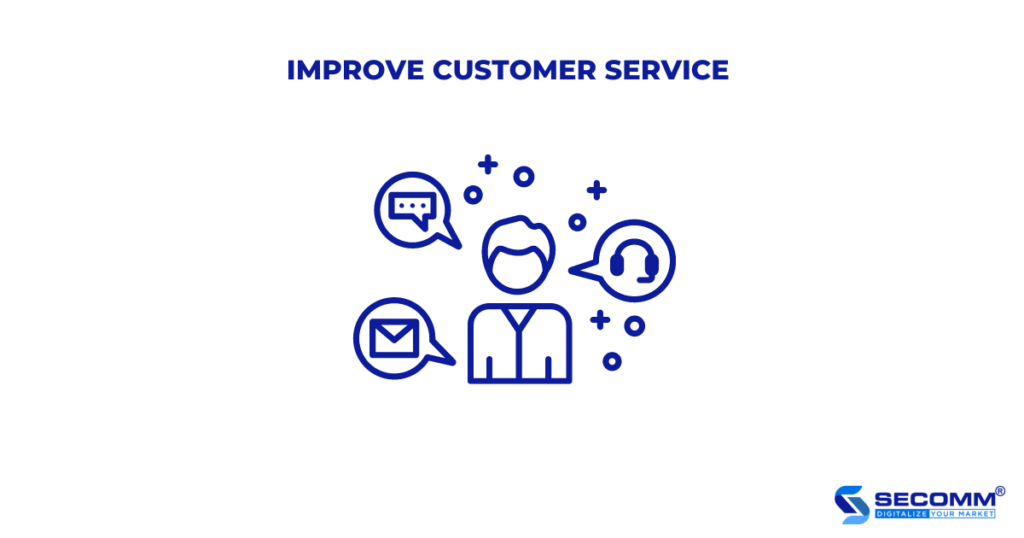
Furthermore, businesses should add a contact section to their eCommerce website with a hotline number or email that can be easily clicked or linked to the Facebook Messenger application, Zalo, live chat for orders, and general support chat for those who prefer this method of communication.
Improve the eCommerce website’s safety and security
Businesses will be responsible for storing large amounts of user data and product information on an eCommerce website, so safety and security are the most important factors for any eCommerce website. Any negligence can put the company in danger of permanent data loss, and customer information can be stolen and sold.
Google and other search engines will flag an eCommerce website if it is deemed unsafe and has poor security, such as no SSL certificate and HTTPS protocol. This is considered a warning or recommendation for Internet users to be cautious about accessing websites that lack the above two components, as a result of which businesses will easily lose a large number of potential orders, causing marketing disruption and affecting the brand’s reputation.
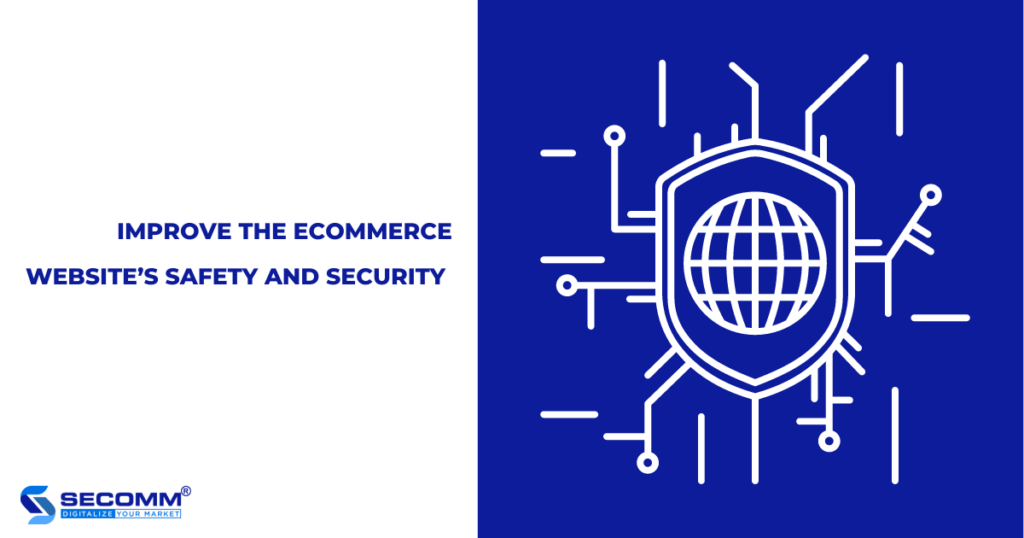
Furthermore, businesses must register an eCommerce website with the Ministry of Industry and Trade at the eCommerce Management Portal to demonstrate the website’s transparency following Vietnamese Government Decree 52/2013 ND-CP.
The 10 essential factors listed above are those that businesses must consider when implementing eCommerce. In reality, even when businesses use WordPress, the Woocommerce plugin, or a SaaS platform like Shopify, it is not easy to create an eCommerce website with full features that work well to attract customers. If your business decides to hire a website development company, that company must be capable of creating a comprehensive eCommerce website in terms of both design and functionality.
With many years of experience implementing eCommerce in many countries, SECOMM provides free consulting services with professional eCommerce solutions.
Contact us today for free support and advice!
 2
2

 2,872
2,872

 0
0

 1
1
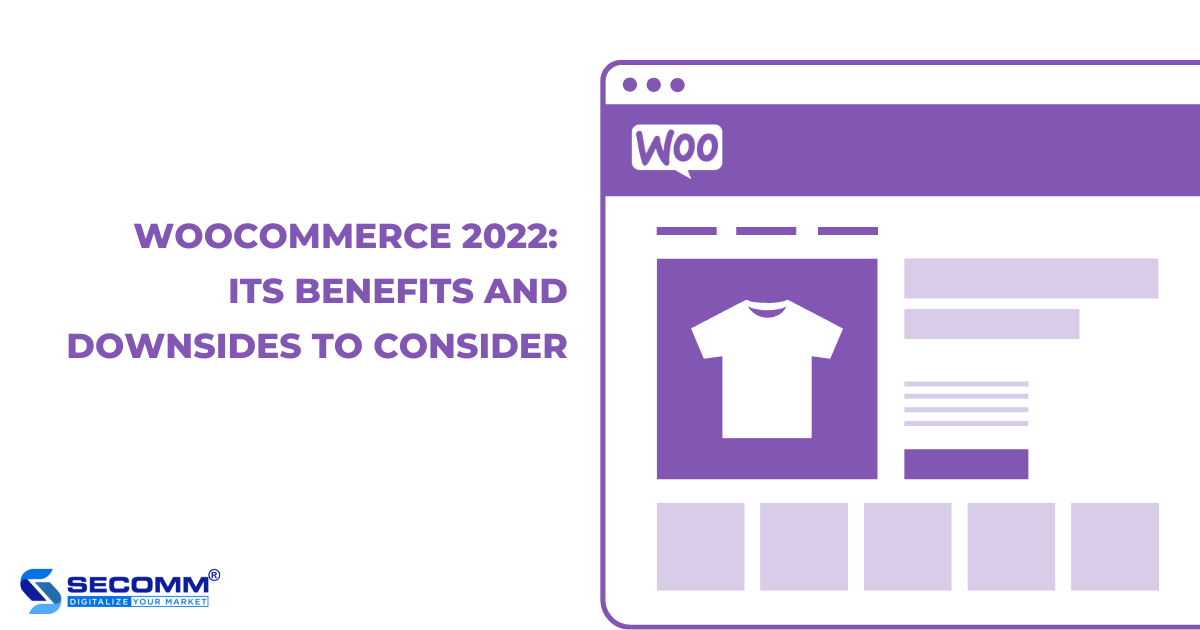
WHAT IS WOOCOMMERCE? 8 KEY PROS AND CONS OF WOOCOMMERCE
As eCommerce becomes a new trend that encourages a slew of brands to enter the market, selecting the right eCommerce platform to build a successful eCommerce website becomes critical. While Shopify is the most popular SaaS platform, Magento is the top choice in the open-source platform, and the WooCommerce plugin has won the trust of many brands due to its outstanding features and ease of use.
What is WooCommerce?
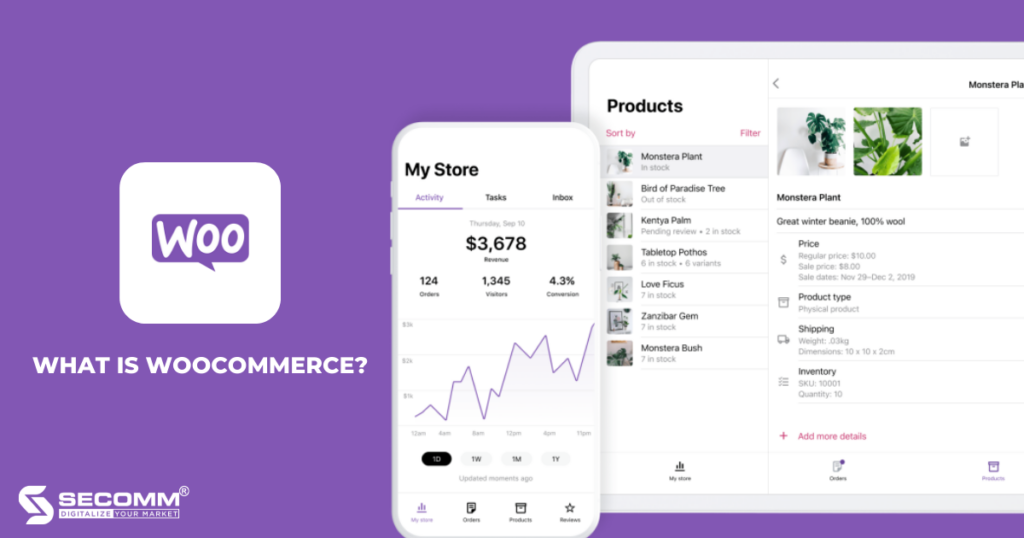
WooCommerce is a free WordPress plugin that allows brands to set up an eCommerce website by adding eCommerce functionality to an existing WordPress site. This plugin can transform a regular WordPress website into an eCommerce website with all the necessary features and easy customization with just a few clicks.
The benefits of using WooCommerce
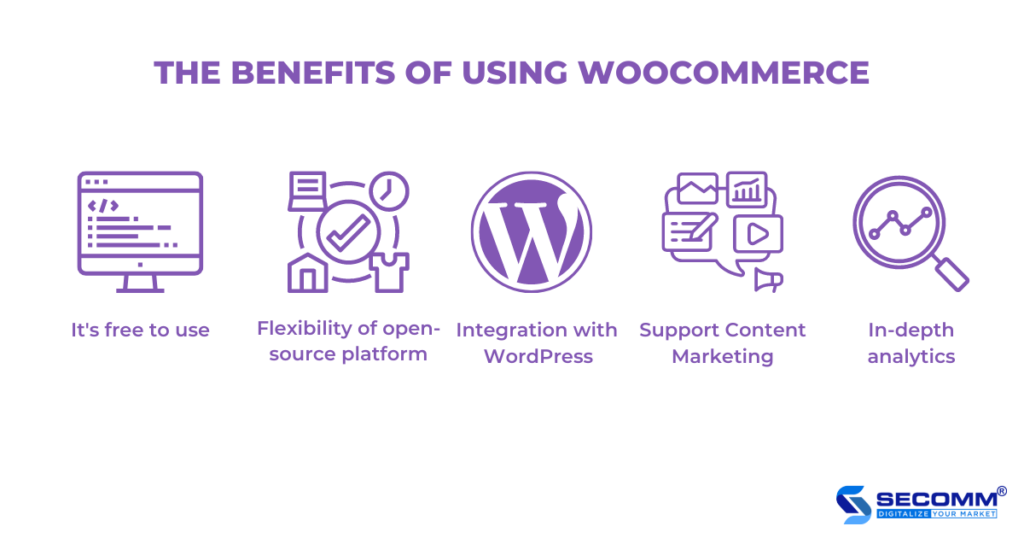
It’s free to get started
Price is an essential factor to think about when selecting a platform for implementing eCommerce. Popular platforms on the market today have prices ranging from free to several thousand dollars per year, making it even more prominent and preferred by businesses because this plugin is entirely free to download and install.
As a result, any business can benefit from its features without committing to costly support contracts or software licenses.
The flexibility of the open-source platform
It is an open-source plugin built on the WordPress CMS that gives users complete control and allows them to easily customize their eCommerce website to their specific needs. WooCommerce, in addition to being suitable for a variety of businesses serving different customer segments, also provides long-term scalability, giving businesses of all sizes more flexibility in deploying eCommerce.
Integration with WordPress
The seamless integration between WooCommerce and WordPress brings many benefits to this plugin because of the availability of the large WordPress community throughout the years. WooCommerce can take advantage of the platform’s massive ecosystem of plugins, themes, guides, and other unique features.
Yoast SEO, for example, has long been a well-liked plugin with numerous international translations, ease of use, and advanced SEO support. Since WooCommerce integrates with WordPress, Yoast SEO also integrates with WooCommerce.
Especially when a business has a website on the WordPress platform and needs to turn it into an eCommerce website, WooCommerce will make it easy and seamless, so users do not have to start over with a brand new platform.
Providing qualified-standard content management
Content Marketing is the key to an effective eCommerce website. If businesses are looking for an eCommerce platform built on the world’s most popular content management system (CMS), WooCommerce can fulfill that expectation.
When the WooCommerce plugin is integrated into WordPress, many content management options, including Blogs, Landing Pages, Product Descriptions, Email Marketing, and SEO plugins (Yoast WooCommerce SEO), will help sellers optimize content for search.
Providing in-depth analytics
Integrated analytics is another advantage of the plugin because the more you learn about customers and how they interact with your eCommerce website, the more you can adjust to meet customer expectations. For example, businesses can use sales data to learn about customers, thereby establishing a customer persona to increase sales in the future.
Furthermore, it provides a comprehensive WooCommerce analyzer displayed in a clean and user-friendly interface. Businesses can then easily integrate WooCommerce with third-party analytics services such as Google Analytics, Google Tag Manager, and others.
The downsides of using WooCommerce
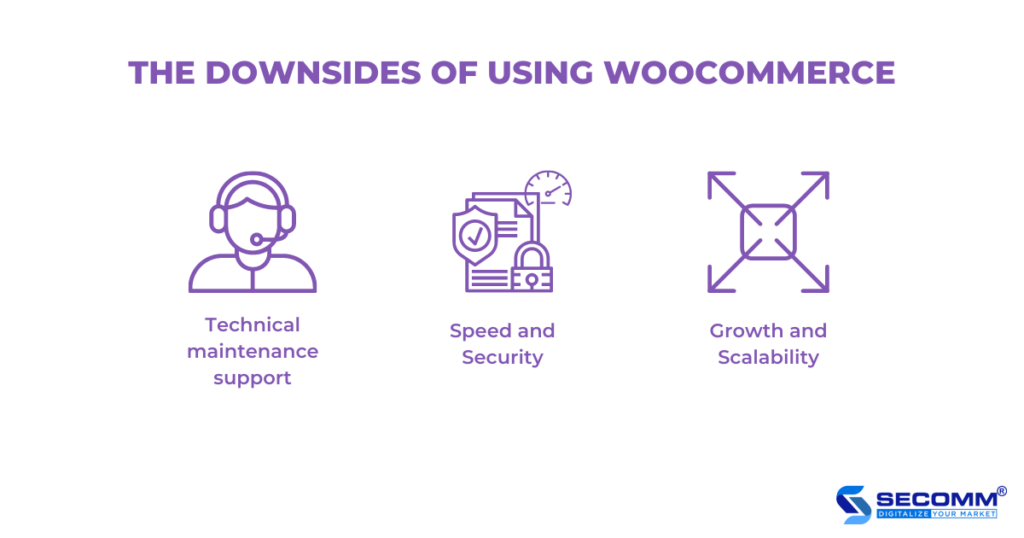
Technical maintenance support
When using this plugin, the user is responsible for keeping the eCommerce website up-to-date, accessible, and functional. In fact, there is some support from the hosting company and the WooCommerce community, but it does not allow users to simply call for technical assistance.
Plugins will notify users of security updates, but users must install and handle problems themselves. In fact, hosting companies will support this. Still, users need to have a bit of technical knowledge to facilitate the process of supporting related issues to avoid affecting the performance of the eCommerce website.
This disadvantage stems directly from the fact that businesses have complete control over the eCommerce website system’s source code and data. Maximum authority entails maximum accountability. Although businesses continue to receive support for WooCommerce issues, compared to other eCommerce platforms such as Shopify, BigCommerce, Magento, etc., WooCommerce still has many shortcomings in the technical maintenance support process.
Speed and Security
With the constant increase in unauthorized access (Website Hacking), website speed and security are more critical than ever. Speed and security are significant advantages for SaaS platforms such as Shopify and BigCommerce. At that point, your eCommerce website is housed in the infrastructure of these platforms, and a team of technical experts will continuously monitor and resolve any issues that arise to keep the website running smoothly.
Similar to a technical maintenance situation, WooCommerce essentially leaves the user responsible for the speed and security of the website despite the wide range of 3rd party support options.
Although speed and security are not an issue for some new businesses deploying eCommerce websites, this is still a significant drawback of this plugin when businesses are responsible for many issues ranging from technical maintenance to website speed and security, especially if the eCommerce site is on the verge of rapidly growing from hundreds to thousands of hits.
Growth and Scalability
Because it is a WordPress plugin, it will operate in accordance with WordPress functions. Meanwhile, WordPress functionality is not explicitly designed for eCommerce but rather is based on the flexibility of open-source code. This means that when a user exceeds a certain query threshold, the way WooCommerce works is broken.
For example, when a large number of shopping carts are added, or checkout occurs at the same time, or when too many users visit the website simultaneously, overload occurs, making the operation of the eCommerce website difficult. This is difficult because the WordPress system and the WooCommerce plugin are no longer compatible.
If your eCommerce website is still small and growing, this is not a problem; problems can still be quickly resolved. However, as the size of your website expands and grows rapidly, this is a disadvantage in terms of both performance and cost that businesses must consider before proceeding.
In a nutshell, WooCommerce is a fantastic plugin that many businesses would love to choose when deploying an eCommerce website. However, besides the outstanding advantages, there are still certain downsides, so businesses must carefully consider and compare with other platforms before starting out.
With many years of experience implementing eCommerce in many countries, SECOMM provides free consulting services with professional eCommerce solutions.
Contact us today for free support and advice!
 2
2

 2,311
2,311

 1
1

 1
1
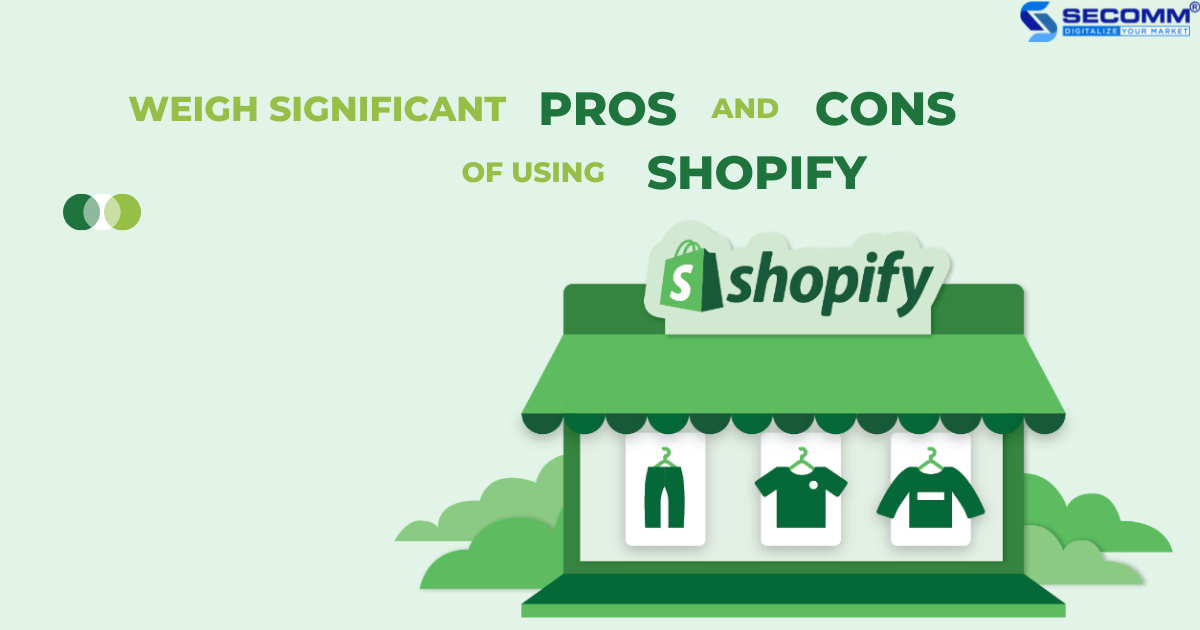
9+ PROS AND CONS OF USING SHOPIFY
Today, for businesses of all sizes, eCommerce websites play an essential role in reaching and buying products for a wide pool of potential customers on the Internet.
Thus, choosing the right platform to build an eCommerce website is incredibly important. A good eCommerce platform will make it easy for businesses to provide Omnichannel experiences, personalize customer experiences, offer a variety of services, products, and more to increase conversions and drive online sales.
Some commonly mentioned platforms for building eCommerce websites are Magento, Woocommerce, Bigcommerce, etc. Definitely, each business will have its considerations, but one platform that always appears as a top choice is Shopify. In spite of the fact that the platform is highly rated, businesses should still weigh the pros and cons of this platform before making a final decision.
As a result, SECOMM has prepared this review, helping businesses understand what Shopify is, how it works, implementation costs, and especially the pros and cons of using this platform to build a comprehensive eCommerce website.
What is Shopify?
Before becoming one of the most popular eCommerce platforms globally, Shopify started as an online ski store called Snowdevil in 2004. Later, the company transformed into an eCommerce platform named Jaded Pixel.
In 2006, It was officially founded in Ottawa by young programmers Tobias Lutke, Daniel Weinand, and Scott Lake. Since then, the platform has gradually affirmed its position as a reliable and fastest-growing eCommerce platform in the last two years when most companies faced many difficulties because of the Covid-19 pandemic.
Up to now, the number of Shopify users has increased significantly. As reported by StoreLeads, there are currently about 2 million websites using the platform to build and develop online businesses. In the second quarter of 2022, the number of newly opened stores reached 150,928, an increase of 10.8% compared to the same period in 2021. In Vietnam alone, there are about 2,000 websites using the platform in operation, up 9.8% in the second quarter of 2022 over the same period in 2021.
Total revenue in the second quarter of 2022 reached $1.3 billion, up 16% over the same period in 2021, corresponding to a compound annual growth rate for three consecutive years of 53%. Gross profit in the second quarter of 2022 increased by 6% to $655.6 million compared to $620.9 million in the second quarter of 2021 (According to Shopify’s report).
While it is one of the most popular and user-friendly eCommerce platforms available today, businesses still need to determine if this is what they need to expand their business, all the advantages and disadvantages of the platform, mostly the cost issue.
Pros of using Shopify for an eCommerce website
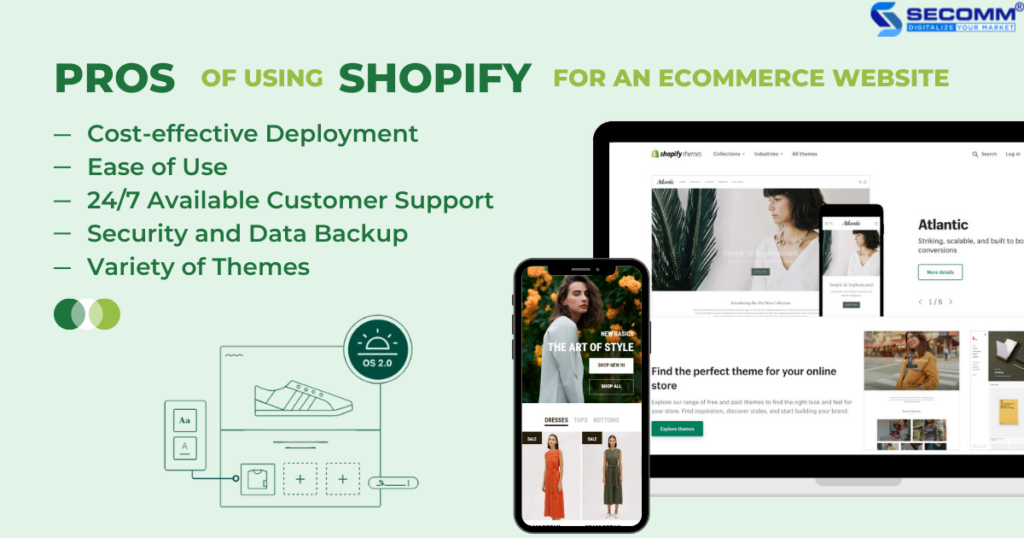
Cost-effective Deployment
For a start, businesses can enjoy a 14-day free trial without a credit card requirement. When the free trial ends, businesses are encouraged to opt for one of the solution packages with suitable features and appealing promotions.
|
Packages |
Price |
Main Features |
Unique Features |
Ideally suited for |
|
Starter |
|
Create product pages and get shareable links with product information, then send those links to customers via social platforms or message apps. | Merchants that sell on social platforms or message apps with no website in demand | |
|
Lite |
|
– Shopify Buy Button.
– Invoicing. |
Merchants that sell on an existing website or social platforms. | |
|
Basic |
|
– Customizable website editor.
– Website hosting and free TSL certificate. – Unlimited number of products. – Analytical reports – Localization: currency conversion, website translation, regional domains. – Inventory Management. – Shopify POS. – Shopify Email. -Shopify Payment. – 24/7 Customer service. |
– 2 staff accounts.
– 4 inventory locations. – Basic reports. |
Businesses who have just entered or intend to enter the eCommerce world and look for comprehensive eCommerce solutions. |
|
Shopify |
|
– 5 staff accounts.
– 5 inventory locations. – Standard reports. |
Steadily growing eCommerce businesses. | |
|
Advanced |
|
-15 staff accounts.
-8 inventory locations. – Advanced reports. – Automation tools. |
Large-scale businesses that sell internationally | |
|
Plus |
Từ $2000/month. However, businesses can contact Shopify for a custom estimate. | – 9 expansion websites.
– Up to 100 themes. – Exclusive Merchant Success Program, Shopify Plus Academy, Shopify Plus Partner , Shopify Plus Community on Facebook |
Enterprise-level businesses that manage and operate multiple eCommerce websites. |
Table list of price, and features of Shopify solution packages.
First and foremost, because it is a SaaS platform, the cost to get started is usually quite low. Despite the fact that businesses must pay monthly fees, transaction fees, theme fees, and extension fees, Shopify is still significantly less expensive than open-source platforms such as Magento, WooCommerce, and others.
The development of an open-source platform necessitates the assistance of experienced programmers and takes a long time to deploy, whereas the SaaS platform is the inverse. That is the reason why starting with a SaaS platform, specifically, Shopify, will save businesses both time and expense.
Another cost highlight is that SaaS platforms, in general, and Shopify in particular, require an ongoing monthly fee rather than a one-time purchase fee to use the platform. This reduces the risk of businesses investing too much money in the platform but not meeting their expectations during the implementation process.
Furthermore, the Shopify platform is appropriate for different-sized businesses in the market. The Starter, Lite, and Basic packages are appropriate for SME businesses engaged in eCommerce. Shopify, Advanced, and Plus packages are ideal for large-scale businesses that require advanced features to run an effective eCommerce website.
Ease of Use
The only way to adapt to the ever-changing market and quickly reach a wide pool of potential customers is for businesses to deploy eCommerce websites as soon as possible to avoid being left behind in the competition of the digital transformation race. One of the important factors when building an eCommerce website is choosing the right platform.
In particular, the top goal to consider when choosing an eCommerce platform is the ease of use. If a platform takes users too long to learn and implement or makes users dependent on external support, then the platform is not easy to use
Shopify has an easy-to-use interface for users with little programming knowledge. Moreover, Shopify is a SaaS eCommerce platform with a pre-designed system that offers hosting, interface, features, and technology infrastructure maintenance, allowing businesses to easily build and operate the website system with just drag and drop without worrying about technical issues.
Simple steps to get started with the eCommerce website implementation with Shopify:
- Choose from one of the solution packages depending on the business needs
- Choose a business domain
- Choose an appropriate theme and template
- Choose essential features
- Optimize the eCommerce website and add products
- Go-live
24/7 Available Customer Support
This is one of the most crucial factors influencing users’ decision to use Shopify. Difficulties and obstacles are inevitable when building an eCommerce website, so Shopify has assembled a reliable and trusted team to assist users.
As a result, if your business requires assistance, assistance is available 24/7. Businesses can reach Shopify via email, chat, and a hotline worldwide. What’s more, users can access community forums and useful documents for developing eCommerce websites on this platform, mostly through the Shopify Support Center.
Security and Data Backup
The Shopify platform runs on PCI (Peripheral Component Interconnect) compliant servers, allowing merchants to accept credit card payments. Secure Sockets Layer (SSL) encryption is enabled on all Shopify websites to secure visitor data, while a backup system allows businesses to store and save data regularly by exporting data to a CSV file.
As an outcome, the platform encourages the addition of an advanced backup solution from the Shopify Store, such as the Rewind app, as it is seen as a lifesaver if users accidentally delete content such as products or images or a video demonstration. To keep your eCommerce website secure, simply back up your data on a regular basis and use a strong enough admin password.
Variety of Themes
The interface is the appearance of a business’s eCommerce website. The more appealing the website interface, the more likely it is to retain customers, attract more visitors, as well as generate more conversions.
Shopify understands the importance of a website interface, so it has made a host of available themes, both free and paid, suitable for a wide range of businesses and fields, making it simple for businesses to choose from.
The free Shopify themes are ideal for startups, small and medium-sized businesses, and individuals. Businesses can customize their eCommerce website according to their needs and brand features by using features such as responsive web design, product filters, and product color display templates.
However, free themes have some downsides, including a limited number of themes, limited design, and a lack of advanced and specific features, which makes website customization difficult.
In fact, free themes are great for launching an eCommerce website. Premium interfaces, also known as paid themes, will be more suitable for large-scale businesses or businesses on the rise, with an average cost of around $140-$180/theme.
Shopify’s paid themes include advanced integration features such as live chat support, newsletter popups, upsell features, faster page loading, and much more. Thereby, businesses can run an eCommerce website automatedly and smoothly.
The Cons of using Shopify for an eCommerce website

Not Easy to Keep Track of Expenses Incurred
The cost of using Shopify, besides the notable pluses, the platform has a small but enough minus to make some businesses hesitate to start.
In addition to the monthly fee for using the enterprise platform, businesses must pay for other costs such as themes, applications, extensions, marketing features, sales, and SEO on a monthly basis with no long-term possession.
For example, to use the Free Shipping & Hello Bar application that offers free gifts, free shipping, or other types of promotions, users will buy for $8.95/month, which means ongoing monthly in regards to other expenses, businesses will pay an additional $8.95 for this app until it is no longer used.
When there are small expenses incurred each month, it is difficult to control cash flow for large-scale businesses that have to manage and operate many websites at the same time.
Meanwhile, open-source platforms require a one-time purchase fee rather than an ongoing monthly fee. Although the features are not yet available and take a long time to program, businesses can possess those features for eCommerce websites in the long run. Thereby, it makes cash flow management more convenient and effective.
Difficulty with Content Marketing
It is a great way to promote your eCommerce website. Users can use Shopify to blog and optimize SEO, drive free traffic, and improve brand positioning.
However, this blogging feature on Shopify is not as user-friendly as WordPress. Some of the criteria Shopify can improve regarding blogging and content writing include:
- The outdated editor.
- The blog layouts are inflexible
- No categories force users to use tags
- Cannot add related blogs
- Cannot embed products in blogs
- Not easy to integrate third-party add-ons
This will be a barrier for businesses when using Shopify to promote eCommerce websites by optimizing SEO if the content is a core element of the business’s marketing strategy.
Limited Customization
Another limitation of Shopify is that the platform’s interface is customized using the Shopify Liquid setup. Meanwhile, many website developers are already familiar with the PHP programming language to customize the themes and templates of the website, it is a common technique used by WordPress.
Therefore, users who do not have much experience in programming will face many obstacles when using Shopify’s tools to customize the interface of the eCommerce website.
However, businesses of all sizes can still use other useful Shopify features like Shopify Themes, Shopify App Store, Shopify Blog, 24/7 support team, and more to set up an eCommerce website quickly and effortlessly.
Cannot Possess Source Code and Data
Because the entire business’s website system is hosted on Shopify’s server, the ownership and control of the website source code will belong to Shopify, not the business. Similar to other SaaS platforms such as BigCommerce, Squarespace, Wix… Shopify has a Lock-in feature, which means that when converting a website from one platform to another, businesses will no longer be able to use the old website source code and have to rebuild from scratch on a new platform.
Similar to the source code, business data is also stored on Shopify’s servers, so data ownership and control are quite limited. This makes it difficult for businesses to connect data among internal departments or users’ personalization, etc. Especially when switching platforms, data loss or misalignment is often unavoidable.
Shopify will not assist in the event that businesses stop using the platform for any reason. The only asset businesses can keep and take away is a CSV report containing website information.
Hence, before starting an eCommerce website on the Shopify platform, businesses need to carefully consider the benefits and disadvantages of stopping using it to conclude whether Shopify is the best fit for business in the long run.
Going by this article, Shopify is one of the eCommerce platforms that many businesses would love to choose when deploying an eCommerce website. However, besides the outstanding advantages, there are still certain downsides, so businesses need to carefully consider and compare with other platforms before starting out.
With many years of experience in implementing eCommerce in many countries, SECOMM provides free consulting services with professional eCommerce solutions.
Contact us today for free support and advice!
 2
2

 1,840
1,840

 0
0

 1
1
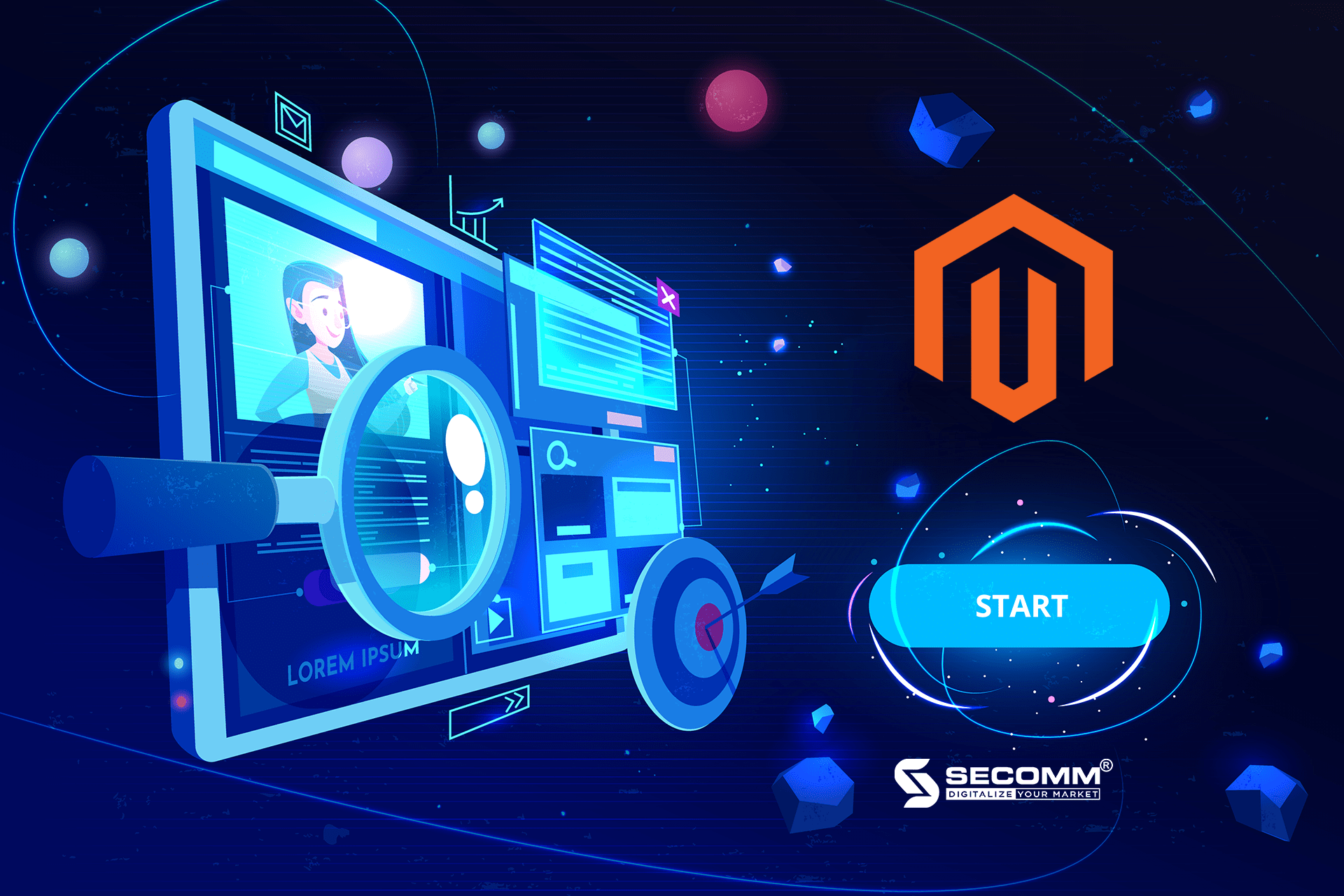
IS THE MAGENTO ECOMMERCE PLATFORM APPROPRIATE FOR SMEs?
Platforms play a significant role in developing and operating an optimal eCommerce system. As a result, selecting an eCommerce platform should be done thoroughly and carefully to maximize the platform’s benefits and promote long-term business growth. Each business’s eCommerce model will have appropriate platform options depending on the development goals. However, most SMEs today face significant challenges in selecting a suitable eCommerce platform due to a variety of budget, time, and business characteristics.
The Magento eCommerce platform is the most fantastic platform for eCommerce systems among popular names such as Shopify, BigCommerce, WooCommerce, and so on. Magento has many distinct advantages, including high flexibility, a diverse ecosystem, and optimal security. However, are Magento’s outstanding features the best option for SMEs? So, what are the standout characteristics of the Magento eCommerce platform? Will they be appropriate for SMEs in the Vietnamese market?
These prominent advantages make the Magento eCommerce platform appropriate for SMEs.
A diverse ecosystem
Possessing all of the basic eCommerce system’s functions
The Magento eCommerce platform is designed to grow into a comprehensive eCommerce system.
- Catalog Management: Develop and maintain all data, functions, and information about products, categories, attributes, pricing systems, inventory, images, and videos to keep operations running smoothly and maximize business performance.
- Content Management: Create and optimize all CMS page content elements, host images, theme customization, and website design.
- Sales Management: Establish and oversee the sales, order, payment, and shipping processes. Simultaneously, diversify customer information to provide the best possible customer experience.
- Marketing Management: Optimize and implement SEO the promotion programs (promotions, up-selling, cross-selling, etc.) with support tools, are used to increase business sales.
- Customer Management: Manage customer information entirely to improve marketing efficiency, the purchasing experience, and customer experience.
- Inventory Management: Fill the supply chain quickly and effortlessly with inventory management tools that direct shipments to the appropriate warehouses.
- Report: Make use of data effectively by delivering comprehensive and detailed reporting to improve and enhance business performance, including Sales & Marketing, Customer Reports, Product Reports, and Evaluation and Operational Performance Report
- Analysis: Monitor and measure the eCommerce system performance with built-in tools like:
+ Integrate Google Analytics to track and report on traffic, audience, purchasing process, and purchasing behavior.
+ Integrate Facebook Pixels makes tracking ads performance and capturing website actions simple.
+ Integrate Google Tag Manager to quickly update website metrics and related tags to increase personalization and accomplish the proper goals for the subsequent Marketing campaigns.
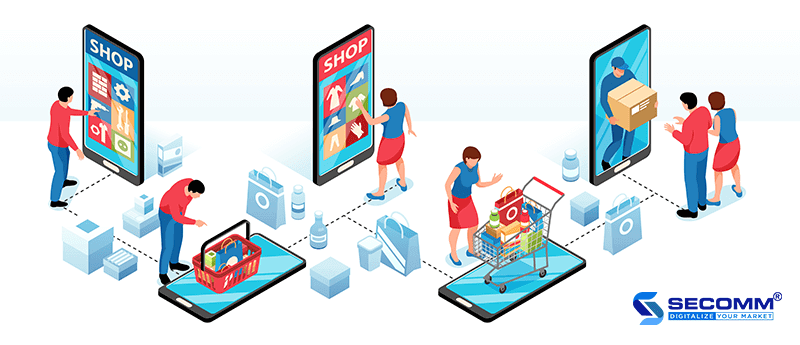
Diverse extension systems with numerous advanced eCommerce functions
The Magento extension system has also been significantly developed to meet the eCommerce market’s rapid development and the specific requirements of each business.
Thousands of advanced functions on themes, add-ons, products, Marketing, payment optimization solutions, shipping, and so on have been built with flexibility and high usability to deliver exceptional results when integrated into the system that meets all operational needs and ensures the long-term growth of businesses’ eCommerce.
Ability to integrate with other systems and services
Businesses can fully integrate third-party services, analytics tools, management software, and Omni-channel with the Magento eCommerce platform to support efficient and seamless eCommerce operations.
- Payment: Simply connect to the Magento system to today’s most popular payment methods, such as card payment (ATM, VISA, Mastercard,…), eWallet (MOMO, ZaloPay,…), payment gateway (OnePay, VNPay, PayPal,…), or COD… helps to diversify the payment and purchasing experience
- Shipping: Easily integrate couriers (Giao Hang Nhanh, Giao Hang Tiet Kiem, Viettel Post) and popular shipping tracking applications in the market to support handling and optimize delivery processes
- Management and operation software: Integrating the Magento system with back-office management and operation software (ERP, CRM, POS, …) such as SAP, Salesforce, and Oracle.. to operate all resources and processes seamlessly in the enterprise.
- Business Analytics Tool: Magento can also integrate with business intelligence (BI) tools such as Power BI, Tableau, Looker, and others to improve business efficiency and easily merge and exploit all data from the system. The Magento system, extensions, and third-party services enable quick, efficient, and data-driven analytics and reports to improve business strategy and drive growth.
- OmniChannel: Consolidate all sales channels on the same Magento system to handle and control data and create seamless offline and online business processes. Furthermore, businesses can quickly develop and manage omnichannel marketing strategies to personalize customer experiences and optimize eCommerce.
Global technical support community
In addition to a fully functional feature system, the Magento eCommerce platform is supported by a diverse system of extensions and technologies from a global developer community, allowing all eCommerce requirements of SME businesses to be met quickly anytime, and anywhere. The Magento eCommerce platform has a large developer community worldwide, including many experienced professionals and Magento developers.

Businesses will receive maximum support in solving problems arising from technical errors and consulting on building eCommerce solutions that fit the enterprise’s business model with a strong Magento eCommerce platform development community.
An extensive technical support community is another example of the reliability and capacity to quickly resolve system errors and updates that Magento constantly brings to our eCommerce system.
Magento eCommerce Platform Flexibility
The Magento eCommerce platform’s flexibility is an exceptional advantage that allows the Magento eCommerce platform to operate any complex system. Given this benefit, Magento is an excellent choice for Vietnamese SMEs today. Moreover, businesses can easily change system functions, develop new features, or open new stores to meet their needs and respond to rapid market change.
Customizability
The Magento eCommerce platform possesses the advantages of open-source software with extensive customizability to help the system run smoothly. Enterprises can easily own and control the entire system source code and customize it to change parts to suit the eCommerce system’s general operating model.
Owing to this benefit, Magento is highly customizable for any size business and can meet the eCommerce needs of both small and large corporations.
Besides that, the customizability of open-source code enables developers to create more innovative and comprehensive solutions tailored to each business, field, and business model, creating highly specialized eCommerce functions that result in effective system performance.
Scalability
Multi-websites, Multi-stores
Magento allows businesses to scale from one website/store to many different websites/stores on the same system to meet the needs of business scale development. Businesses can access and manage all data from multiple websites/stores using a single Magento system.
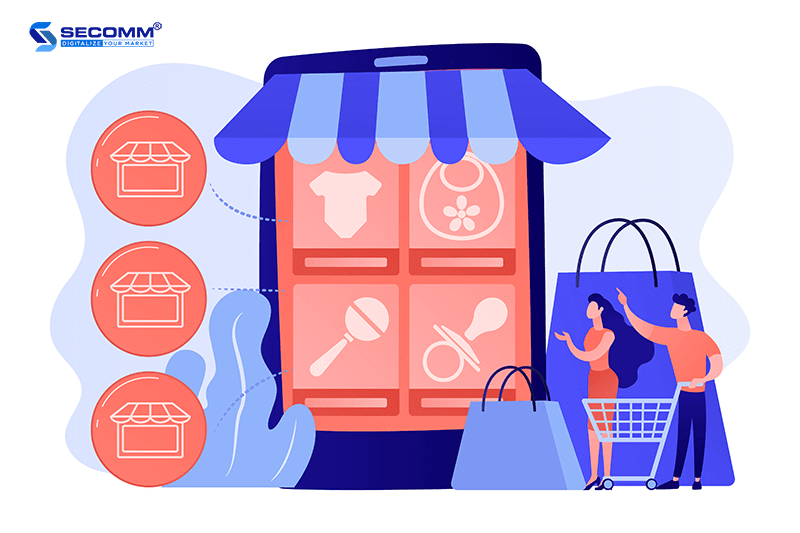
Multi-languages, Multi-currencies
With Magento’s language conversion support, businesses can create an eCommerce system with customer-friendly content and language. Besides that, the Magento system enables businesses to quickly convert currencies, expand their markets in many countries, and assist customers in transacting conveniently and having the best shopping experience.
Security Capabilities
High security is another significant benefit that makes the Magento eCommerce platform the preferred choice for SMEs. Magento is a complete eCommerce system with security functions that ensure seamless eCommerce operation while minimizing potential data system and ecommerce transaction processing risks. As a result, system security is improved, website credibility is increased, and user interests are protected to the greatest extent possible.
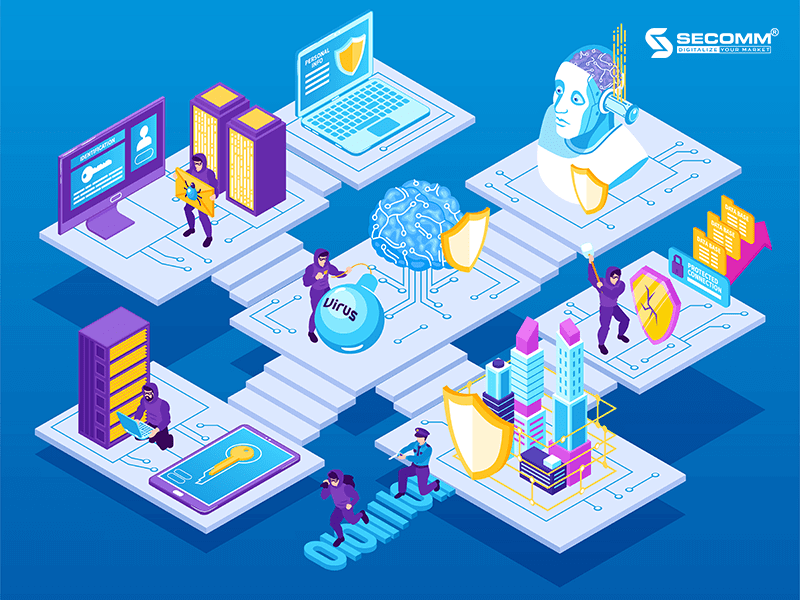
Security scanning tool
Magento includes a periodic security scan tool to identify security issues or malware affecting the system and update patches and notifications, then propose security solutions to handle arising errors, thereby effectively improving and optimizing the website’s security.
Advanced passwords for the administrator account
The requirement to use advanced passwords should also be fully implemented to increase the level of security for administrative accounts. The administrator password must be at least seven characters long and include letters, numbers, and special symbols. Relating to further adjustments, the password complexity may be increased with lower case/case sensitivity, or re-login may be required after a certain length of the login session.
CAPTCHA security
CAPTCHA can protect the system for both administrators and website visitors. In addition, using CAPTCHA aids the system in preventing bot spam and malicious code from entering the system illegally.
2FA function- Two factors of security authentication
This function provides additional security for system user accounts. Accordingly, customers will have to authenticate with an additional OTP security code sent to the phone number provided during account registration after logging in with a password. This two-layer security operation effectively limits the threats of unauthorized access and account attacks while enhancing protection and maximum safety for system users.
Problems encountered when implementing eCommerce on the Magento eCommerce platform.
With significant advantages such as a fully functional feature system, flexibility, a diverse ecosystem, and optimal security, the Magento eCommerce platform is the best choice for SMEs looking to build a stable and sustainable eCommerce system. However, due to deployment costs, implementation time, and complex industry-specific issues, most SMEs are still hesitant to use Magento to build an eCommerce system.
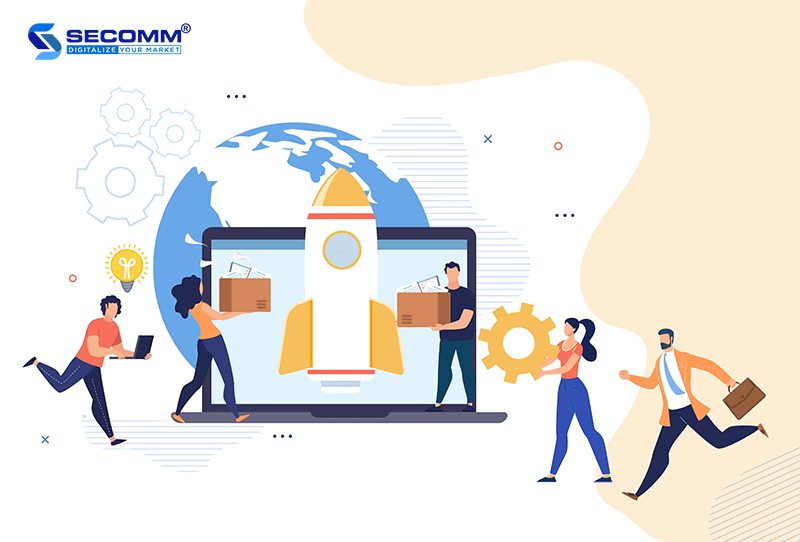
High implementation costs
Although Magento is highly regarded for its features and performance, the cost barrier prevents SMEs from selecting the Magento eCommerce platform to build their system. Furthermore, the expertise of the system developers is a significant factor that significantly increases the cost of Magento implementation. Therefore, a complete and efficient Magento eCommerce website is implemented by a professional team that is thoroughly knowledgeable about Magento to develop the proper comprehensive system from the beginning and provide appropriate solutions for the enterprise’s various needs in the long run.
A fully functional system built on the Magento eCommerce platform is estimated to cost between $10,000 and $100,000.
The long implementation timeline
A complete project on the Magento eCommerce platform typically takes 2-3 months to deploy, with some projects taking up to a year. Additionally, enterprises should constantly develop components of the eCommerce system. Furthermore, the functional system’s complexity necessitates time investment to build appropriate development solutions.
When selecting an eCommerce deployment platform, SMEs should consider the time issue carefully. With the requirements of the eCommerce and digital transformation markets, the extended system implementation time slows down the digital transformation process, making it difficult for businesses to keep up with competitors or constantly update trends in the market.
The complexity of dedicated functions
When converting to eCommerce, the specific characteristics of each industry and field remain a complex problem for every SME. Because most Vietnamese SMEs lack the technical knowledge and expertise required to build particular functions that can satisfy one or more specialized processes and the complexity of the eCommerce system, industry specificity has become a significant obstacle. These specific functions necessitate a corresponding technological solution to ensure that the eCommerce system can operate effectively and sustainably after the transformation.
Simultaneously, to build a specific feature with high complexity for a Magento store, businesses may need to spend more money and time than usual to develop a suitable solution to the particular requirements of an eCommerce business.
With extensive experience developing many complex e-commerce systems on Magento, SECOMM understands the challenges that businesses face when selecting a platform and implementing E-commerce.
Contact SECOMM for a free consultation on comprehensive e-commerce system development solutions!
 2
2

 2,881
2,881

 0
0

 1
1
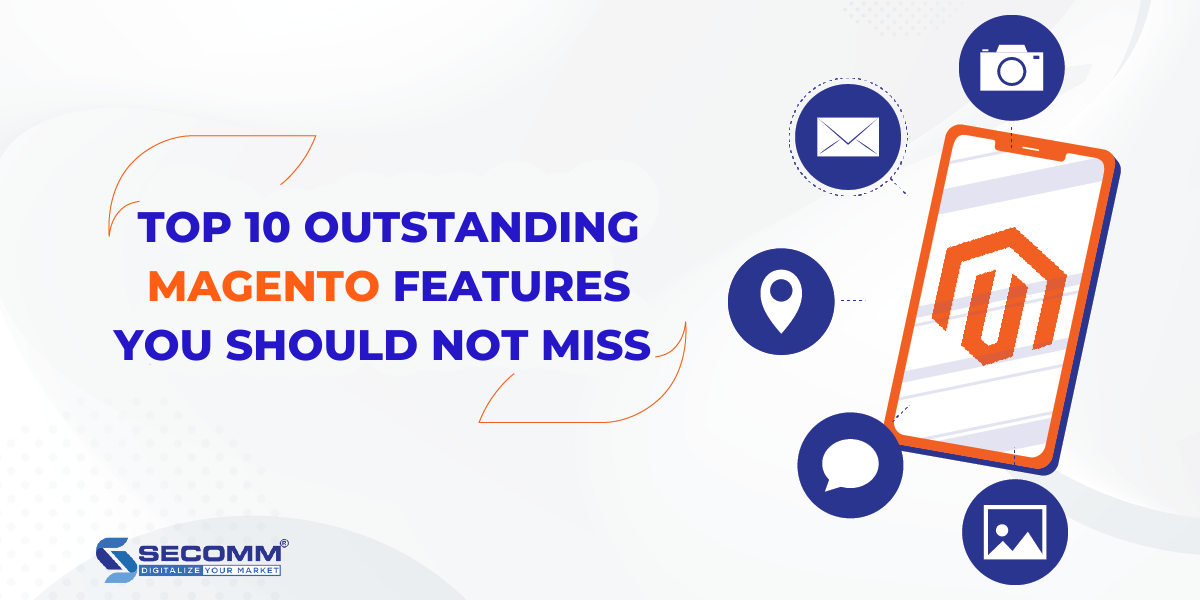
TOP 10 OUTSTANDING MAGENTO FEATURES YOU SHOULD NOT MISS
Since its inception, Magento has maintained its distinct position in the eCommerce development community. One of the primary reasons for this is that Magento has a diverse, highly applicable feature system compatible with all business models (B2B, B2C, B2B2C, D2C).
SECOMM will introduce some “cool” Magento features for businesses to consider
Multi-brand solution
The Multi-Brand Solution is a multi-language, multi-currency, and multi-store solution that helps businesses unify all content and products on a single “screen.” Businesses with various brands, stores, or business models can set up multiple pricing structures, display a wide range of product types, and customize payment methods for any audience ( B2B, B2C, B2B2C, D2C).
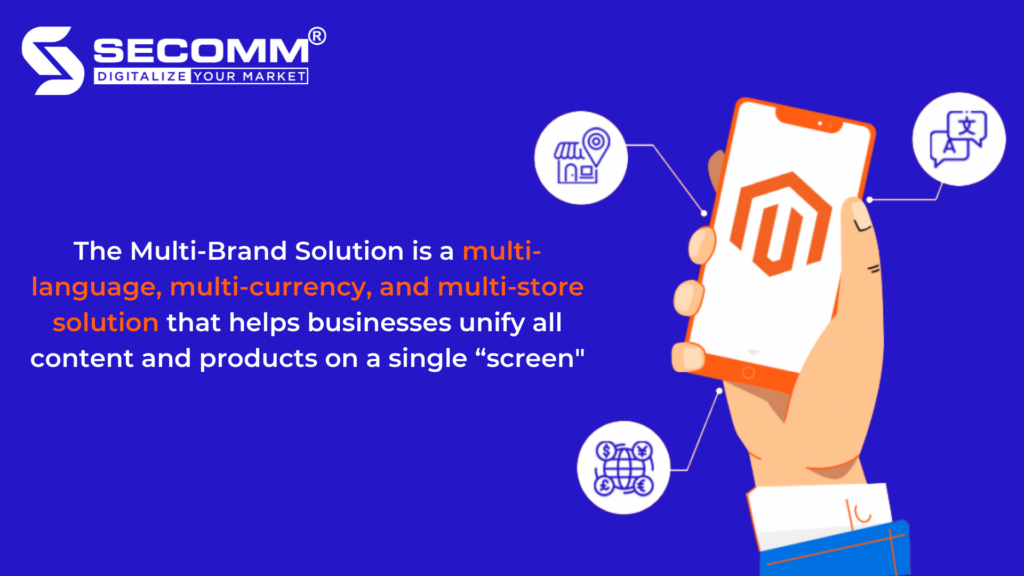
This function assists businesses in increasing sales by utilizing all content to create eye-catching websites to maximize customer information. As a result, targeting different customers with product recommendations and promotions is possible. Simultaneously, the adaptability enables businesses to personalize the purchasing experience through customized categories and pricing.
MSI (Multi-Source Inventory)
MSI is a prominent feature of Magento 2 (starting with version 2.3.0) that allows businesses to easily manage products from multiple stores, significantly improving inventory management regardless of customer location, warehouse, or sales channel.
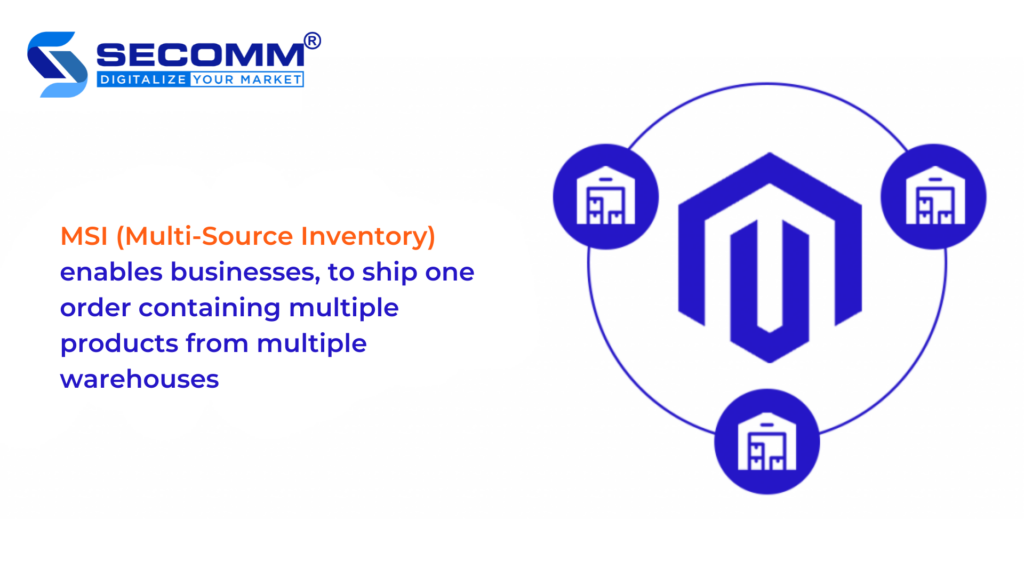
This feature enables businesses, particularly dropshipping businesses, to ship one order containing multiple products from multiple warehouses while ensuring on-time delivery to customers.
Headless Commerce
Magento’s headless Commerce is an eCommerce architecture that separates the frontend (which represents the user interface) from the backend (which means the eCommerce functionality). The front and backend are linked together by an API, allowing businesses to easily customize and update without interfering with the user interface or CMS pages.
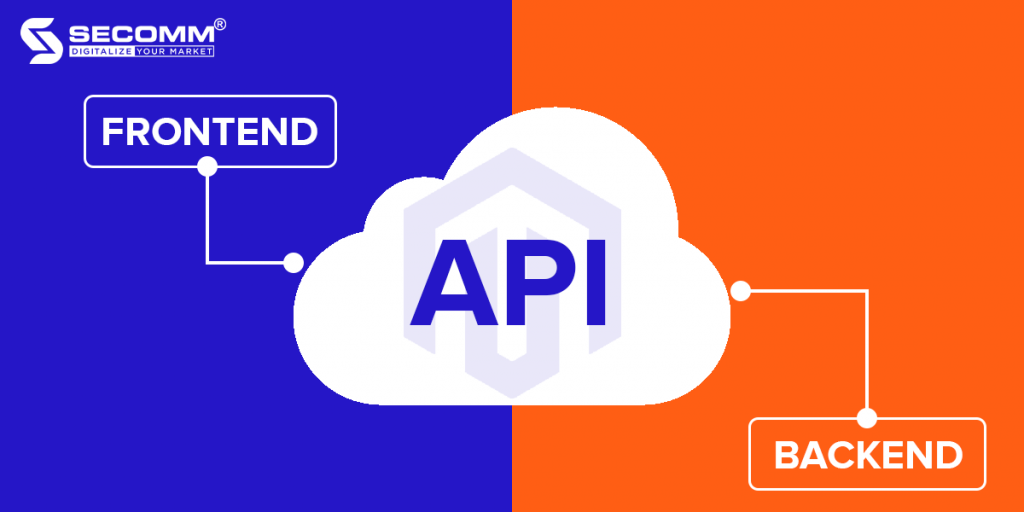
Thanks to the applicability of Headless Commerce, Magento websites benefit from faster page load times and personalized user experiences at a lower long-term cost.
Comprehensive Analysis
Magento allows you to track and measure eCommerce system performance using built-in tools like Google Analytics, which tracks and reports traffic, audience, purchasing process, and purchasing behavior.
Use Google Tag Manager to quickly update website metrics and related tags to increase personalization and reach the right goals for the following marketing campaigns.
Use Facebook Pixels to measure ad performance and capture actions taken on the website.
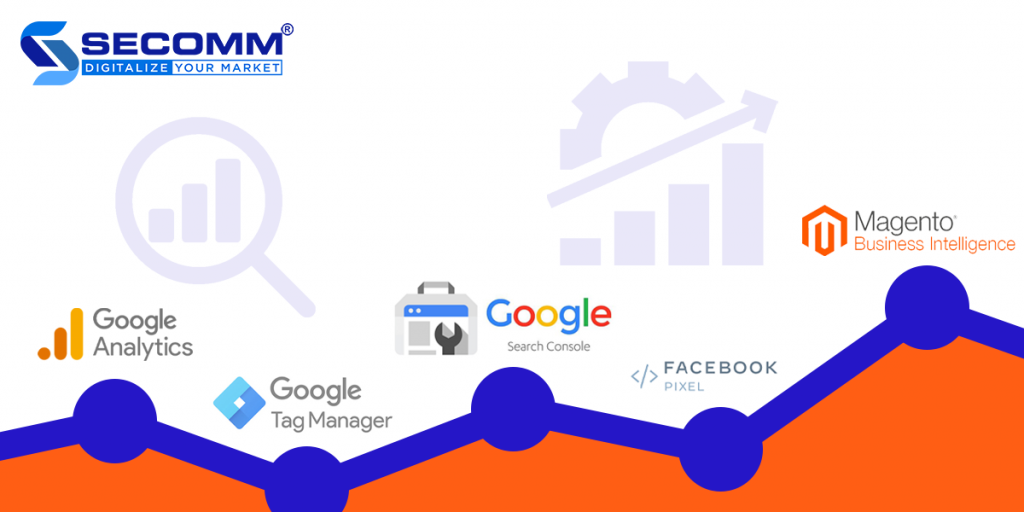
Furthermore, Magento supports Business Intelligence (BI) analysis. Magento BI is a cloud-based platform that allows you to consolidate and manage data sources, create data models, and create charts and reports from a single screen. Sending out periodic reports also helps to control information sharing.
Integrating various B2B functions
Specially designed for B2B customers, supporting various functions like:
- Shared Catalog: This allows companies to create “shared” catalogs with prices, products, and customization rights for multiple brands.
- Business Account: Assist admins in creating accounts, managing all data, and assigning sales representatives as accounts’ primary contacts.
- Quick Order: Order by SKU is similar in that it allows customers to add products to their cart by simply entering the SKU (Stock Keeping Unit) code and quantity information or loading a CSV file.
- Business Credit: Allows businesses to extend their B2B customer credit line, allowing them to make purchases up to the authorized credit limit on their account. This function assists businesses in tracking and controlling credit issues.
- Quoting: Allows businesses to manage quote requests in the admin interface, view contact history between buyers and sellers, and export data.
- Payment on Account: This feature is applicable globally or in business and occurs in the payment process with a message that will appear at the top of the order to indicate the status as an additional offline payment method that allows companies to make purchases up to the credit line specified on file.
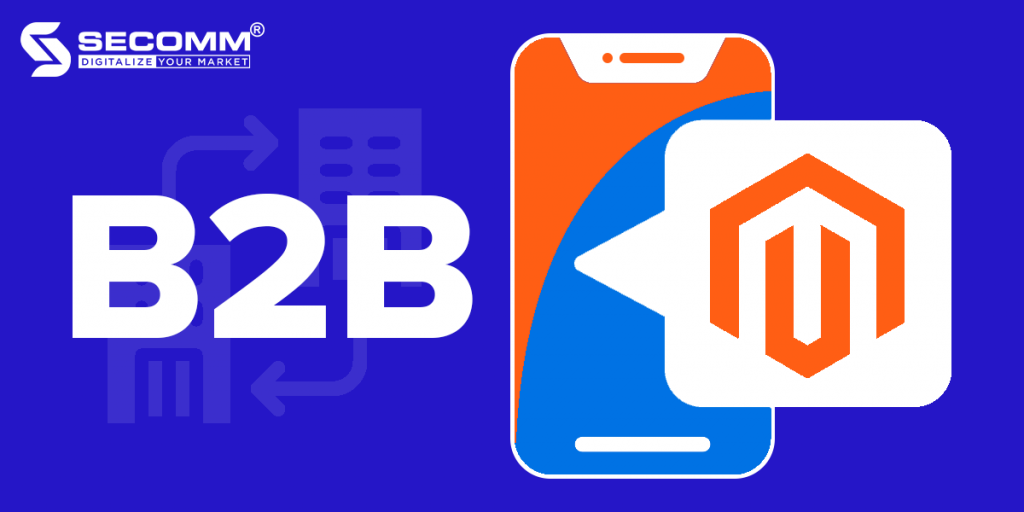
All of these features assist businesses in managing user accounts via the customer portal, allowing them to quickly set up multiple levels of buyers with specific roles and benefits.
In addition, companies can track quotes and orders, define purchasing rules, and manage credit online simultaneously. Since then, business and management in the B2B model have become more efficient and faster.
Advanced search function
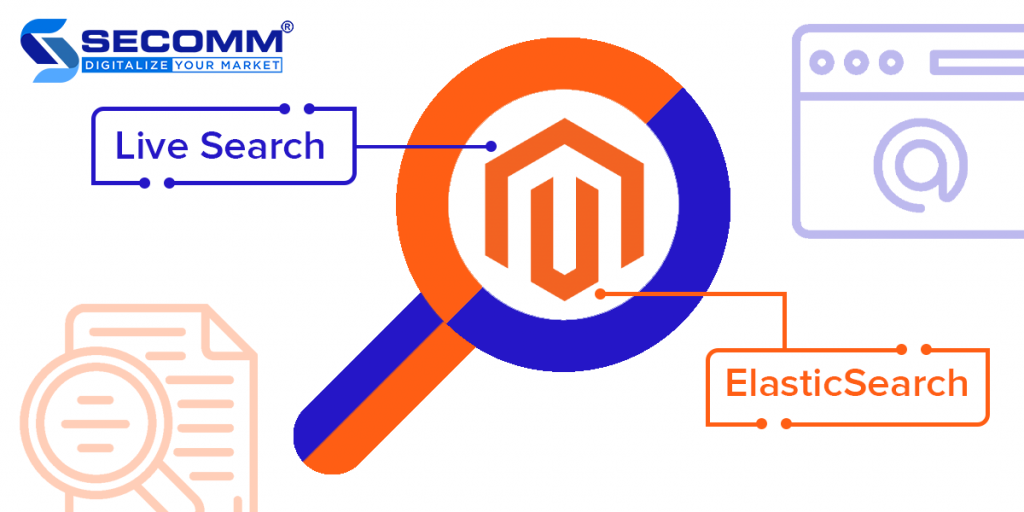
Live Search combines artificial intelligence (AI) and machine learning (Adobe Sensei) to provide fast search results and personalized product recommendations based on customer behavior, trends, characteristics, and other data.
ElasticSearch is an open-source distribution that supports enterprise-level search engines for searching data on the server. This function aims to perform real-time analysis and data source mining (MS SQL, MySQL, PostgreSQL, etc) to optimize highly for fast language-based searches.
Simultaneously, overcome the difficulties by hiding all other complex operations by providing API access.
Smart page builder
This function includes a variety of actions, such as the ability to drag and drop content on the website to provide the best user experience, preview how the content will appear on the user interface, and modify forms to enter and customize content.
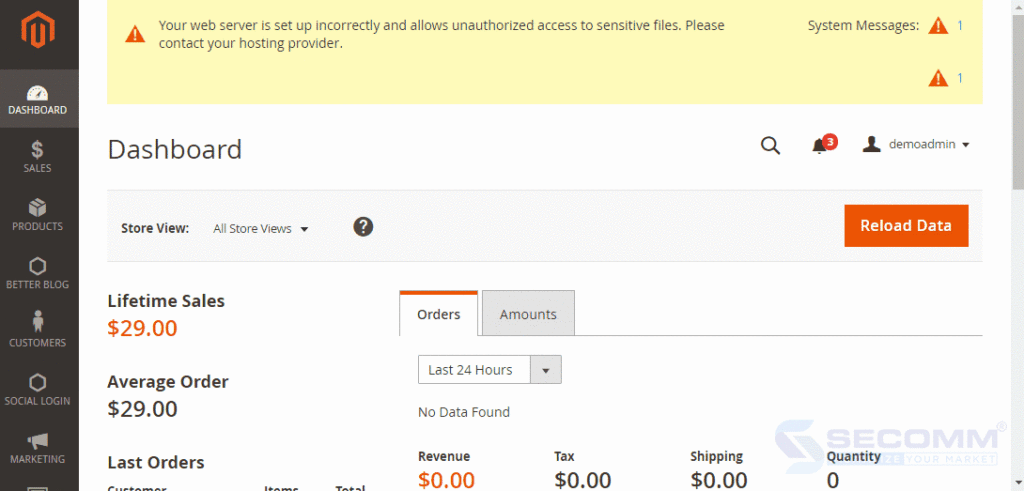
Initially, Magento’s functionality only supported the Magento Commerce version (Magento Enterprise Edition). Still, since Magento 2, the developer has supported the Magento Open Source version, allowing businesses to create unlimited CMS content pages.
High Security
Magento’s high security has long been a distinguishing feature that makes it the preferred platform for businesses.
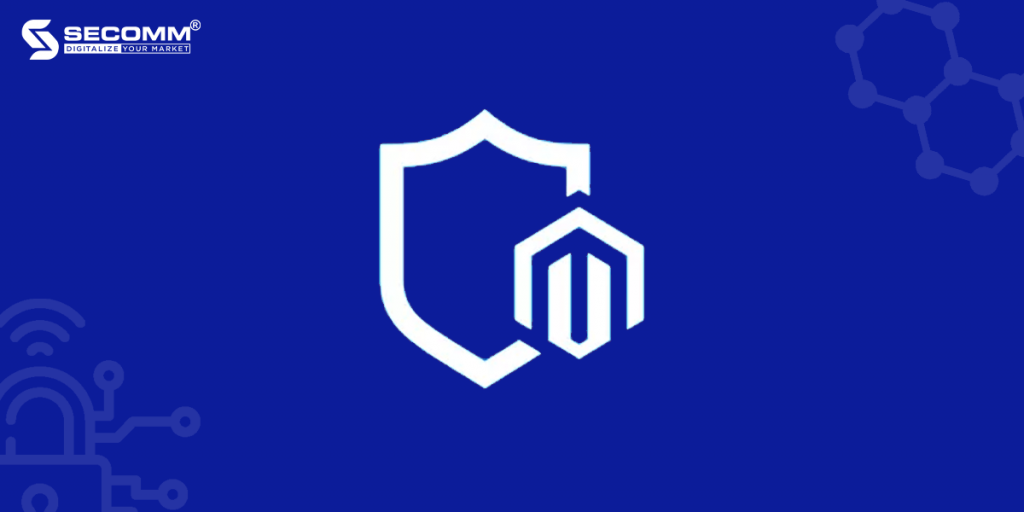
Using a periodic security scanning tool to quickly identify problems and update patches and notifications, propose security solutions to deal with arising errors, and effectively improve and optimize website security.
To increase the level of security for administrator accounts, use advanced passwords. The administrator password should be at least seven characters long and contain letters, numbers, and special symbols. Password complexity may be increased with lower case/case sensitivity, or re-login may be required after a certain length of a login session, depending on additional adjustments.
CAPTCHA security can protect both administrators and website visitors. In addition, using CAPTCHA aids the system in preventing bot spam and malicious code from entering the system illegally.
The 2FA (Two-Factor Authentication) function provides additional security for system user accounts. To effectively limit threats of unauthorized access and attack on user accounts, customers must authenticate with an OTP security code sent to their phone number after logging in.
PWA (Progressive Web Apps)
PWA combines a website and a native app (for Android and iOS) on tablets and smartphones. Therefore, PWA enables your website to function and interact with mobile users in the same way that a native app would.
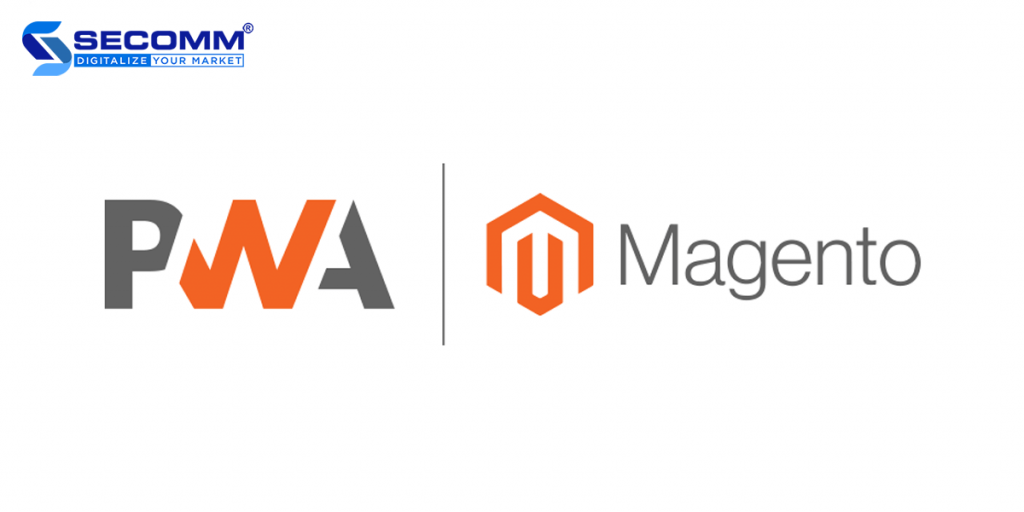
However, depending on the user’s needs, this website can be converted into a mobile application right on the device. Users can download the app to their phones when they visit the website. If the user agrees, they can open and browse the website in the same way they would an app on their phone.
Advanced SEO
SEO is another fantastic feature of Magento, in addition to optimizing website content, this feature also searches for indexed pages and assesses the SEO quality of each page. From there, the business website can use the robots.txt file to prevent the crawling of low-value parameters and consider only indexing pages with high search potential to improve rankings.
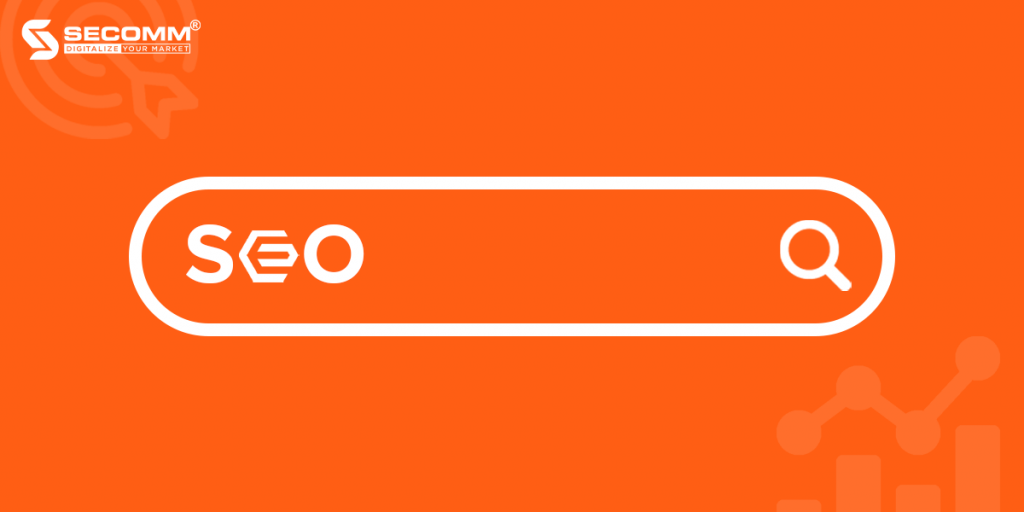
In addition, Magento has many other features such as cross-device compatibility, quick purchase and quick checkout, and so on. However, the development cost of an e-commerce website with such complex features is often very high, ranging from $5,000 to $100,000.Businesses should think about their e-commerce strategy when developing a unified sub-feature system.
With extensive experience developing many complex e-commerce systems on Magento, SECOMM understands the challenges that businesses face when selecting a platform and implementing E-commerce.
Contact SECOMM for a free consultation on comprehensive e-commerce system development solutions!
 2
2

 2,412
2,412

 1
1

 1
1
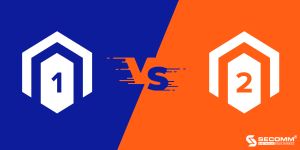
THE SIGNIFICANT DIFFERENCES BETWEEN MAGENTO 1 AND MAGENTO 2
Magento is a specialized open-source platform for creating the most popular eCommerce websites today.
Currently, it supports two versions: Magento 1 and Magento 2. Some websites use M1 platform, such as CellphoneS, and Bach Long Mobile (Magento Open Source 1.9). Websites using M2 such as Di Dong Viet, and Kidsplaza (Magento Open Source 2.3).
So what is the difference between the two versions, and why have businesses not upgraded their websites to M2?
What is the difference between Magento 1 and Magento 2?
Technology infrastructure
M2 uses newer technologies than M1, resulting in more diverse performance, user experience, and functionality.
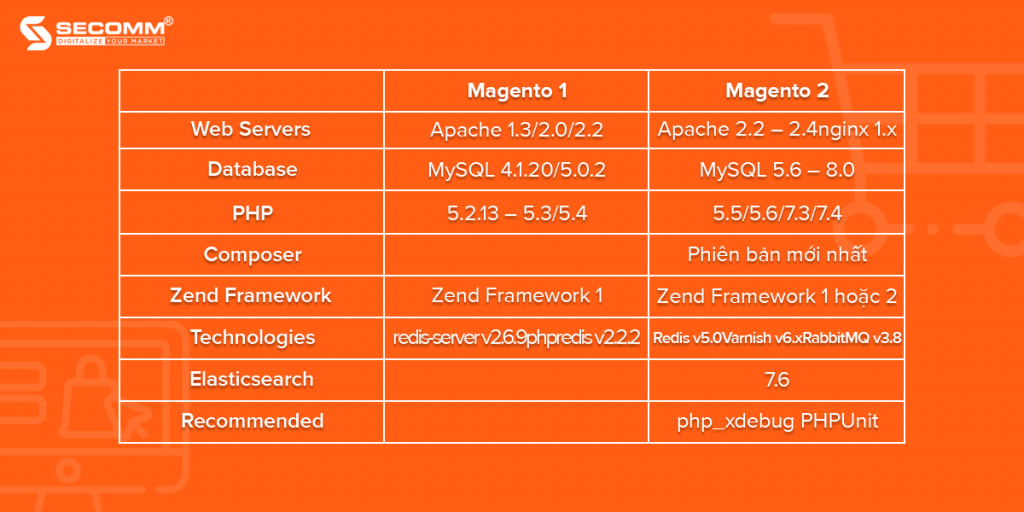
Extensions
Both platforms support a wide range of third-party extensions. However, many utilities on M1 will frequently repeat a piece of code, causing conflicts for the website’s functional system, and requiring a significant amount of time to manually fix it. Meanwhile, Magento 2 has supported a plugin that allows code to overlap, assisting in the issue’s faster and more effective resolution.
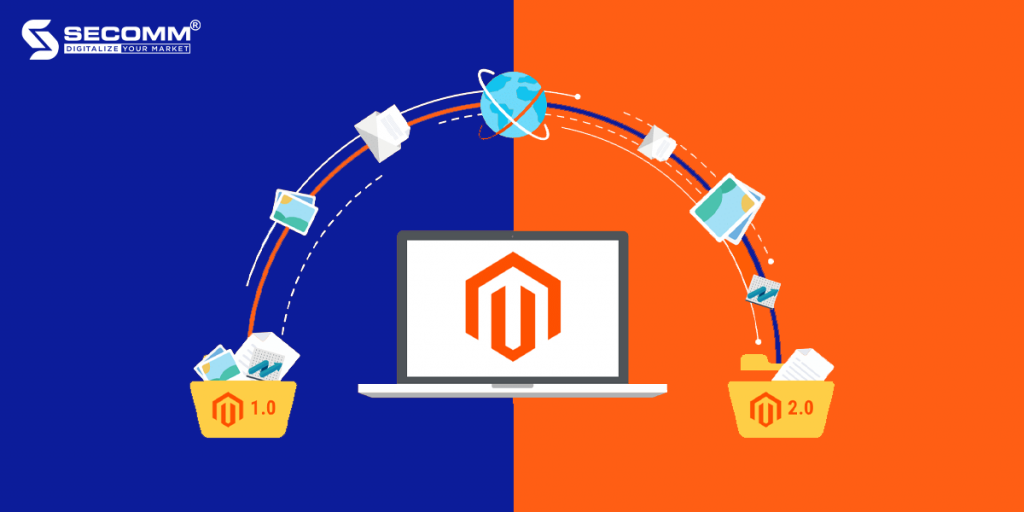
At the same time, M2 support utilities frequently use new technologies (HTML5, CSS3, Requirejs) at lower prices. Compared to M1, this makes it easier for developers to customize, upgrade, and build new functionality for the website.
Dashboard
Magento 1 is frequently criticized for having a messy admin interface that takes a long time to adapt. In contrast, Magento 2 is more user-friendly for admin accounts because:
- The dashboard makes it easier to read revenue, profit, tax, and reports effectively
- Allows quick information searches
- Allows for easy product creation and management
- Easy access to backend components
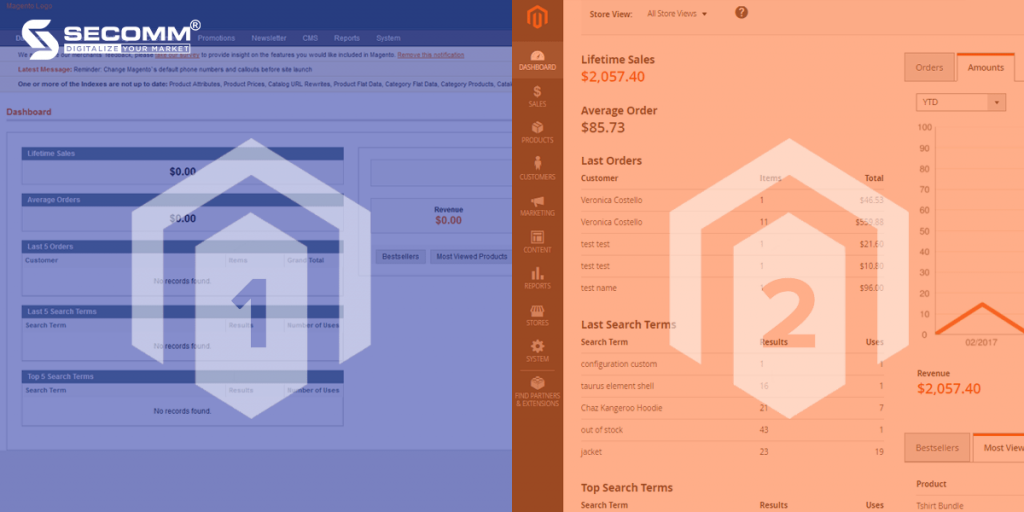
SEO
Magento has long been known for its SEO capabilities, but developers can improve SEO even better with Magento 2:
- Canonical tag support: Fix repetitive content to help increase the SEO content score for the website.
- Enable Meta tags (Meta Title, Meta Description, and Meta Keywords) for individual pages, which will aid SEO for each detailed product page.
- New technologies are responsive and provide a better user experience across devices.
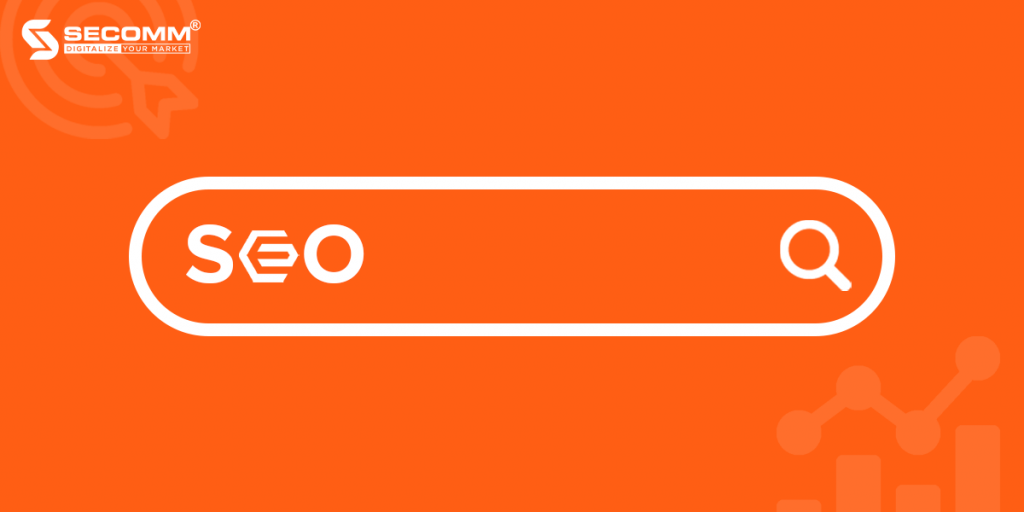
High Security
Since June 2020, Magento has stopped updating and releasing security patches and fixes for M1. Therefore, M1 websites easily become a target for cyber attacks.
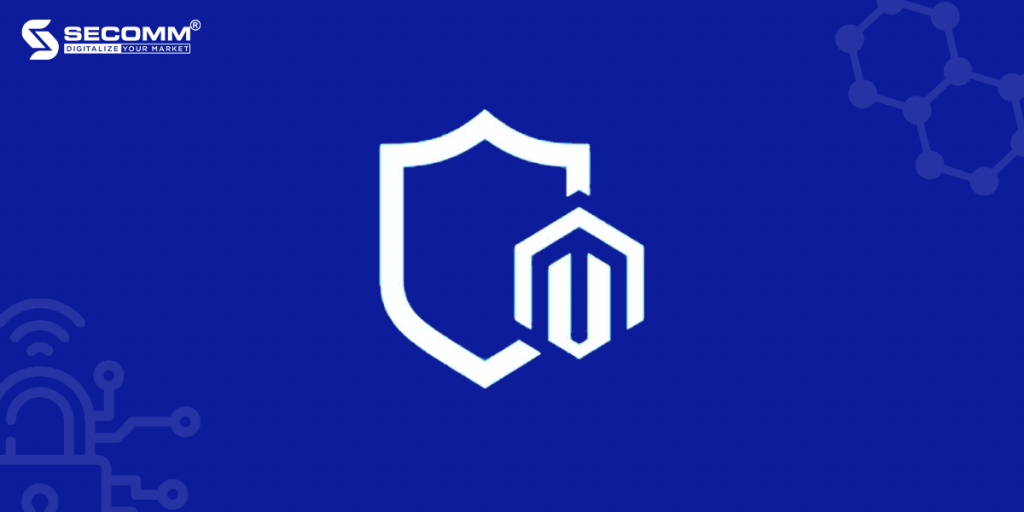
Meanwhile, the publisher continuously updates M2 to increase the system’s security. For example
- Improved password encryption (SHA-256) makes the system more difficult to compromise.
- Argon2UD13 support through PHP sodium extension (version 1.0.13) helps protect the system’s database
- 2-factor authentication for the administrator account to limit impersonation to steal website data.
Why do businesses hesitate to upgrade their website to Magento 2?
Magento 1 still meets current needs
M1 continues to meet enterprise eCommerce systems’ interface, functional systems, and management system requirements. As a result, businesses continue to use M1 rather than upgrading to M2. At the same time, the Magento technical community continues to support the utilities for M1 enthusiastically.
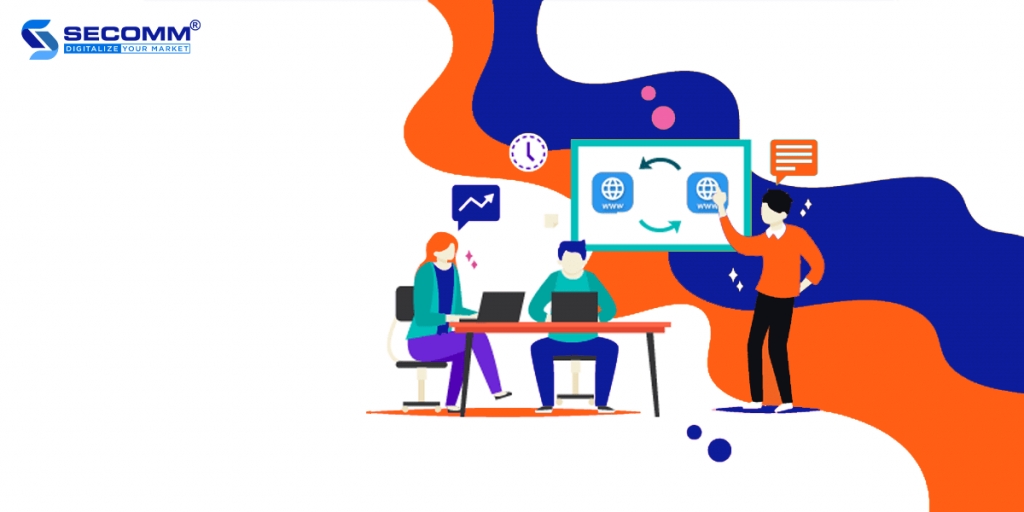
Magento 2 appears to be quite new to businesses.
Although Magento 2 provides many improved utilities, its technologies are still relatively new for many companies, particularly those in countries that have lagged behind eCommerce market growth.
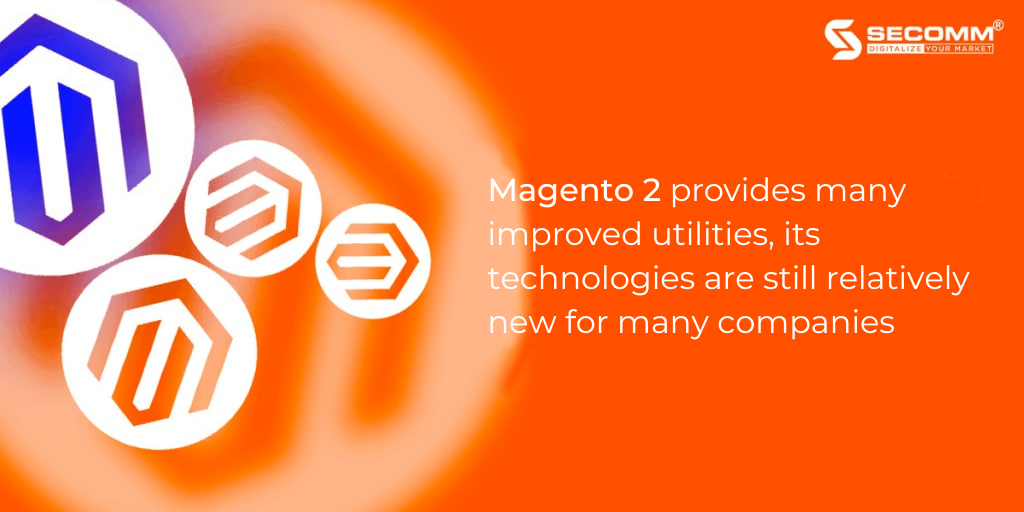
It takes time and money to upgrade.
Upgrading from M1 to M2 is difficult because the technology infrastructure is entirely different between the two versions. As a result, website developers will require a significant amount of time to migrate all functions and data from M1 to M2, ranging from 1 to 3 months on average.
In addition, businesses require a technical team with expertise in new technologies to manage the system and efficiently upgrade the website. As a result, the upgrade costs more, ranging from $5,000 to $10,000 or more, depending on the system’s complexity.
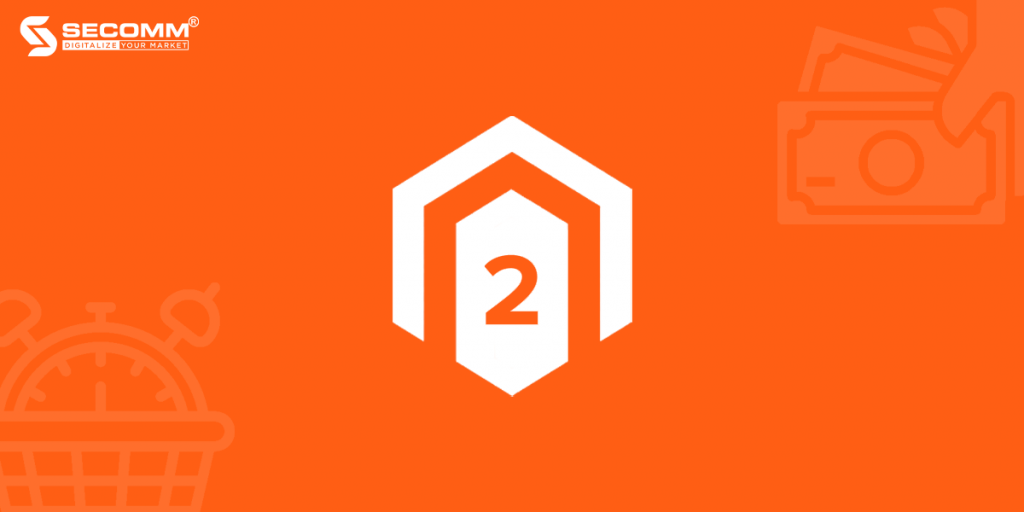
Although M2 outperforms M1 in every way, many businesses are hesitant to upgrade their websites to M2 due to various issues. However, upgrading the website to M2 is unavoidable in the long run due to the growing gap between the two versions.
Our company – SECOMM, has been partnering with many big enterprises such as An Nam Group (Vietnam), Jasnor (Australia), and Changi Airport Group (Singapore). As a result, we are aware of the challenges and worries firms face while developing an eCommerce website system as well as upgrading their websites from M1 to M2.
Get in touch with us now for FREE eCommerce development consultancy and solutions
 2
2

 2,592
2,592

 0
0

 1
1
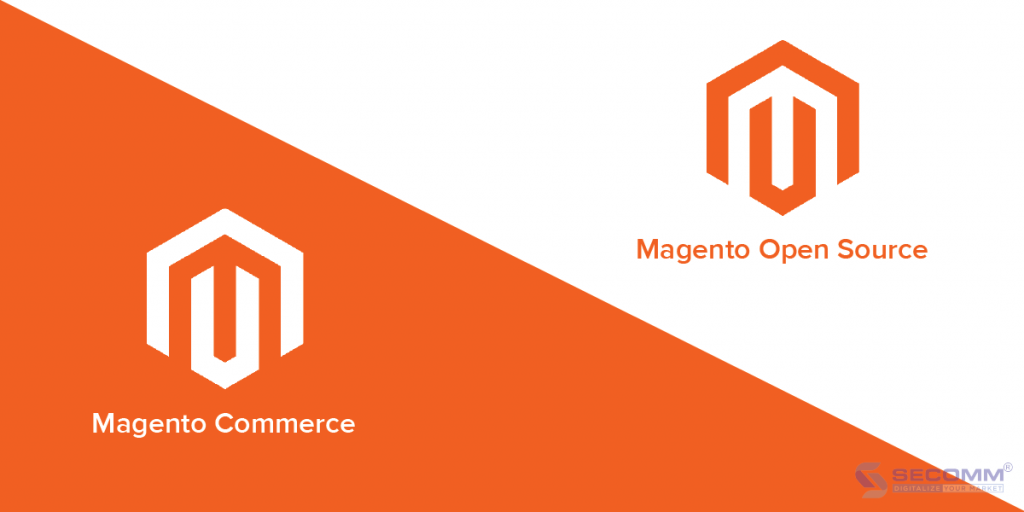
MAGENTO OPEN SOURCE VS MAGENTO COMMERCE REAL COMPARISON
With over 200,000 websites worldwide, Magento is today’s most widely used eCommerce platform. Magento is always the best choice for businesses to use because of the benefits of open source code and specialized features for the eCommerce market.
Businesses must carefully study the strategy and consider the needs of the website system when deciding between Magento Open Source and Magento Commerce to implement eCommerce on the Magento platform.
Magento Open Source là gì?
Magento Open Source was initially known as Magento Community Edition (CE), a free version of the Magento open source platform. This version provides a flexible framework for building eCommerce websites, which is popular among many businesses.
.

What is Magento Commerce?
Magento Commerce, formerly known as Magento Enterprise Edition (EE), is a website system used by large businesses with complex website system requirements.
This instance provides an on-premises solution as well as a hosted solution as a service (Magento Commerce Cloud), which aids in website performance and user experience. As a result, the annual fee for using this version is $24.000.

Comparison between Magento Open Source and Magento Commerce
Hosting
The platform will charge an additional $2.000/year for the included hosting service when using Magento Commerce to ensure that the business’s website system is constantly updated and upgraded, allowing it to handle high traffic and bills of lading more quickly.
Meanwhile, Magento Open Source is free to select a hosting provider that meets the business’s requirements and budget.
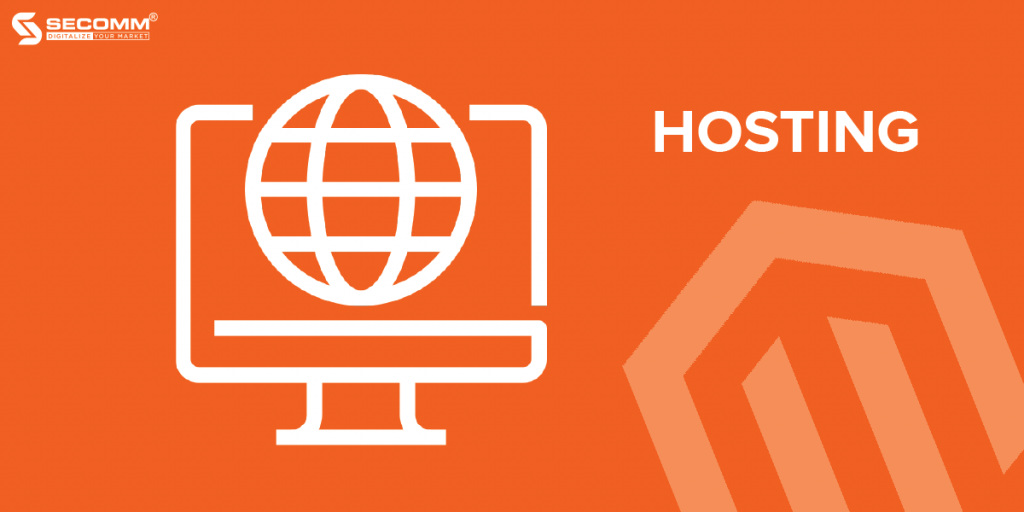
Feature
The following table compares the features that distinguish the two versions of Magento:
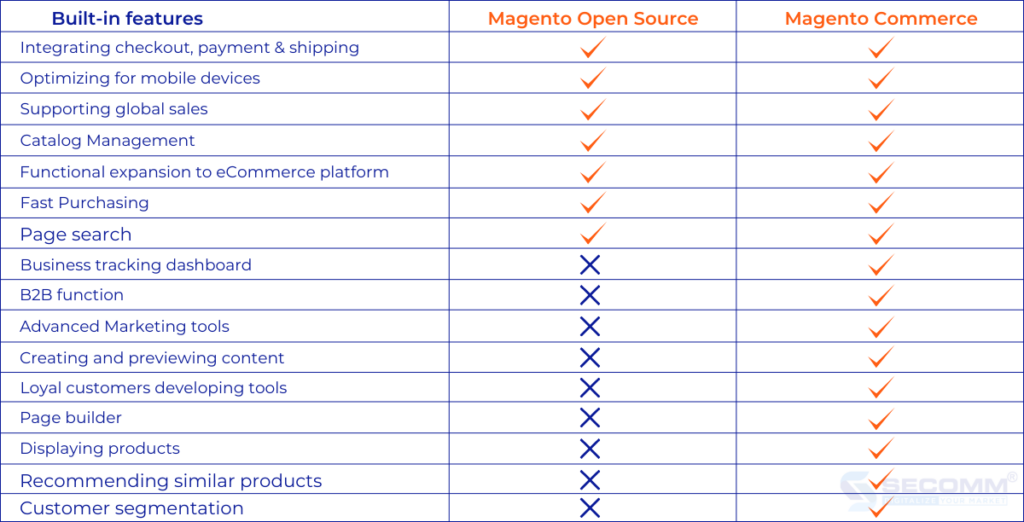
Magento Open Source has fewer features than Magento Commerce because it is a free version. Businesses, on the other hand, businesses can build the necessary functions themselves using extensions from the Magento ecosystem, the community of extension developers, or the project developers with whom Magento collaborates.
Cost
Magento Open Source will require a lower investment than Magento Commerce, from hosting and domains to website development. Nevertheless, the technology infrastructure is the same, so the costs of interfaces and extensions are calculated similarly.
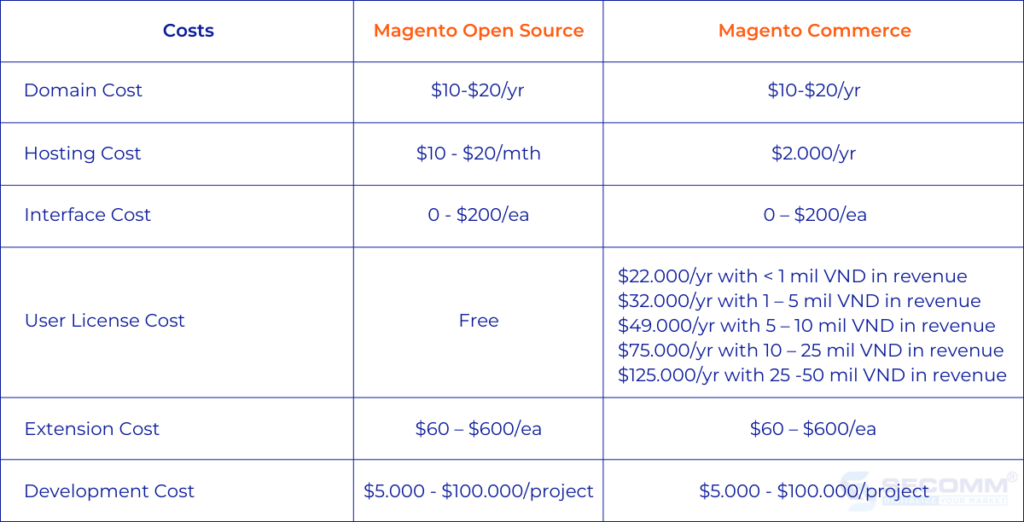
Technical assistance
While Magento Commerce provides global technical support, including cloud service integration, Magento Open Source is not directly supported by the Magento technical team. However, the current Magento Open Source website developers continue to ensure expertise so that the business website is constantly updated and effectively operated.
Should businesses choose the Magento Open Source or Magento Commerce version?
Magento Open Source will be ideal for startups, SMEs (small and medium enterprises), businesses new to eCommerce, and even large corporations that do not yet require Magento Commerce’s advanced functionality system. Because using Magento Open Source is advantageous:
- Spending less money: Eliminate license costs, opt for more affordable hosting, and avoid paying for unnecessary specialized functions.
- Choosing to develop essential business features: Creating specialized functions to address industry and product-specific issues.
- Appropriate for all stages of business growth: Businesses can create basic features and then gradually improve them.
Meanwhile, Magento Commerce will be appropriate for large businesses because:
- Complex functional systems are available: such as Advanced Marketing, Bill of Lading, and Delivery Process Management, to meet global sales needs.
- Dedicated Hosting Service for Websites: Using the same service from Magento developers will ensure that the website works more efficiently.

Choosing the best Magento version will be determined by each company’s long-term eCommerce strategy. However, it is also critical to implement those versions. They must collaborate with professional Magento developers to consult on and implement the best eCommerce solution.
With in-depth experience and developing many complex eCommerce systems on Magento, SECOMM understands the obstacles in choosing a platform and implementing Ecommerce businesses face.
Get in touch with us now for FREE eCommerce development consultancy and solutions
 2
2

 4,863
4,863

 0
0

 1
1
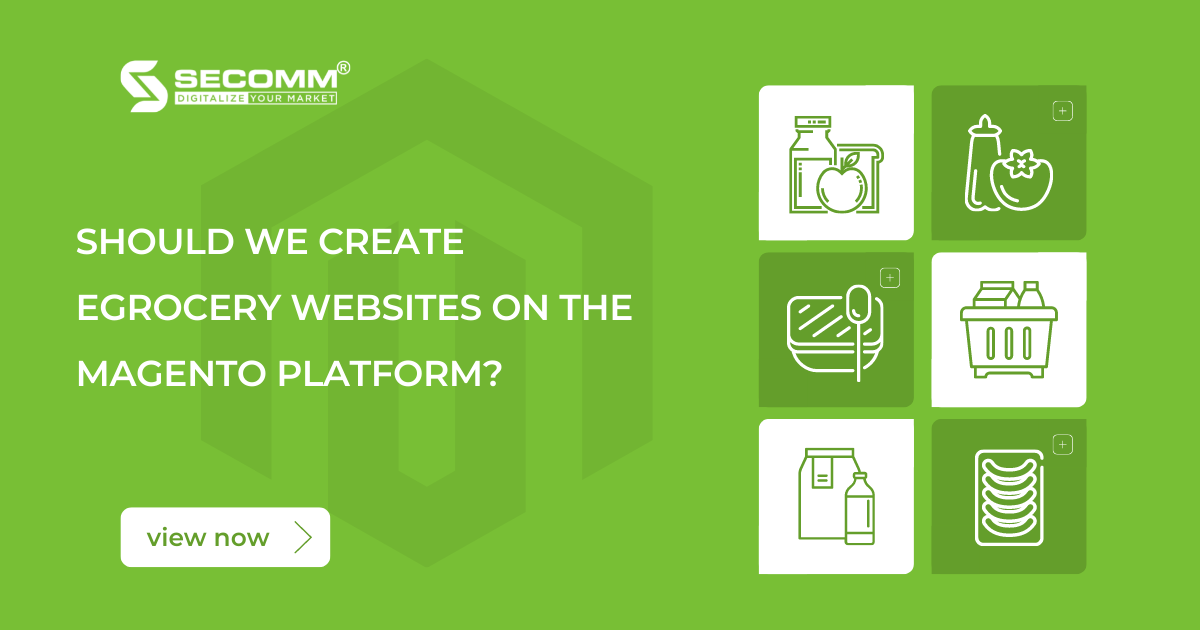
SHOULD WE CREATE PRETTY EGROCERY WEBSITES ON THE MAGENTO?
The growth of the grocery eCommerce industry in the Vietnamese market in 2021 is undeniable. According to the Google report, online grocery-related searches will increase by 223% in 2021, 3.6 times in June, and 11 times in July during Vietnam’s lockdown due to Covid-19 in several provinces.
Recognizing the market’s enormous potential, the need for a professional eCommerce website for online grocery businesses has grown significantly to expand the business system, supporting digital transformation and long-term revenue growth. Some of Vietnam’s largest grocery businesses, including Annam Gourmet Market, Bach Hoa Xanh, Organica, Farmer’s Market, and WinMart, have led the way in developing an eCommerce website system and have seen great success.
Choosing the right platform to build an eCommerce website makes the above brands successful. Platforms play a significant role in developing and operating an effective online grocery website. Along with well-known names such as Shopify, BigCommerce, and WooCommerce, Magento is considered the best online grocery support platform.
The advantages of creating eGrocery websites on the Magento platform
Various approaches to designing a website interface
Businesses have many options when designing the eGrocery website interface on the Magento platform, including using available themes, customizing themes, and creating their own.
Businesses can find Magento-specific themes in the grocery field, developer community, or partner using available themes. It helps businesses reduce the cost of interface design, but it limits businesses’ brand positioning because the interface is easy to duplicate with other websites.

Businesses can save money and add brand identity elements such as colors, fonts, layout, and so on by customizing their themes. However, businesses need a team with extensive Magento expertise and experience to set up and customize the interface efficiently.
Businesses will have a one-of-a-kind website for their brand if they design their interface. However, it will require an enormous investment in development costs and a professional team.
When choosing Magento to develop an eCommerce website, most grocery stores often customize or use their themes to support an in-depth eCommerce business.
Various eCommerce functional systems
The Magento platform provides a comprehensive set of features, ranging from basic to advanced, for the development of professional eCommerce websites. Additionally, Magento allows you to create custom functions to solve specialized grocery industry problems.
Basic functions to assist businesses in running an efficient and smooth website system, such as
- Catalog Management: Manage all data, processes, categories, attributes, prices, inventory quantities, and images/videos to operate and optimize the efficiency of the online grocery store.
- Store Management: Manage product inventory and each branch’s business activities and personnel.
- Cart and Checkout: Manage the shopping cart and customers’ information when they check out.
- Customer Management: Manage customer information to increase marketing efficiency, purchase experience, and customer satisfaction.
- Marketing Management: Optimize SEO and implement marketing strategies with tools to increase business sales.
- Sales Management: Create and manage sales, order, payment, and shipping processes.
- Content Management: Create and optimize all content elements for CMS pages, image storage, customize themes, and design websites.
- System Management: Delegate administrators to review the best methods for website security and maintenance
- Analysis and Report: Support tracking and measuring eCommerce system performance and developing future strategies.
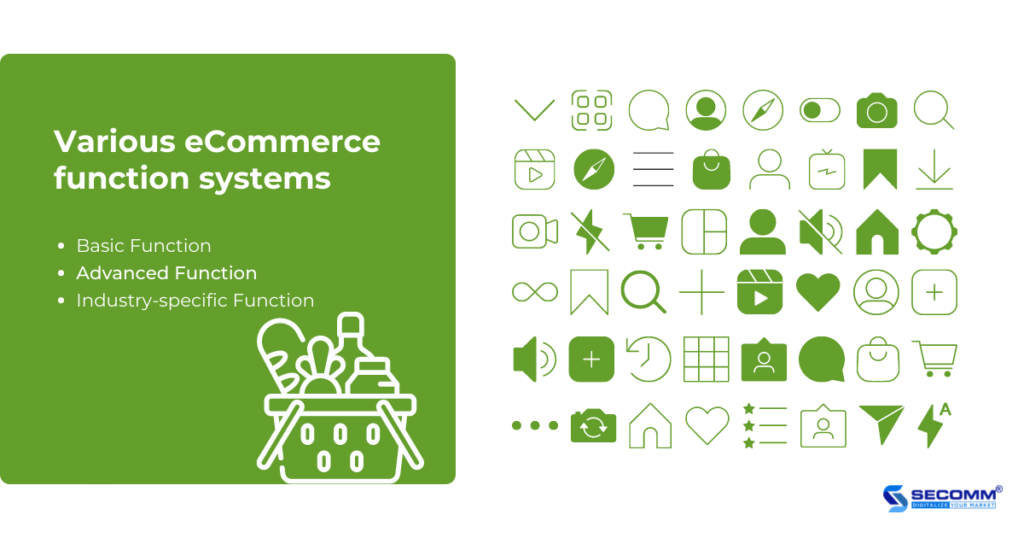
Advanced functions that improve consumers’ online shopping experiences, such as advanced search (Elasticsearch, live-search), MSI (Multi-Source Inventory), abandoned cart, similar product recommendations, PWA (Progressive Web Apps), multi-layered product catalog, and so on.
In addition, industry-specific functions assist businesses in dealing with their problems and reducing mistakes in the online grocery industry, such as order tracking, fast delivery, delivery time and location options, etc.
The ability to expand the system in the future
The high flexibility of Magento open source is an outstanding advantage that helps the system not only operate effectively at present but also expand the system to accompany businesses in the future.
Grocery businesses can fully integrate 3rd party services with Magento, making eCommerce operations efficient and smooth:
- Payment: Integrating with card payments (ATM, VISA, Master Card); e-wallet (MOMO, Zalo Pay); payment gateways (OnePay, VNPay, Paypal), and COD that helps diversify the payment experience.
- Delivery: Integrating with delivery companies like Giao Hang Nhanh, Giao Hang Tiet Kiem, Viettel Post, and order tracking applications aid in the processing and optimizing delivery processes.
- Management software: Integrating with software like ERP, CRM, POS (SAP), Salesforce, and Oracle that help run all businesses’ resources.
- Business analysis tool: Integrating with business analysis tools (Business Intelligence-BI) like Power BI, Tableau, and Looker assists in the improvement of the business strategy and growth plan
Marketing: Integrating with marketing software from Email Marketing (Mailchimp, Getresponse) to advertisement (Facebook, Google, Zalo, Tik Tok) to optimize eCommerce business
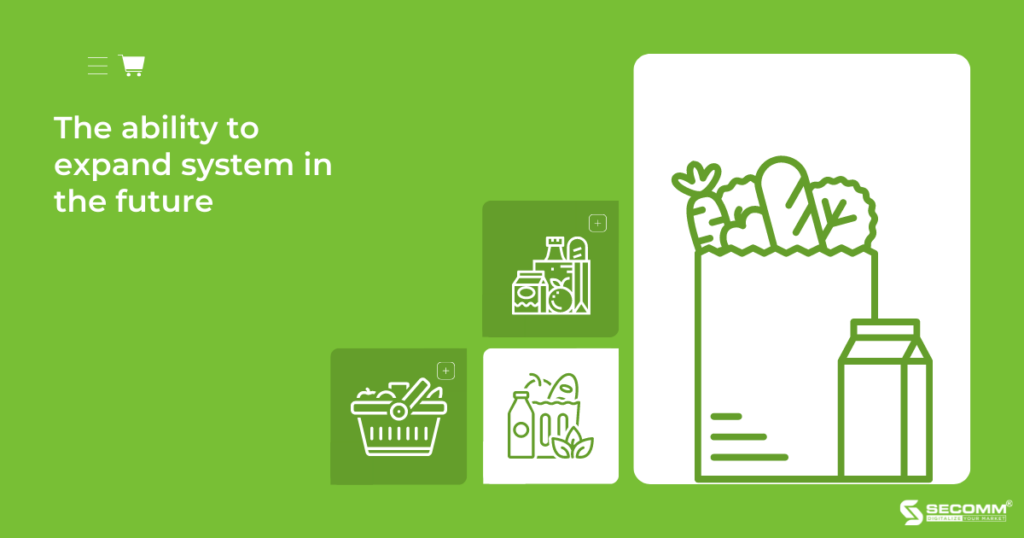
Besides that, Magento also allows businesses to expand from one website, and one store to many websites, and stores, and convert multi-language, and multi-currency flexibly while still being able to manage all data at the same time.
As a result, Magento is a suitable platform for a wide range of business models, including B2C, B2B, B2B2C, and O2O, as well as a wide range of business sizes, including new businesses entering the eCommerce market, startups, SMEs (small and medium enterprises), and large corporations.
Outstanding security
In the path to building a website, security is another significant benefit that makes the Magento platform the preferred platform for online grocery stores.
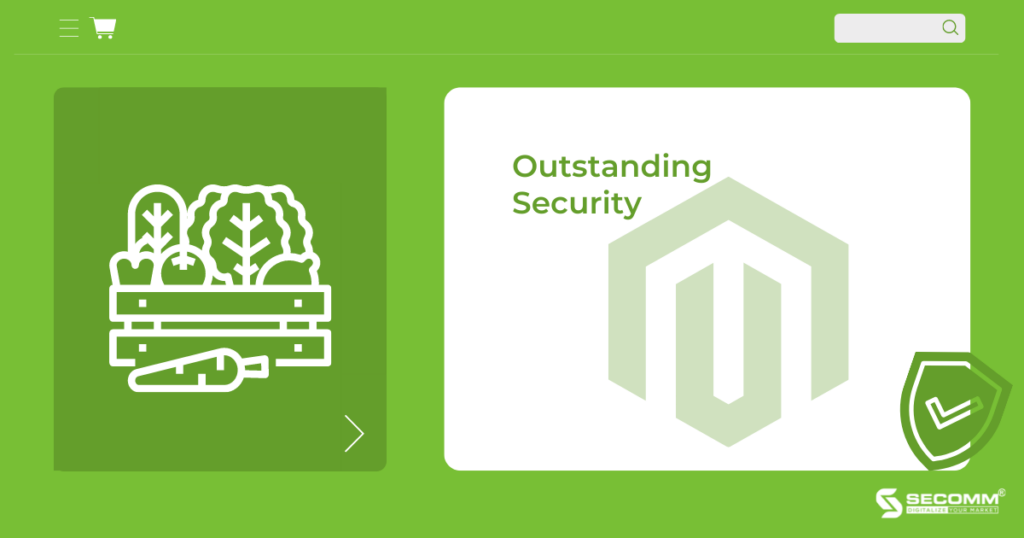
Magento includes a security scan tool that helps identify problems and propose security solutions to handle arising errors, effectively optimizing the security of grocery eCommerce websites. Moreover, to improve admin account security, Magento requires admins to use advanced passwords with at least 7 characters, including letters, numbers, and special symbols. Simultaneously, password complexity can be added to lowercase and uppercase passwords or re-login after a certain amount of login session time. Furthermore, Magento supports two-factor authentication, such as OTP or CAPTCHA code, to strengthen the security of the grocery eCommerce website system.
Diverse ecosystems
The Magento platform has a worldwide developer community that includes many experienced and professional Magento developers.
Magento is also part of the Adobe ecosystem, helping businesses easily access new technology trends and use Adobe’s available application store.
With such a strong development community, online grocery store businesses will receive the most assistance in resolving technical issues and consulting on building eCommerce solutions that are appropriate for their business model.
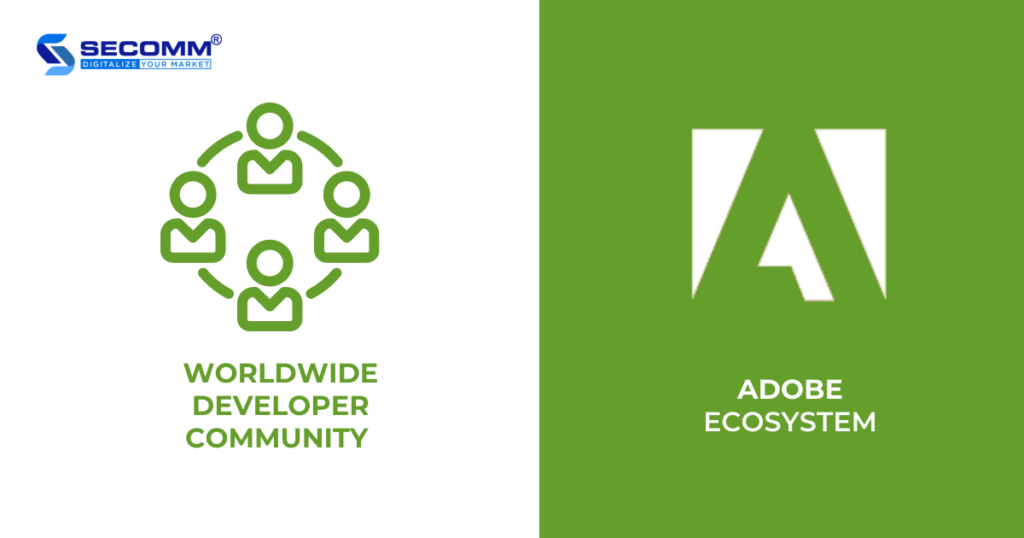
Difficulties in creating an eGrocery website on the Magento platform
High development cost
Although Magento is highly appreciated for its features and performance, the cost issue is still a significant obstacle that makes many eGrocery businesses hesitate to choose Magento.
Implementing a complete eCommerce website system built on Magento costs between $10,000 and $250,000.
| Cost | Magento Open Source | Magento Commerce | Magento Commerce Cloud |
| User licenses | Free | $22.000 -$125.000/yr | $40.000-$190.000/yr |
| Hosting | $100-$500/yr | $500-$6.500/yr | Free |
| Domain | $10-$400/yr | $10-$400/yr | $10-$400/yr |
| SSL Certificate | $50-$300/yr | $50-$300/yr | $50-$300/yr |
| Creating website | $5.000+ | $5.000+ | $5.000+ |
| Developing website | $1.800-$10.000/yr | $10.000+ | $10.000+ |
| Extensions | $60-$600/ea | 60-$600/ea | 60-$600/ea |
| Total | $10.000-$17.000 | $33.000-$149.000 | $50.000-$207.000 |
The table comparing Magento construction costs
Take time to implement
A complete Magento project typically requires 3 to 6 months, with some projects requiring up to a year. As a result, businesses frequently waste time because of the complex functional system and the scarcity of Magento experts.
Professional team required
Businesses require a professional team with a deep understanding of Magento as well as practical experience on highly complex systems to implement an effective eGrocery website using Magento.
Annam Gourmet’s case study
Although Annam Gourmet has previously owned a website, it is primarily used for brand development, and the effectiveness of eCommerce activities has not been prioritized. As a result, this website system is not comprehensive and is limited to crucial eCommerce functions. Furthermore, to transition into the “new normal”, Annam Gourmet must expand its online sales channel more intensively and effectively.
In order to meet the needs mentioned earlier, as well as to support the company’s long-term development goals in the Vietnamese market, Secomm and Synova successfully built a complete eCommerce website system on the Magento 2 platform.
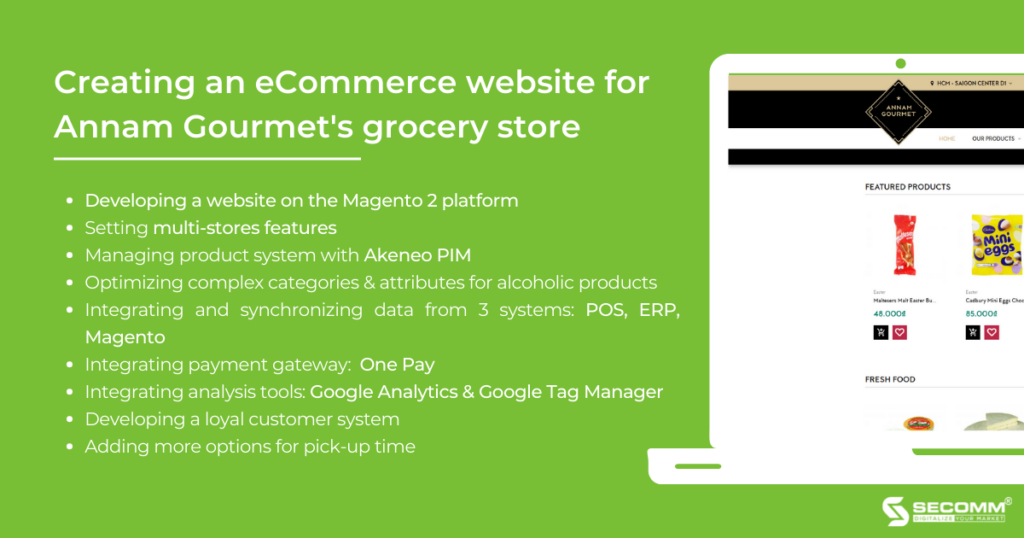
The Magento 2 website system is operationally stable and effective with other components in Annam Gourmet’s operating system. As a result, Annam Gourmet’s eCommerce website, with typical grocery industry elements, is capable of meeting all business needs, such as operating effectively in a highly complex system, quickly processing huge amounts of data about products, customers, and orders, and seamlessly syncing with ERP, CRM, POS, and so on.
In general, when building a grocery eCommerce website with Magento, businesses can master everything from interface design to feature system, leveraging a diverse ecosystem, a system capable of flexible customization, and superior security. On the other hand, businesses must prepare and invest in a budget, time, and team to successfully and effectively implement it.
Our company – SECOMM, has been partnering with many big enterprises such as An Nam Group (Vietnam), Jasnor (Australia), and Changi Airport Group (Singapore). As a result, we are aware of the challenges and worries firms face while developing an eCommerce website system.
Get in touch with us now for FREE eCommerce consultancy and solutions in eGrocery businesses.
 2
2

 2,005
2,005

 0
0

 1
1
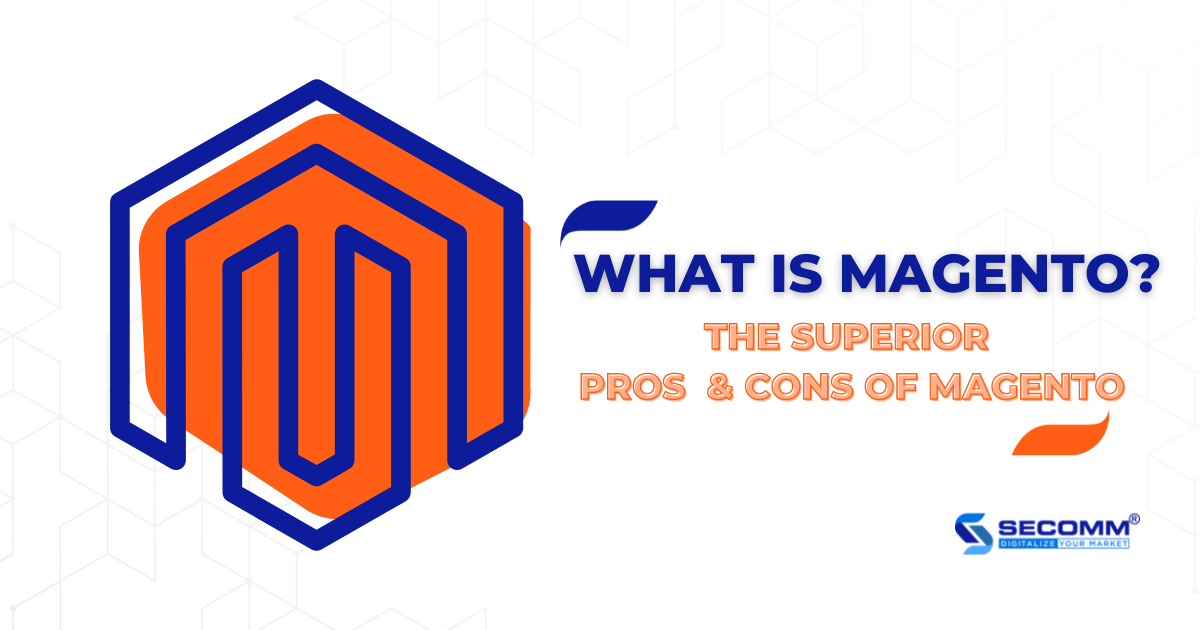
WHAT IS MAGENTO? THE 7 IMPORTANT PROS AND CONS OF MAGENTO
Along with the eCommerce market growth comes an increase in business demand for a separate eCommerce website system to maximize online business.
The platform’s role in developing and operating an effective eCommerce website system is enormous because choosing the right platform will help businesses save time in building a team, saving system development costs, reaching potential customers, boosting sales, and seizing long-term sustainable development opportunities.
Among today’s popular platforms such as Shopify, BigCommerce, WooCommerce, and others, Magento is widely regarded as the best platform for developing eCommerce websites, with over 186,000 websites in use worldwide.
What is Magento?
This is an open-source platform designed specifically for the eCommerce industry. In addition, it is the most challenging source code platform in the PHP programming language. As a result, Magento can handle a company’s specialized needs in a constantly changing and evolving market like eCommerce.
Many major brands and corporations, including HP, Asus, Puma, and Walmart, have used the platform. In addition, some famous brands in Vietnam use Magento websites, including CellphoneS, Vua Nem, Kids Plaza, Mobile Viet, and so on.
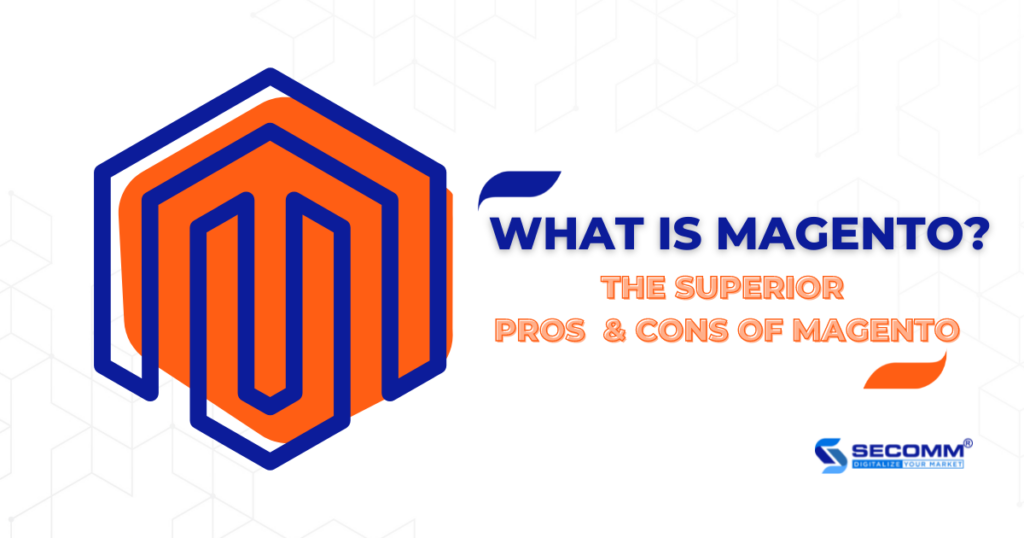
Classification
Magento currently offers two versions: Magento Open Source and Magento Commerce.
Magento Open Source
Magento Open Source was initially called Magento Community Edition, a free version of Magento. This version provides a “framework” to build eCommerce websites flexibly, so it is very popular with many businesses.
Some websites use Magento Open Source in Vietnam, such as Canifa, Kids Plaza, Bach Long Mobile, etc.

Magento Commerce
Magento Commerce was previously known as Magento Enterprise Edition. This version is appropriate for significant businesses that require a website system with complex functions.
In addition, this edition provides an on-premises or a hosted solution as a service (Magento Commerce Cloud), which aids in website performance. The minimum fee for using this version is $24,000 per year.
The brands using Magento Commerce in Vietnam are CGV, Bibo Mart, Rohto, etc.

The Pros
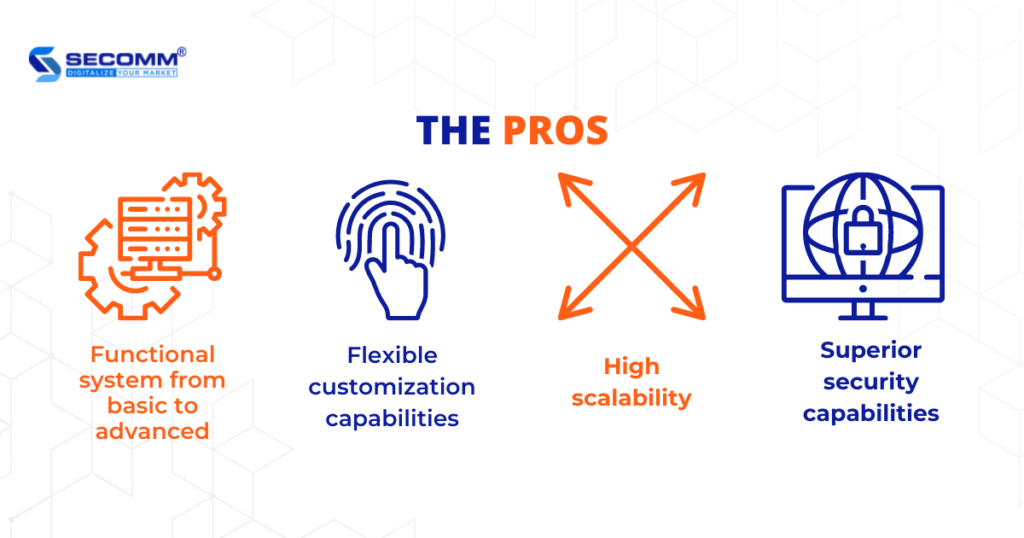
Functional systems from basic to advanced
Magento includes all of the features required for a complete eCommerce website, including category management, content management, sales management, marketing management, and customer management, as well as analysis and reporting.
In addition, Magento owns many extensions with advanced features such as Headless Commerce, PWA (Progressive Web Apps), MSI (Multi-Source Inventory), ElasticSearch, etc to meet all eCommerce needs for businesses.
Furthermore, Magento has a global technical support community comprised of many experienced experts and professional development units to assist with meeting all business requirements.
Flexible customization capabilities
Magento possesses all the advantages of an open-source platform with flexible customization capabilities. Owning and controlling the entire source code, in particular, allows businesses to customize parts of the code in the system, easily update, or even develop new functions based on each business specificity.
High scalability
In addition to customizing, Magento also has very useful website scalability. Magento allows businesses to scale from one website to many websites, one store to many stores, but the management is still on the same system. Besides, Magento supports multi-language and currency conversion, helping businesses expand globally.
Superior security capabilities
Magento’s high security is also an outstanding advantage, with the ability to control the system regularly, propose security solutions, improve security for administrators, and prevent bots or unauthorized malware, among other things. As a result, this platform assists businesses in reducing potential risks associated with the data and transaction processes.
The Cons
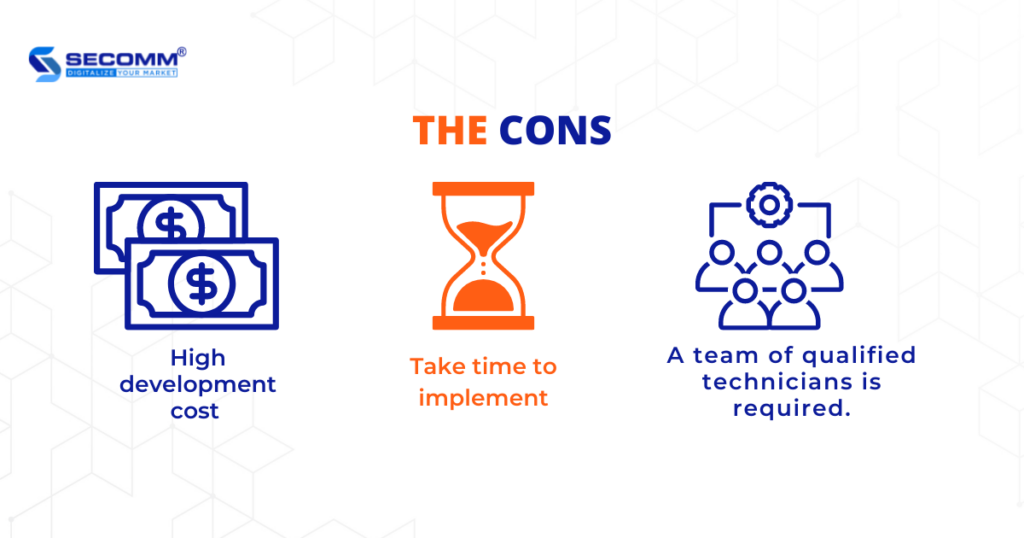
High development cost
The cost of owning a Magento website is high due to its many outstanding benefits, such as the functional system, customizability, scalability, and good security. However, depending on the system’s complexity, a website built on the Magento platform costs between $10.000 and $100.000.
Take time to implement
A comprehensive Magento project requires implementation time ranging from 3 months to 1 year. A complete Magento project requires implementation time ranging from 3 months to 1 year. As a result, it slows down businesses’ digital transformation processes and makes it difficult for them to keep up with competitors’ development rates and market trends.
A team of qualified technicians is required
Businesses require a technical team with high expertise and experience with the Magento platform to build and operate an intensive eCommerce website system customized to the unique characteristics of each product and category.
As a whole, Magento is an eCommerce platform that is appropriate for all types of businesses, including startups, SMEs (small and medium enterprises), and large corporations. However, budget, time, and professional team issues have caused many SMEs businesses to be hesitant to use Magento to develop eCommerce websites. That is why Magento frequently be used in large corporations to build complex eCommerce systems.
Our company – SECOMM, has been partnering with many big enterprises such as An Nam Group (Vietnam), Jasnor (Australia), and Changi Airport Group (Singapore). As a result, we are aware of the challenges and worries firms face while developing an eCommerce website system.
Contact SECOMM now for a free consultation on detailed eCommerce system development solutions!
 2
2

 3,257
3,257

 0
0

 1
1
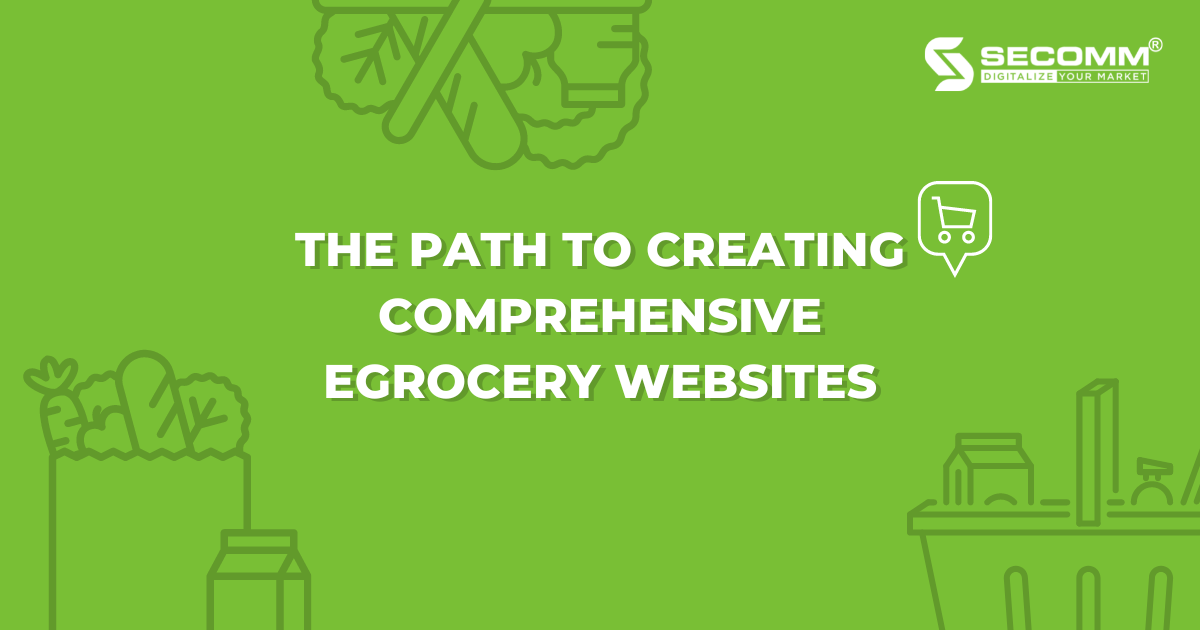
THE PATH TO CREATING COMPREHENSIVE EGROCERY WEBSITES
According to Statista, the size of the Vietnamese ecommerce market in 2021 was $13 billion and is expected to reach $39 billion in 2025, ranking second in Southeast Asia behind only Indonesia. The spectacular breakthrough of the grocery eCommerce industry has coincided with the explosion of the eCommerce market. As a result, online grocery shopping has become a part of 53 percent of consumers’ habits.
Grocery companies should create their eCommerce website as soon as possible to jump into the bigger game and develop online grocery business activities to capitalize on the enormous potential of the eGrocery market and gradually transition to digital transformation.
SECOMM has outlined the journey to create a comprehensive eGrocery website for the Vietnamese market with over 7 years of experience in eCommerce.
The initial stage: Basic eGrocery website development
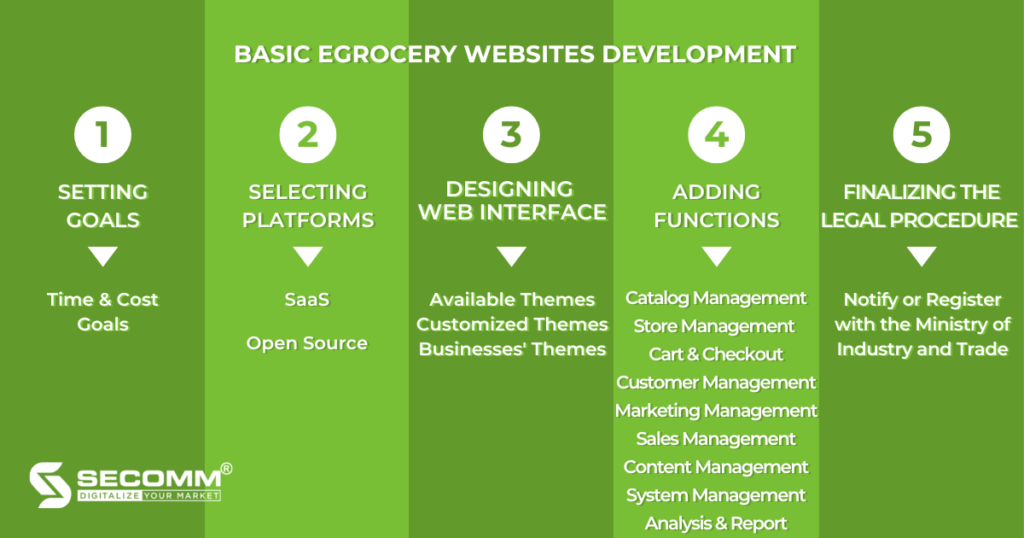
Setting goals for the development of the eGrocery website
The first step for grocery businesses is to set goals and prioritize those goals to plan the result of an appropriate eCommerce website for each stage.
Businesses can consider long-term goals such as brand positioning, exploitation of potential customers, and product online business capability.
Short-term goal activities such as revenue growth, customer monitoring and analysis, campaign effectiveness evaluation, and so on should prioritize by businesses.
Furthermore, the user experience factor, which includes services such as payment, logistics, online customer care, and so on, is critical to increasing interaction, support, customer consultation, and problem resolution as quickly as possible.
In terms of duration, businesses can choose to deploy quickly to penetrate the eGrocery market or gradually adapt to the market at this stage. When deploying a grocery ecommerce website, the budget will be determined by each business’s strategy and financial potential.
Selecting a basic eGrocery website development platform
Two popular platforms assist businesses in developing eCommerce websites: SaaS (Software as a service) and Open Source. Here are some of the best Saas eCommerce platforms: Haravan, Shopify, and BigCommerce.
- Pros: Rapidity, reasonable price, no IT experience requirement
- Cons: Operating costs rise over time as a result of annual/monthly service license payments, platform developer reliance due to lack of ownership of source code and data, and limited functions such as the ability to integrate and expand the website system.
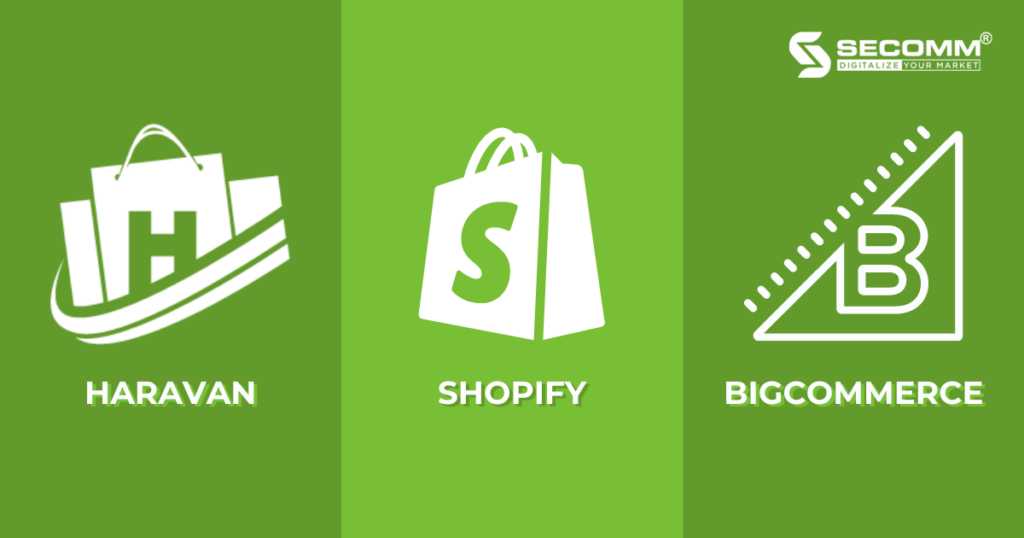
Open Source eCommerce Platforms widely used in the Vietnamese market include WooCommerce, OpenCart, and Magento.
- Pros: The user owns the source code and data, has more interfaces and functions, and has better integration and extensibility than SaaS platforms.
- Cons: It takes more time and cost to develop the website initially than SaaS platforms. Also, it requires an experienced IT team to handle its system.
Due to the significant differences between SaaS Platforms and Open Source Platforms, stage businesses prefer to use SaaS Platforms in the initial stages of basic eGrocery
Designing the interface of the eGrocery website
Businesses have to meet the following criteria when designing the website interface: UI/UX standardization, displaying the brand’s and the eGrocery industry’s characteristics, and product presentation synchronization to provide the best experience to customers.
There are three approaches to designing the interface: using available themes, customizing themes, or creating their own. Businesses frequently use the available themes in this stage to save the most money. Still, some companies with financial potential will choose the other two options for better branding.
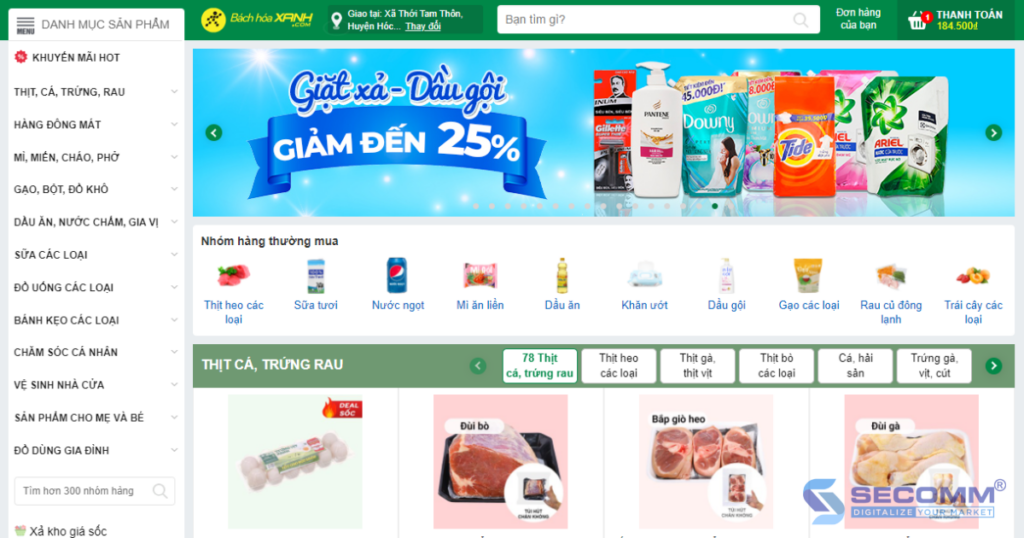
Adding functions to the eGrocery website
When operating a grocery eCommerce system, businesses can prioritize the development of basic functions to meet the essential needs during this time.
Some basic functions required in eGrocery websites, such as:
- Catalog Management: Manage all data, processes, categories, attributes, prices, inventory quantities, and images/videos to operate and optimize the efficiency of the online grocery store.
- Store Management: Manage product inventory and each branch’s business activities and personnel.
- Cart and Checkout: Manage the shopping cart and customers’ information when they check out.
- Customer Management: Manage customer information to increase marketing efficiency, purchase experience, and customer satisfaction.
- Marketing Management: Optimize SEO and implement marketing strategies with tools to increase business sales.
- Sales Management: Create and manage sales, order, payment, and shipping processes.
- Content Management: Create and optimize all content elements for CMS pages, image storage, customize themes, and design websites.
- System Management: Delegate administrators to review the best methods for website security and maintenance
- Analysis and Report: Help track and measure eCommerce system performance and develop future strategies.
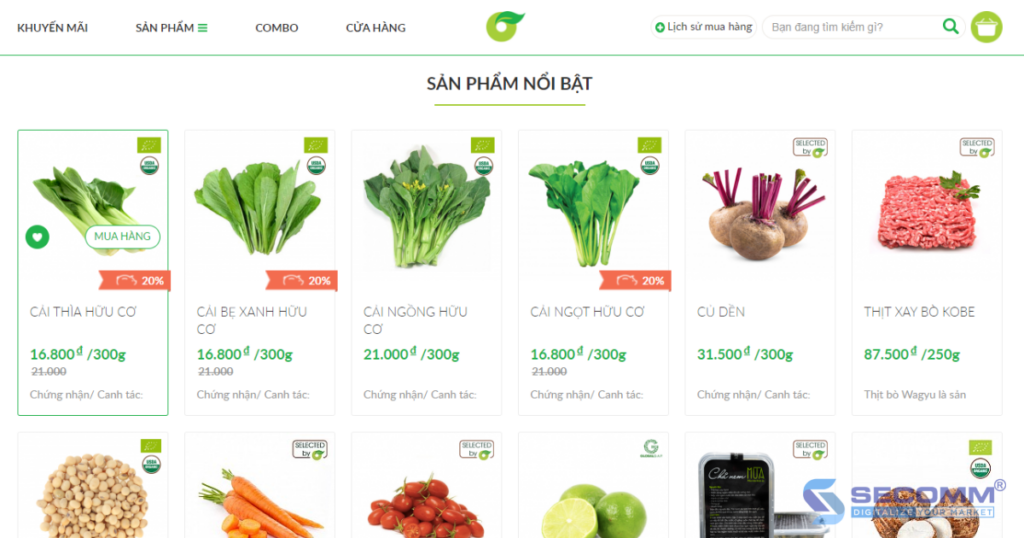
Finalizing the legal procedures
According to Decree 52/2013/ND-CP of the Government, every individual or organization that owns a sales eCommerce website must notify or register with the Ministry of Industry and Trade on the eCommerce Operation Management Portal.
Websites that exceed the time limit or fail to register/notify the competent management agency within the time frame specified will be administratively sanctioned by regulations.
The following stage: Advanced eGrocery website development
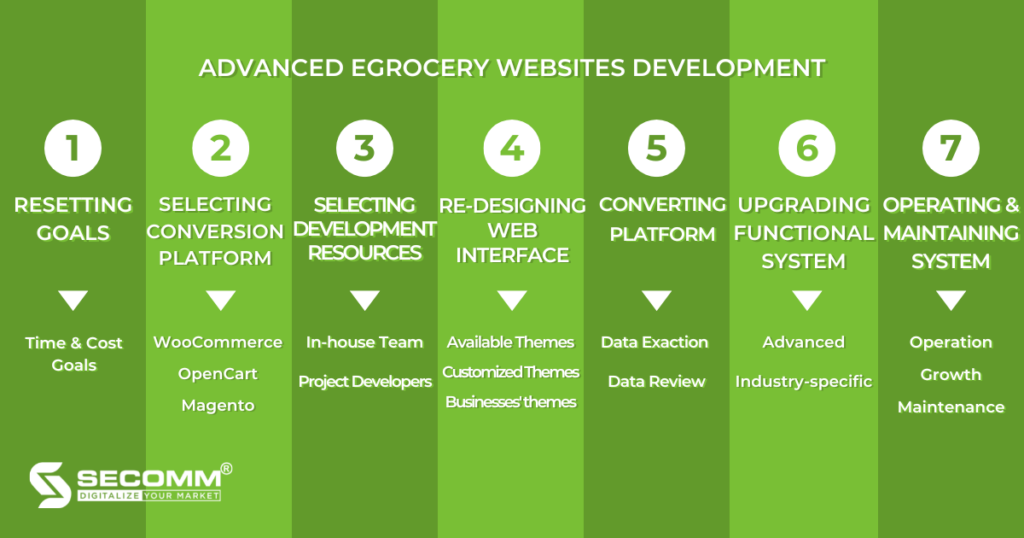
Re-targeting
As the company grows and the market changes, the goals must be adjusted accordingly. This is also the time for leaders to rethink the business strategy’s target and money to invest in the grocery eCommerce website system. During this time, businesses frequently focus on the short and long-term goals of expanding the online grocery store system.
Long-term business goals can include expanding market segments, developing loyalty programs, forming consumer online shopping habits, etc.
Short-term goals for businesses can include capturing more new potential customers, increasing revenue, and supporting Ecommerce Marketing strategy.
Selecting platforms for conversion
When SaaS platforms are no longer effective enough to help businesses expand their online grocery store website systems, they have to turn to Open Source platforms like Magento, WooCommerce, and OpenCart to build advanced eGrocery websites.
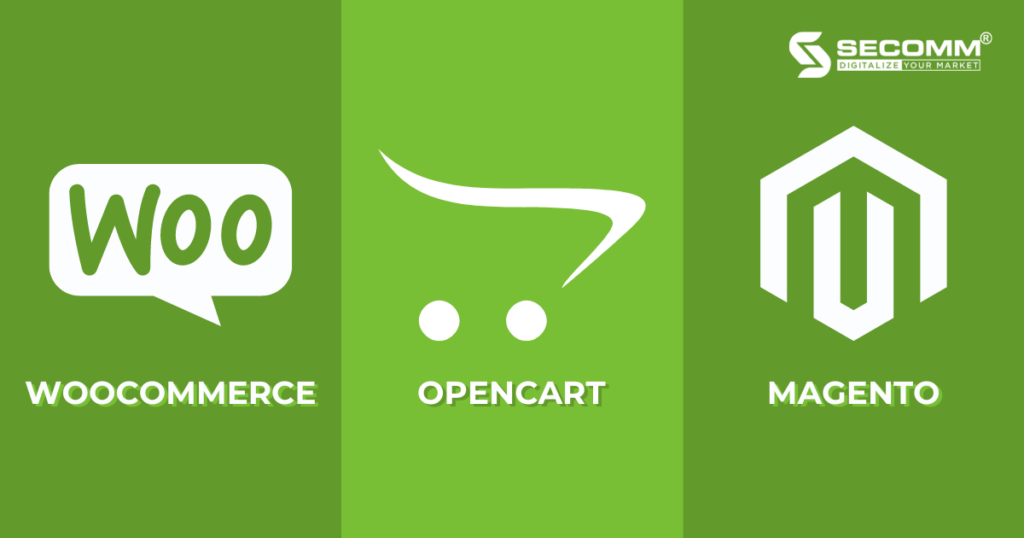
In this stage, platform selection criteria include:
- Professional website interface, UX / UI standardization, displaying the brand’s and the eGrocery industry’s characteristics.
- Comprehensive functional system from basic; advanced to industry-specific
- Flexible customization and extensibility, allowing businesses to integrate with a wide range of third-party utilities and support multiple websites, multi-language, and multi-currency.
- High security, assisting businesses in avoiding network attacks, and assisting with data backup when needed
Absolutely, businesses will face more challenges when switching platforms from SaaS to Open Source, such as changing costs, time to train personnel on open platforms, and data loss or errors during the conversion.
Selecting the development resources (In-house team or Project developer)
Businesses must choose the right resources to develop their website to build eCommerce website on an open source platform. Typically, companies can create an in-house team or find a project developer. Regardless of the resource, professional knowledge and practical experience about the chosen platform are required.
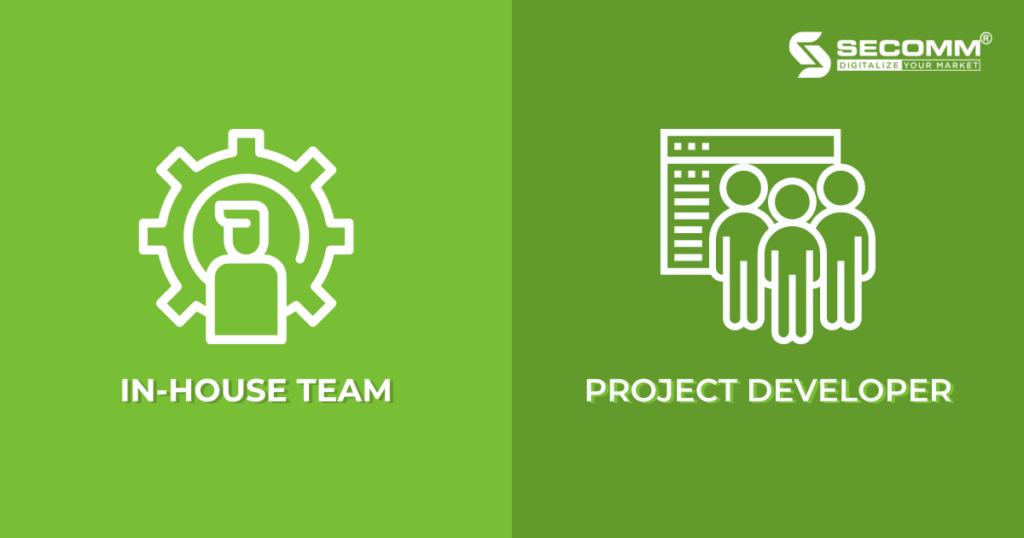
Businesses should recruit and train IT and eCommerce personnel with expertise and experience in the chosen platform. Building the right team will take a lot of time and money. Still, it will help businesses manage resources better and actively edit or develop the website system according to the requirements.
Businesses should look for project developers based on the following criteria to collaborate with them:
- Ecommerce experience (the number of years of experience, the quantity and the quality of projects they have done, and the complexity of projects).
- The professional team (solution consultants, IT personnel, customer service).
- Good process (analyzing, proposing solutions, developing, testing, and maintaining).
- Fast processing and support capabilities.
- Warranty and maintenance commitments.
This will help businesses learn expertise, gain experience, and develop a website in all aspects of the eGrocery industry. Still, companies and their partners must collaborate effectively to achieve a better result.
Re-designing the interface of the eGrocery website
Businesses can keep things the same while switching platforms. There is no need to change the current website interface. Many companies, however, will rebuild the website interface to match the new strategy and platform.
Similar to the previous stage, businesses have several options when designing the interface of a grocery eCommerce website: using available themes, customizing the themes, or creating their own. At this stage, however, businesses frequently choose to customize or design their own theme to reflect the characteristics of the eGrocery brand and industry.
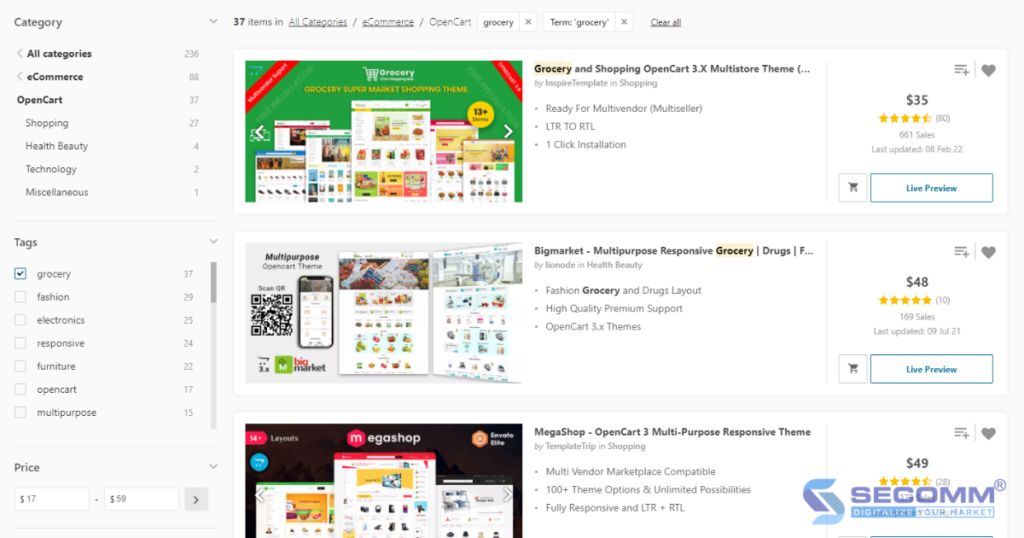
Converting platform
After selecting the appropriate conversion platform, the conversion should be carried out carefully to limit the risk of data loss or enterprise error. To avoid errors, the conversion is usually done as automatically as possible.
The platform conversion process includes steps to extract data from the old system and record it into the new system. After converting the platform, businesses need to double-check to ensure that the converted data is fully and correctly according to the plan.
Upgrading functional system
In addition to the basic functions, businesses should focus on developing a more complex system of functions, including advanced and industry-specific functions for the eGrocery industry.
Advanced functions include order tracking, abandoned cart, similar product recommendations, advanced product search, multilayer product catalog, and others that improve the consumer experience and speed up the shopping process.
Industry-specific functions aid in thoroughly resolving the challenges of implementing intensive departmental eCommerce, meeting the needs of customer segments and businesses such as fast delivery, delivery time selection, and so on.
Furthermore, businesses must constantly update and develop user-friendly functions to stay competitive in the market.
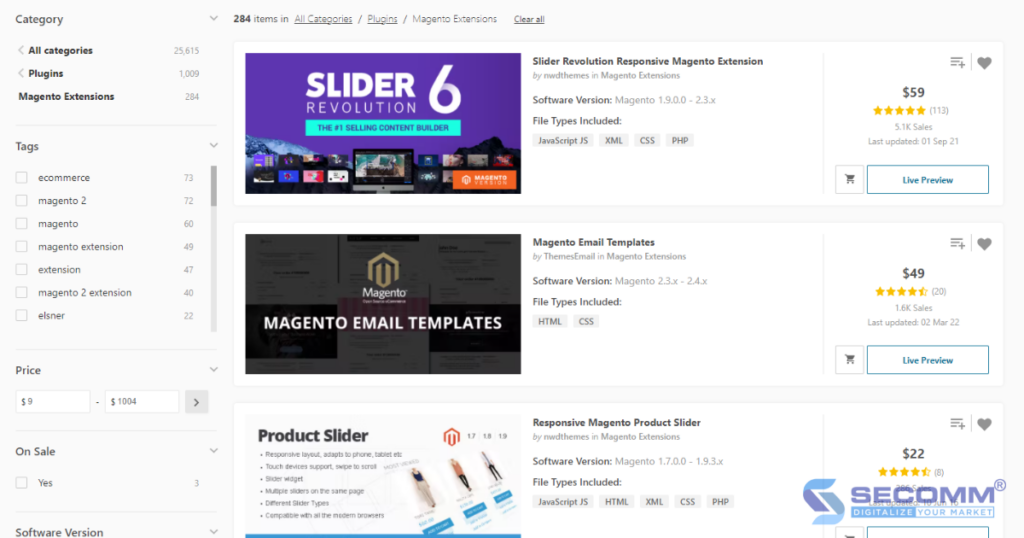
Operating and maintaining the eGrocery website system
When putting the grocery eCommerce website system through testing, businesses must review and test the entire website and functionality in a specific time frame to ensure order processing speed, website stability, and so on. In addition, businesses must immediately contact the in-house team or the developer if issues arise to adjust and improve the website before going live.
After the grocery eCommerce website system has stabilized, businesses should focus on Ecommerce Marketing strategies (SEO, SEM, Email Marketing, Content Marketing, Social Marketing, and so on) or implement Omni-channel to grow their online eGrocery business.
For long-term sales growth, businesses should maintain, update, and upgrade their website system regularly, quickly adapting to changes in the eCommerce market in general and the grocery market in particular.
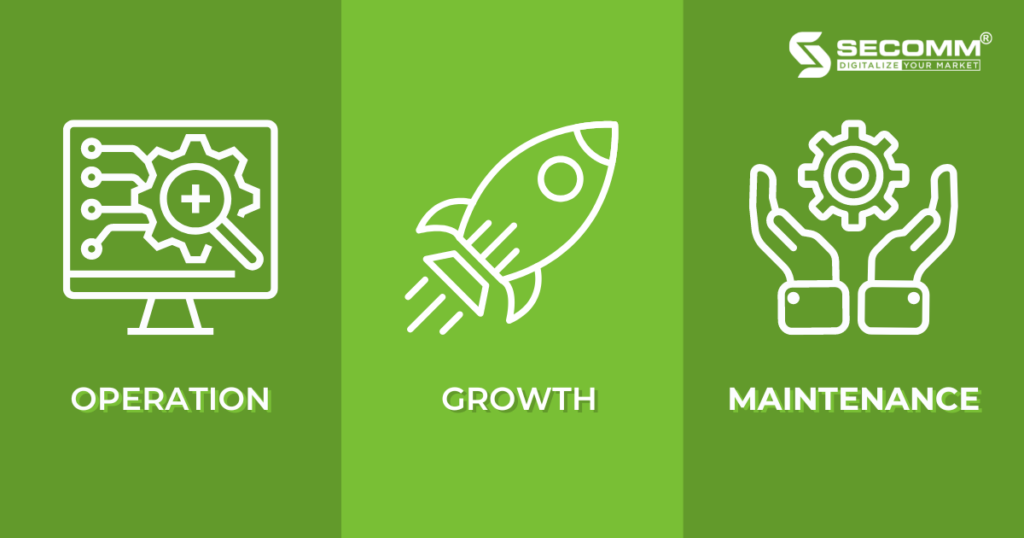
In general, developing comprehensive eGrocery websites for the Vietnamese market is complex. It requires businesses to invest significant time and money in researching the best eCommerce strategy for each stage of business development.
Our company – SECOMM, has been partnering with many big enterprises such as An Nam Group (Vietnam), Jasnor (Australia), and Changi Airport Group (Singapore). As a result, we are aware of the challenges and worries firms face while developing an eCommerce website system.
Get in touch with us now for FREE eCommerce consultancy and solutions in eGrocery businesses.
 2
2

 2,676
2,676

 1
1

 1
1
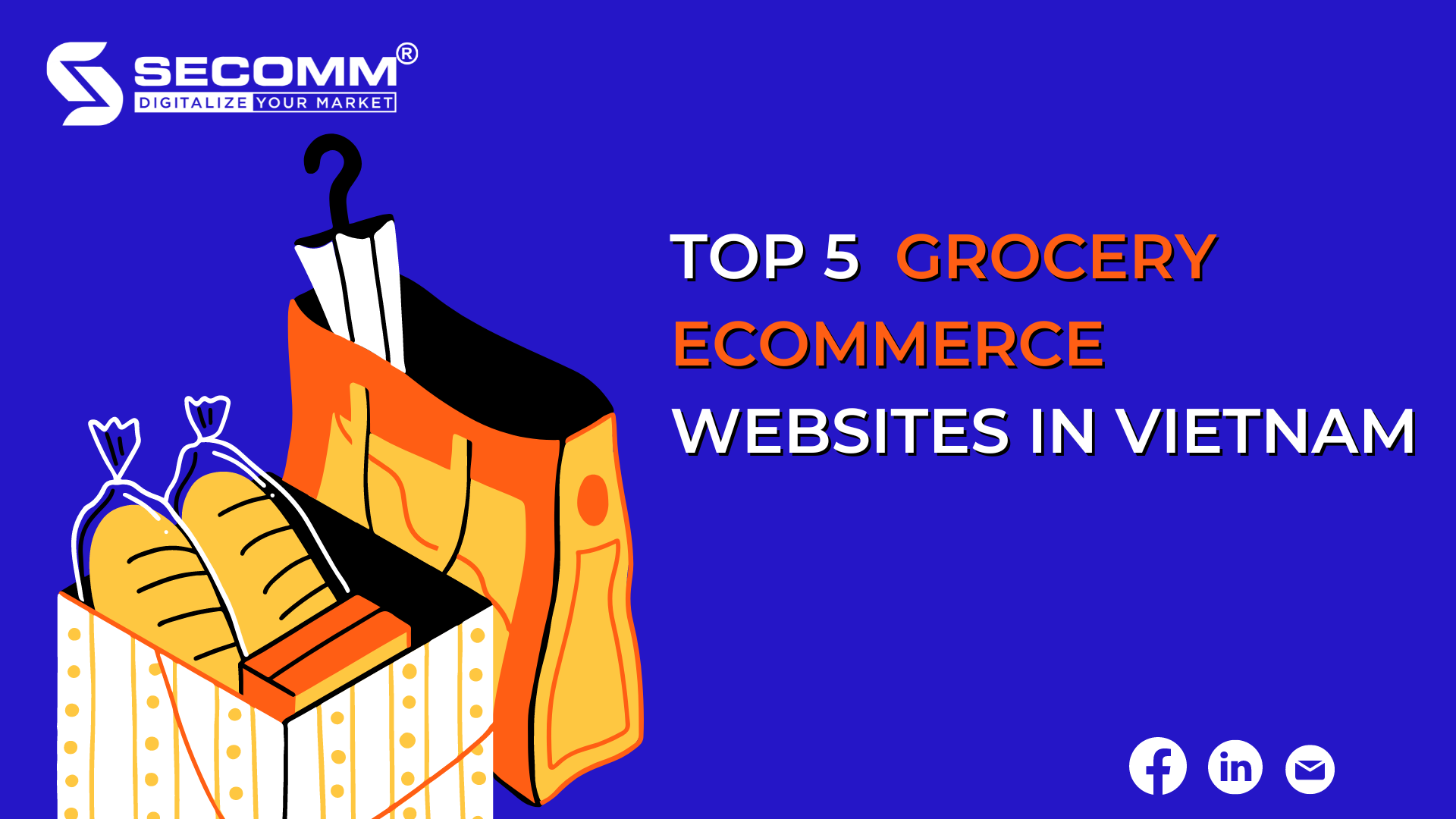
TOP 05 GROCERY ECOMMERCE WEBSITES IN VIETNAM
Grocery eCommerce is a trend in eCommerce that allows customers to buy goods online. This is regarded as the leading industry in the eCommerce market, particularly in Vietnam. According to an iPrice report, when people began staying at home to avoid the Covid-19 epidemic, traffic to websites specializing in the grocery business increased 45% faster than before. This trend remained stable after the social distancing was reduced, increasing by 10% at the end of the year. Online grocery is the only category that has seen consistent growth throughout the pandemic, with search demand continuing to rise.
There are some popular grocery eCommerce websites in Vietnam can be mentioned as:
Bach Hoa Xanh
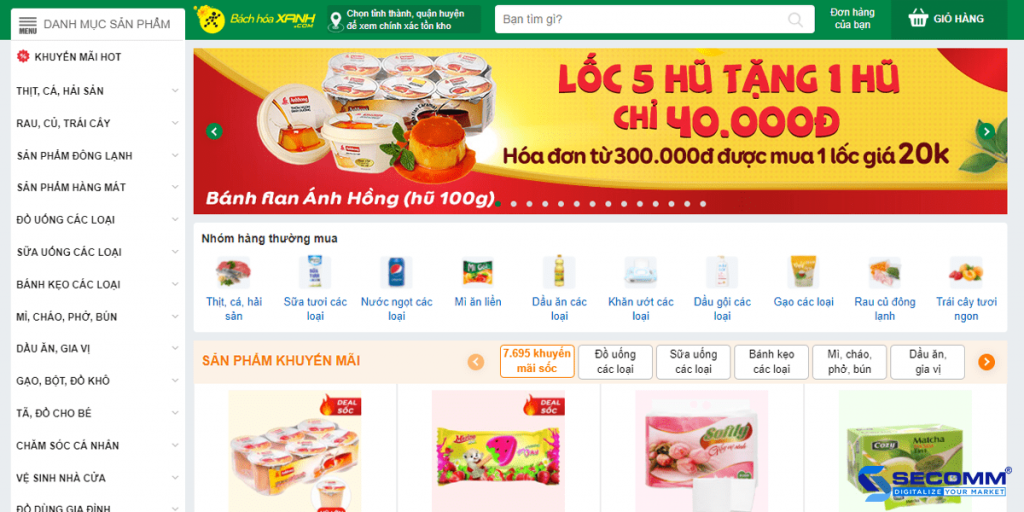
Bach Hoa Xanh is one of the most popular grocery store chain owned by Mobile World Joint Stock Company that specializes in selling fresh food and necessities. Bach Hoa Xanh currently operates nearly 2,000 stores in the South, East, and South Central provinces. This is the most visited website in the top five most visited websites in the Vietnam market, behind only the top four eCommerce platforms today, namely Shopee, Lazada, Tiki, and Sendo (According to iPrice).
– Website: https://www.bachhoaxanh.com/
– Traffic: 1.1M/month
WinMart

WinMart is a supermarket system and grocery store chain purchased by Masan Group from Vingroup. This brand was more commonly known as Vinmart at that time.
– Website: https://winmart.vn/
-Traffic: 209.5K/month
Organica

Organica is a natural and non-GMO certified organic food development and distribution system.
– Website: https://www.organica.vn/
– Traffic: 27.2K/month
Farmer’s Market

Farmer’s Market is a fresh food chain store brand managed by LARIA Trading Co., Ltd. To provide a seamless shopping experience O2O (online to offline), the company has built an omni-channel retail system serving over 4,000 customers daily.
– Website: https://farmersmarket.vn/
– Traffic: 17.5K/month
Annam Gourmet

Annam Gourmet arose from the two Annam Group founders’ deep love of European cuisine. Annam Gourmet chain stores have been successfully operating in the Vietnamese market for over 20 years, offering high-quality imported product lines such as high-end food, wine, beverages, and cosmetics.
– Website: https://shop.annam-gourmet.com/
-Traffic: 8.7K/month
Grocery eCommerce Solutions
With a 200% annual growth rate, the future potential of grocery eCommerce in the Vietnamese market is undeniable (according to Statista). There are numerous opportunities in the eGrocery industry. Recently, many challenges have arisen, necessitating careful consideration of tactics by business managers in order to take the most effective steps.
The eGrocery businesses have opportunities and challenges, requiring business managers to consider tactics to take the most effective steps. Finding a partner is tricky and building an in-house team is tough. Businesses must incur significant opportunity costs and time to reach the goal.
Our company – SECOMM has been partnering with many big enterprises such as An Nam Group (Vietnam), Jasnor (Australia), and Changi Airport Group (Singapore). We are aware of the challenges and worries faced by firms while developing an e-commerce website system.
Get in touch with us now for FREE eCommerce consultancy and solutions in eGrocery businesses.
 2
2

 4,591
4,591

 0
0

 1
1
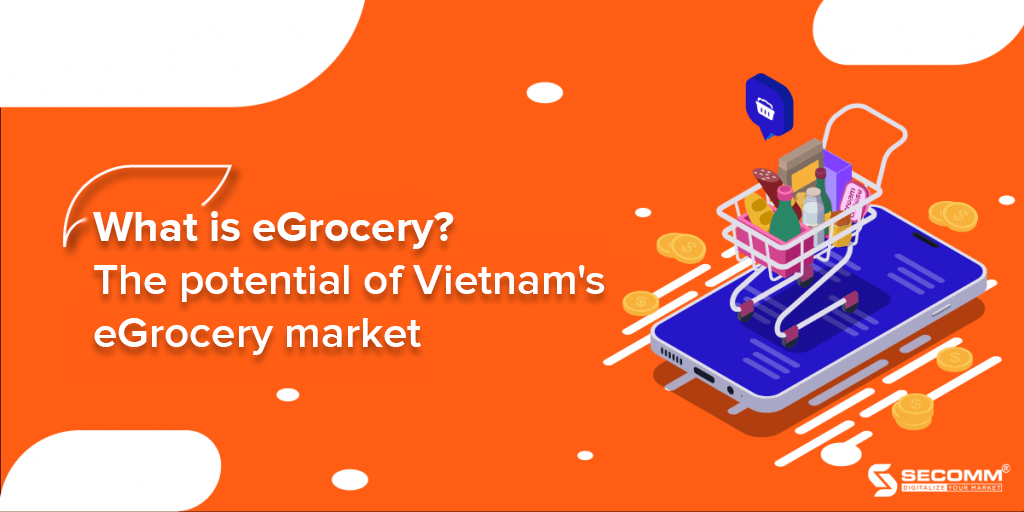
WHAT IS EGROCERY? THE POTENTIAL OF VIETNAM’S EGROCERY MARKET
According to the VISA’s data in 2021 – the world’s leading electronic payment technology company, up to 87% of Vietnamese consumers surveyed are currently using home delivery services, of which 82% said that the first time they used this service was since the Covid-19 outbreak occurred.
That further confirms that social distancing and work-from-home models have led to significant consumer shopping behavior changes. In particular, the transition from the direct shopping experience to e-commerce has taken place rapidly in just a few months. One of the industries that have benefited the most from the boom in the e-commerce market is eGrocery.

So, what is eGrocery?
eGrocery (or Grocery Ecommerce) includes online business activities of grocery products such as food (both fresh and prepackaged), household products, healthcare, personal care, etc. Product display, ordering to pay, and shipping are all done on the website of eGrocery businesses.
Some successful eGrocery businesses in the Vietnamese market are Bach Hoa Xanh, An Nam Gourmet, Organica, Farmer’s Market, etc.
The potential of Vietnam’s eGrocery market
Covid-19 is a powerful catalyst, one of the impulses to boost the grocery industry’s demand for shopping for essential products. According to a report from iPrice, websites specializing in the grocery business grew by 45% in traffic when people started staying at home to prevent the epidemic. After the social distancing eases, this trend remains stable, increasing by 10% by the end of 2021. eGrocery is the only industry that has maintained solid growth throughout the pandemic since the beginning of the pandemic, with search demand still increasing steadily.
Additionally, with revenue coming from the U.S, the worldwide eGrocery market is also highly active. The grocery e-commerce business is anticipated to surpass $20 billion in 2021 and $24 billion in 2023 (Statista). According to Redseer’s report, India’s eGrocery market is estimated to reach $10.5 billion by 2023.
Seeing the vast potential that the eGrocery market may bring, now there are many “big guys” not from the traditional grocery industry who also jump in to fight for this lucrative “piece of cake” like Con Cung, Kids Plaza, etc.
Case Study
BigBasket – The giant in the eGrocery market in India
BigBasket was founded in 2011 by V.S. Sudhakar, Hari Menon, V.S. Ramesh, Vipul Parekh, and Abhinay Choudhari. In May 2021, Tata Group’s acquisition of 64% of BigBasket shares helped push BigBasket’s valuation to $1.85 billion.

By promoting the research and development of transportation services and expanding the logistics function system in the enterprise’s e-commerce website, in 2016, BigBasket made fast deliveries within 60 minutes. In the same year, BigBasket also built a B2B delivery service to serve the food needs of restaurants and customers in major Indian cities. This business strategy has been a solid stepping stone for the BigBasket brand in the Indian online department since 2017
Blinkit (Formerly Grofers) – Fastest Delivery Business in India
Grofers is India’s 3rd largest grocery e-commerce platform, with about 13% of the market share, behind only BigBasket (37%) and Amazon (15%). Founded in 2013 by two technology engineers, Albinder Dhindsa and Saurabh Kumar, after the two founders noticed a massive gap in the local logistics services.
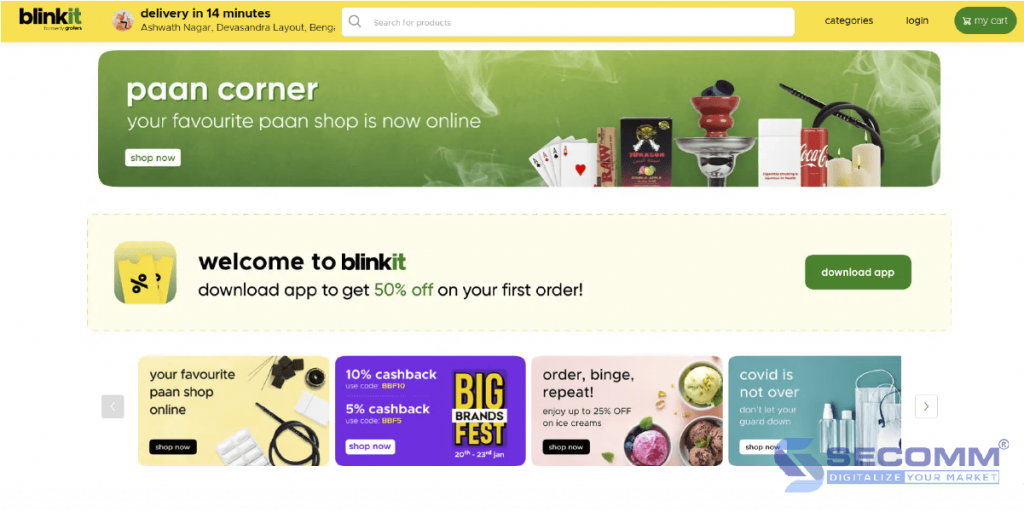
Initially, Grofers only specialized in supplying grocery products such as packaged food, bakery products, mother and baby care, pets, etc., to local grocery stores, medical, restaurants, or supermarkets. But thanks to the advancements in technology successfully applied in the e-commerce strategy, Blinkit has rapidly expanded its business successfully in 28 Indian cities.
On December 13, 2021, Grofers officially changed its brand name to Blinkit to deliver within 10 minutes. Like BigBasket, Blinkit also focuses on developing its logistics system and expanding its network of partner brands on its e-commerce website. Blinkit has more than 60 partners in New Delhi, more than 30 partners in Gurgaon, and many in Mumbai, Kolkata, Bengaluru, etc.
Bach Hoa Xanh – MWG’s strategic card in the eGrocery market
Bach Hoa Xanh is a mini supermarket chain selling fresh food and necessities under the Mobile World Joint Stock Company (MWG). Bach Hoa Xanh has nearly 2,000 stores across the South, East, and South Central provinces. According to iPrice, this website is in the top 5 most visited e-commerce websites in Vietnam, just behind four e-commerce platforms (Shopee, Lazada, Tiki, and Sendo).\

Since its establishment in 2015, Bach Hoa Xanh has advocated two key campaigns, competing with traditional markets and developing e-commerce websites. At first, Bach Hoa Xanh set up branches at selling points near the market, but in suburban areas and provinces, the space rental cost is much more affordable than in the central area. At the same time, the company creates a website system to boost online sales channels and draw in customers who enjoy making purchases online, particularly young people.
These days, the company has officially entered the Vietnamese retail “triad association” with Saigon Coop and WinMart (formerly VinMart), achieving a record of 26,300 billion VND in revenue in 2021 – an increase of 38% compared to the first 11 months of 2020.
Besides Bach Hoa Xanh, some other successful businesses have been applying grocery e-commerce, such as An Nam Market (specializing in serving foreign customers or former international students in Vietnam); Organica (focusing on offering customers from around the world ecologically friendly items), etc.
eGrocery is still in development and has not yet formally taken off. Thus the market’s growth potential is still tremendous despite the existence of several major companies. To confidently enter this lucrative market, grocery stores in Vietnam can use the lessons learned from their forebears and select a platform to construct a website system that fits the e-commerce business model.
Our company – SECOMM has been partnering with many big enterprises such as An Nam Group (Vietnam), Jasnor (Australia), and Changi Airport Group (Singapore). We are aware of the challenges and worries faced by firms while developing an e-commerce website system.
Get in touch with us now for FREE ecommerce consultancy and solutions in eGrocery businesses.
 2
2

 3,026
3,026

 0
0

 1
1





